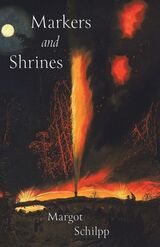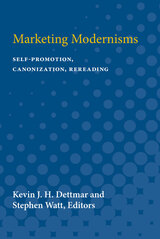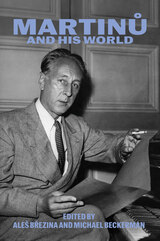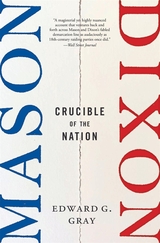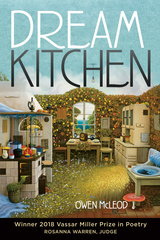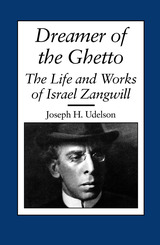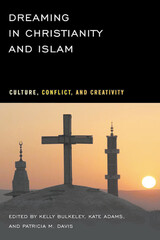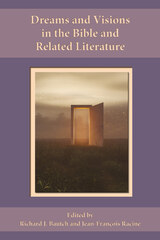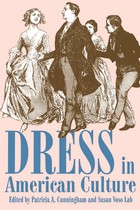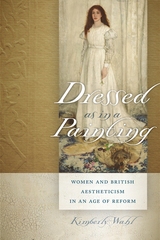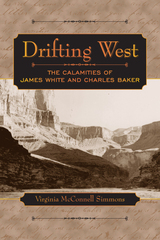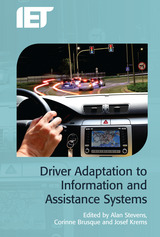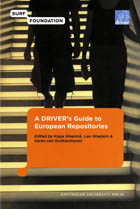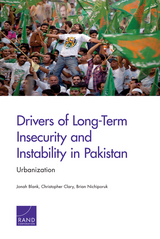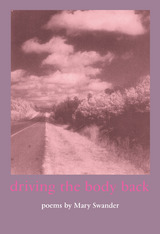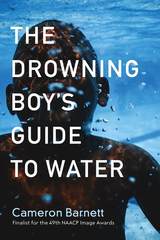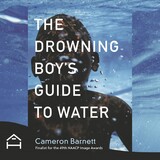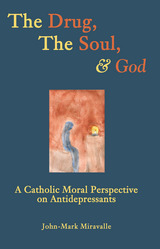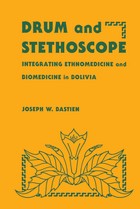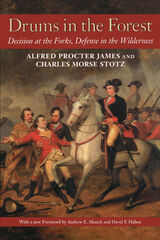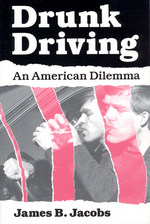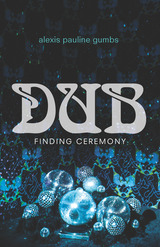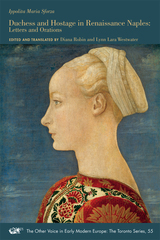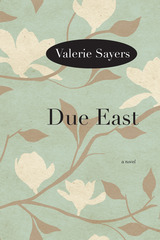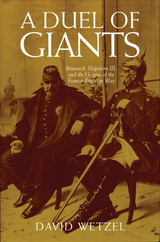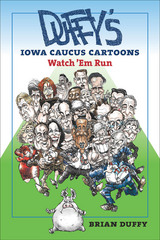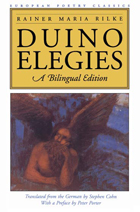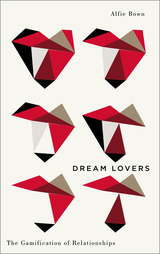 Dream Lovers: The Gamification of Relationships
Alfie Bown
Pluto Press, 2022 'An exciting, astute analysis of how our capacity for desire has been slotted into the grooves of digital capitalism, and made to work for profit - from porn to Pokémon' - Richard Seymour
We are in the middle of a 'desirevolution' - a fundamental and political transformation of the way we desire as human beings. Perhaps as always, new technologies - with their associated and inherited political biases - are organizing and mapping the future. What we don't seem to notice is that the primary way in which our lives are being transformed is through the manipulation and control of desire itself.
Our very impulses, drives and urges are 'gamified' to suit particular economic and political agendas, changing the way we relate to everything from lovers and friends to food and politicians. Digital technologies are transforming the subject at the deepest level of desire - re-mapping its libidinal economy - in ways never before imagined possible.
From sexbots to smart condoms, fitbits to VR simulators and AI to dating algorithms, the 'love industries' are at the heart of the future smart city and the social fabric of everyday life. This book considers these emergent technologies and what they mean for the future of love, desire, work and capitalism.
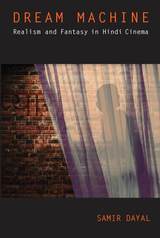 Dream Machine: Realism and Fantasy in Hindi Cinema
Samir Dayal
Temple University Press, 2015 Popular Hindi films offer varied cinematic representations ranging from realistic portraits of patriotic heroes to complex fantasies that go beyond escapism. In Dream Machine, Samir Dayal provides a history of Hindi cinema starting with films made after India’s independence in 1947. He constructs a decade-by-decade consideration of Hindi cinema’s role as a site for the construction of “Indianness.” Dayal suggests that Hindi cinema functions as both mirror and lamp, reflecting and illuminating new and possible representations of national and personal identity, beginning with early postcolonial films including Awaara and Mother India, a classic of the Golden Age. More recent films address critical social issues, such as My Name is Khan and Fire, which concern terrorism and sexuality, respectively. Dayalalso chronicles changes in the industry and in audience reception, and the influence of globalization, considering such films as Slumdog Millionaire. Dream Machine analyzes the social and aesthetic realism of these films concerning poverty and work, the emergence of the middle class, crime, violence, and the law while arguing for their sustained and critical attention to forms of fantasy.
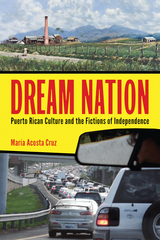 Dream Nation: Puerto Rican Culture and the Fictions of Independence
Acosta Cruz, María
Rutgers University Press, 2014 Over the past fifty years, Puerto Rican voters have roundly rejected any calls for national independence. Yet the rhetoric and iconography of independence have been defining features of Puerto Rican literature and culture. In the provocative new book Dream Nation, María Acosta Cruz investigates the roots and effects of this profound disconnect between cultural fantasy and political reality.
Bringing together texts from Puerto Rican literature, history, and popular culture, Dream Nation shows how imaginings of national independence have served many competing purposes. They have given authority to the island’s literary and artistic establishment but have also been a badge of countercultural cool. These ideas have been fueled both by nostalgia for an imagined past and by yearning for a better future. They have fostered local communities on the island, and still helped define Puerto Rican identity within U.S. Latino culture.
In clear, accessible prose, Acosta Cruz takes us on a journey from the 1898 annexation of Puerto Rico to the elections of 2012, stopping at many cultural touchstones along the way, from the canonical literature of the Generación del 30 to the rap music of Tego Calderón. Dream Nation thus serves both as a testament to how stories, symbols, and heroes of independence have inspired the Puerto Rican imagination and as an urgent warning about how this culture has become detached from the everyday concerns of the island’s people.
A volume in the American Literature Initiatives series
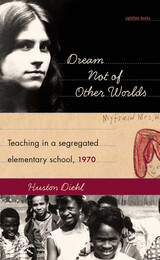 Dream Not of Other Worlds: Teaching in a Segregated Elementary School, 1970
Huston Diehl
University of Iowa Press, 2007 When Huston Diehl began teaching a fourth-grade class in a "Negro" elementary school in rural Louisa County, Virginia, the school's white superintendent assured her that he didn't expect her to teach "those children" anything. She soon discovered how these low expectations, widely shared by the white community, impeded her students' ability to learn. With its overcrowded classrooms, poorly trained teachers, empty bookshelves, and meager supplies, her segregated school was vastly inferior to the county's white elementary schools, and the message it sent her students was clear: "dream not of other worlds." In her often lyrical memoir, Diehl reveals how, in the intimacy of the classroom, her students reached out to her, a young white northerner, and shared their fears, anxieties, and personal beliefs. Repeatedly surprised and challenged by her students, Diehl questions her long-standing middle-class assumptions and confronts her own prejudices. In doing so, she eloquently reflects on what the students taught her about the hurt of bigotry and the humiliation of poverty as well as dignity, courage, and resiliency. Set in the waning days of the Jim Crow South, Dream Not of Other Worlds chronicles an important moment in American history. Diehl examines the history of black education in the South and narrates the dramatic struggle to integrate Virginia's public schools. Meeting with some of her former students and colleagues and visiting the school where she once taught, she considers what has—and has not—changed after more than thirty years of integrated schooling. This provocative book raises many issues that are of urgent concern today: the continuing social consequences of segregated schools, the role of public education in American society, and the challenges of educating minority and poor children.
 The Dream of a Common Movement: Selected Writings of Urvashi Vaid
Urvashi Vaid. Edited by Jyotsna Vaid and Amy Hoffman
Duke University Press, 2025 The Dream of a Common Movement collects essays, interviews, and speeches by the late feminist and civil rights activist Urvashi Vaid, whose pioneering writing and organizing over the course of four decades fundamentally shaped the LGBTQ+ movement. Vaid explores the LGBTQ+ movement’s impact on the AIDS epidemic and its challenges as it developed a national presence. She calls out movement leaders and donors for not addressing gender, race, and class issues and passionately argues that the goal of any liberation movement should be transformation, not assimilation. In personal essays, Vaid describes a double consciousness forged by the experience of immigration and a complicated relationship with her Indian-American and lesbian identities. Whether she was focused on the Donors of Color Network, the 22nd Century Initiative, the Lesbian Political Action Committee, or other initiatives she launched, Vaid was steadfast in her vision of a more just society and believed deeply in the power of people coming together to effect change. Offering a window into the breadth of her progressive vision for social change, this volume inspires readers to never stop organizing and marching.
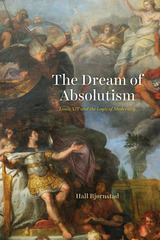 The Dream of Absolutism: Louis XIV and the Logic of Modernity
Hall Bjørnstad
University of Chicago Press, 2021 The Dream of Absolutism examines the political aesthetics of power under Louis XIV.
What was absolutism, and how did it work? What was the function of the ostentatious display surrounding Louis XIV at Versailles? What is gained—and what is lost—by approaching such expressions of absolutism as propaganda, as present-day scholars tend to do?
In this sweeping reconsideration of absolutist culture, Hall Bjørnstad argues that the exuberance of Louis XIV’s reign was not top-down propaganda in any modern sense, but rather a dream dreamt collectively, by king, court, image-makers, and nation alike. Bjørnstad explores this dream through a sustained close analysis of a corpus of absolutist artifacts, ranging from Charles Le Brun’s famous paintings in the Hall of Mirrors at Versailles via the king’s secret Mémoires to two little-known particularly extravagant verbal and textual celebrations of the king. The dream of absolutism, Bjørnstad concludes, lives at the intersection of politics and aesthetics. It is the carrier of a force that emerges as a glorious image; a participatory emotional reality that requires reality to conform to it. It is a dream, finally, that still shapes our collective political imaginary today.
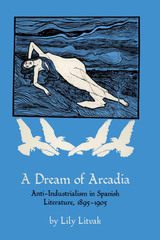 A Dream of Arcadia: Anti-Industrialism in Spanish LIterature, 1895–1905
By Lily Litvak
University of Texas Press, 1975 The dream of “progress” that animated many nineteenth-century artistic and political movements gave way at the turn of the century to a dissatisfaction with the Industrial Civilization and a recurrent pessimism about a future dominated by mechanization. Art Nouveau, which was both a style and a movement, embodied this dissatisfaction, marking the turn-of-the-century period with an aesthetic that consciously set out to revolutionize literature, the arts, and society within the framework of a brutalizing, wildly burgeoning Industrial Civilization. Generally associated with northern European culture, Art Nouveau also had a great impact in the south, particularly in Spain. A Dream of Arcadia is the first work to explore Spain’s fertile and imaginative Art Nouveau. Through the eyes of four major Spanish writers, Lily Litvak views several different aspects of the turn-of-the-century struggle against the advances of industrialism in Spain. Her interpretation of the early works of Ramón del Valle Inclán, Miguel de Unamuno, José Martínez Ruiz (Azorín), and Pío Baroja exposes a longing for a preindustrial arcadia based on a return to nature, the revival of handicrafts and medieval art, an attraction to rural primitive societies, and a revulsion against the modern city. Set against the European literary and artistic background of the period, her observations place the Spanish manifestations of Art Nouveau within the context of the better-known northern phenomena. Of particular interest is her discussion of the influences of John Ruskin, William Morris, and the Pre-Raphaelites, which demonstrates how the general European mood was articulated in Spain. Litvak concludes that Valle Inclán, Unamuno, Azorín, and Baroja must be considered as more than simply fin de siècle writers, for they became part of a general movement, generated by Art Nouveau, that spans an entire century. A Dream of Arcadia demonstrates that Art Nouveau was more than a flash on Europe's artistic horizon; it is a philosophy with ramifications that have led to communes, handcrafted articles, and nomadic adolescents in search of truth.
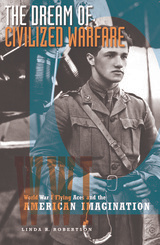 The Dream of Civilized Warfare: World War I Flying Aces and the American Imagination
Linda R. Robertson
University of Minnesota Press, 2005 Analyzes the link between “civilized warfare” and the American self-image Linda R. Robertson argues that the development of the United States as a global military power arose from the influence of an image of air combat carefully constructed during World War I to mask the sordid realities of modern ground warfare. The Dream of Civilized Warfare carries this trajectory to its logical end, tracing the long history of the American desire to exert the nation’s will throughout the world without having to risk the lives of ground soldiers—a theme that continues to reverberate in public discussions, media portrayals, and policy decisions today. Histories of American air power usually focus on World War II, when the air force became the foundation for the military strength of the United States. The equally fascinating story of World War I air combat is often relegated to a footnote, but it was the earlier war that first inspired the vision of the United States attaining dominance in world affairs through a massive air force. In The Dream of Civilized Warfare, Robertson presents the compelling story of the creation of the first American air force—and how, through the propaganda of the flying ace, a vision of “clean” or civilized combat was sold to politicians and the public. During World War I, air combat came to epitomize American ingenuity, technological superiority, adventure, leadership, and teamwork. Robertson reveals how the romantic and chivalric imagery associated with flying aces was a product of intentional propaganda and popular culture. Examining aviation history, military battles, films, literature, and political events, she looks at how the American public’s imagination was shaped—how flying aces offered not only a symbol of warfare in stark contrast to the muddy, brutal world of the trenches, but also a distraction to an American public resistant to both intervention in a European conflict and the new practice of conscription.
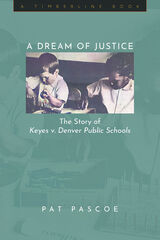 A Dream of Justice: The Story of Keyes v. Denver Public Schools
by Pat Pascoe
University Press of Colorado, 2023 A Dream of Justice is Colorado state senator and former teacher Pat Pascoe’s firsthand account of the decades-long fight to desegregate Denver’s public schools. Drawing on oral histories and interviews with members of the legal community, parents, and students, as well as extensive institutional records, Pascoe offers a compelling social history of Keyes v. School District No. 1 (Denver).
Pascoe details Denver’s desegregation battle, beginning with the citizen studies that exposed the inequities of segregated schools and Rachel Noel’s resolution to integrate the system, followed by the momentous pro-integration Benton-Pascoe campaign of Ed Benton and Monte Pascoe for the school board in 1969. When segregationists won that election and reversed the integration plan for northeast Denver, Black, white, and Latino parents filed Keyes v. School District No. 1. This book follows the arguments in the case through briefs, transcripts, and decisions from district court to the Supreme Court of the United States and back, to its ultimate order to desegregate all Denver schools “root and branch.” It was the first northern city desegregation suit to be brought before the Supreme Court. However, with the end of court-ordered busing in 1995, schools quickly resegregated and are now more segregated than before Keyes was filed.
Pascoe asserts that school integration is a necessary step toward eliminating systemic racism in our country and should be the objective of every school board. A Dream of Justice will appeal to students, scholars, and readers interested in the history of civil rights in America, Denver history, and the history of US education.
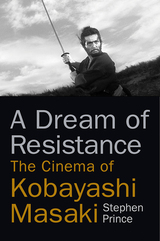 A Dream of Resistance: The Cinema of Kobayashi Masaki
Prince, Stephen
Rutgers University Press, 2017 Celebrated as one of Japan’s greatest filmmakers, Kobayashi Masaki’s scorching depictions of war and militarism marked him as a uniquely defiant voice in post-war Japanese cinema. A pacifist drafted into Japan’s Imperial Army, Kobayashi survived the war with his principles intact and created a body of work that was uncompromising in its critique of the nation’s military heritage. Yet his renowned political critiques were grounded in spiritual perspectives, integrating motifs and beliefs from both Buddhism and Christianity.
A Dream of Resistance is the first book in English to explore Kobayashi’s entire career, from the early films he made at Shochiku studio, to internationally-acclaimed masterpieces like The Human Condition, Harakiri, and Samurai Rebellion, and on to his final work for NHK Television. Closely examining how Kobayashi’s upbringing and intellectual history shaped the values of his work, Stephen Prince illuminates the political and religious dimensions of Kobayashi’s films, interpreting them as a prayer for peace in troubled times. Prince draws from a wealth of rare archives, including previously untranslated interviews, material that Kobayashi wrote about his films, and even the young director’s wartime diary. The result is an unprecedented portrait of this singular filmmaker.
 The Dream of the Great American Novel
Lawrence Buell
Harvard University Press, 2014 The idea of "the great American novel" continues to thrive almost as vigorously as in its nineteenth-century heyday, defying 150 years of attempts to dismiss it as amateurish or obsolete. In this landmark book, the first in many years to take in the whole sweep of national fiction, Lawrence Buell reanimates this supposedly antiquated idea, demonstrating that its history is a key to the dynamics of national literature and national identity itself.
The dream of the G.A.N., as Henry James nicknamed it, crystallized soon after the Civil War. In fresh, in-depth readings of selected contenders from the 1850s onward in conversation with hundreds of other novels, Buell delineates four "scripts" for G.A.N. candidates. One, illustrated by The Scarlet Letter, is the adaptation of the novel's story-line by later writers, often in ways that are contrary to the original author's own design. Other aspirants, including The Great Gatsby and Invisible Man, engage the American Dream of remarkable transformation from humble origins. A third script, seen in Uncle Tom's Cabin and Beloved, is the family saga that grapples with racial and other social divisions. Finally,mega-novels from Moby-Dick to Gravity's Rainbow feature assemblages of characters who dramatize in microcosm the promise and pitfalls of democracy.
The canvas of the great American novel is in constant motion, reflecting revolutions in fictional fashion, the changing face of authorship, and the inseparability of high culture from popular. As Buell reveals, the elusive G.A.N. showcases the myth of the United States as a nation perpetually under construction.
 Dream Play Build: Hands-On Community Engagement for Enduring Spaces and Places
James Rojas and John Kamp
Island Press, 2022 The room is dim, the chairs are in perfectly lined rows. The city planner puts up a color-coded diagram of the street improvement project, dreading the inevitable angry responses.
Jana loves her community and is glad to be able to attend the evening meeting, and she has a lot of ideas for community change. But she has a hard time hearing, and can’t see the diagrams clearly. She leaves early.
It’s time to imagine a different type of community engagement – one that inspires connection, creativity, and fun.
People love their communities and want them to become safer, healthier, more prosperous places. But the standard approach to public meetings somehow makes everyone miserable. Conversations that should be inspiring can become shouting matches. So what would it look like to facilitate truly meaningful discussions between citizens and planners? What if they could be fun?
For twenty years, James Rojas and John Kamp have been looking to art, creative expression, and storytelling to shake up the classic community meeting. In Dream Play Build, they share their insights into building common ground and inviting active participation among diverse groups. Their approach, “Place It!,” draws on three methods: the interactive model-building workshop, the pop-up, and site exploration using our senses. Using our hands to build and create is central to what makes us human, helping spark ideas without relying on words to communicate. Deceptively playful, this method is remarkably effective at teasing out community dreams and desires from hands-on activities. Dream Play Build offers wisdom distilled from workshops held around the world, and a deep dive into the transformational approach and results from the South Colton community in southern California. While much of the process was developed through in-person meetings, the book also translates the experience to online engagement--how to make people remember their connections beyond the computer screen.
Inspirational and fun, Dream Play Build celebrates the value of engaging with the dreams we have for our communities. Readers will find themselves weaving these artful, playful lessons and methods into their own efforts for making change within the landscape around them.
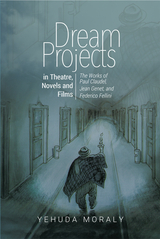 Dream Projects in Theatre, Novels and Films: The Works of Paul Claudel, Jean Genet, and Federico Fellini
Yehuda Moraly
Sussex Academic Press, 2022 Every artist has a "dream project" an enterprise that he or she has continuously taken up but never completed. Via archived notes and drafts, a retrospective reconstitution of such projects can serve as a key for better understanding the author's artistic corpus. The present study reaches out to the authorship of Paul Claudel, Jean Genet, and Federico Fellini. Claudel deferred and never completed the fourth segment of his Trilogie des Coufontaine. Like the unfinished fourth section that was to be added to the trilogy, the draft of the third version of Tete d'Or reveals a dialogue between the Old and New Testaments a theme that appears to be central to Claudel's entire corpus. Genet labored over La Mort for many years. While the project never came to fruition, it nevertheless remains an important means through which to understand Genet's work. The aborted production of Fellini's Voyage de G. Mastorna has become a legend. Fellini would often revisit this project, but never completed it. This book also examines additional "dream projects" taken from different art forms: poetry (Mallarme's Le Livre); literature (Vigny's Daphne); painting (Monet's Nympheas); music (Schoenberg's Moses und Aron); and various films (Clouzot's L'Enfer, Visconti's La Recherche, Kubrick's Napoleon, etc.).
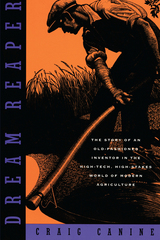 Dream Reaper: The Story of an Old-Fashioned Inventor in the High-Tech, High-Stakes World of Modern Agriculture
Craig Canine
University of Chicago Press, 1997 Dream Reaper follows Mark Underwood, farmer and inventor, and his salesman cousin as they strive to perfect and market Mark's breakthrough invention, the Bi-Rotor combine.
"This intriguing tale weaves together the creativity and ingenuity of an inventor and the hurdles he and his partner face in selling and producing what appears to be an amazingly efficient Bi-Rotor combine."—Science News
"Canine writes with style and flourish. . . Dream Reaper is a riveting journey into America's heartland, where necessity is the mother of invention—and hard work, conviction, and sacrifice are its lifeblood."—People Magazine
"Canine deftly interweaves the story of the two men's struggles with a history of the mechanization of agriculture. This lively account of men working under pressure, improvising repairs and demonstrating the new machine, is also a story of courage that illustrates the barriers facing an independent inventor."—Publishers Weekly
"Craig Canine's Dream Reaper is a delight. It's an important book, rich with history and stories. It brings our most essential industry—farming—into new perspective. Reading it made me want to get out a crop."—Bobbie Ann Mason
A volume in the Sloan Technology Series. The series presents to a general audience highly readable accounts of the development of 20th century technologies and the ways these have shaped and are shaped by society.
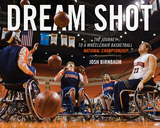 Dream Shot: The Journey to a Wheelchair Basketball National Championship
Josh Birnbaum
University of Illinois Press, 2017 In 2008, the men's wheelchair basketball team at the University of Illinois set out to achieve their sport's pinnacle: a college national championship. That lofty goal represented another stage of a journey begun in 1948 when Tim Nugent established the Gizz Kids wheelchair squad. Embedded with the team, Josh Birnbaum took photos that captured the life experiences of people in the Illinois wheelchair basketball program from 2005 through the 2008 championship season. Dream Shot follows the unique lives of the players and coaches on the court and the road, and in quiet moments at home and the classroom. Along the way, Birnbaum provides the definitive story of the 2008 team and the challenges it overcame to capture one of Illinois's record fifteen men's titles. Featuring more than 100 color photographs, Dream Shot memorializes a legendary team alongside the story of the university's dedication to the progress of disability rights.
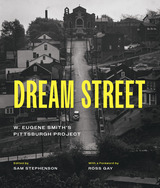 Dream Street: W. Eugene Smith's Pittsburgh Project
W. Eugene Smith
University of Chicago Press, 2023 New edition of poignant selected images from famed Life photographer W. Eugene Smith’s Pittsburgh project.
In 1955, having just resigned from his high-profile but stormy career with Life Magazine, W. Eugene Smith was commissioned to spend three weeks in Pittsburgh and produce one hundred photographs for noted journalist and author Stefan Lorant’s book commemorating the city’s bicentennial. Smith ended up staying a year, compiling twenty thousand images for what would be the most ambitious photographic essay of his life. But only a fragment of this work was ever seen, despite Smith's lifelong conviction that it was his greatest collection of photographs.
In 2001, Sam Stephenson published for the first time an assemblage of the core images from this project, selections that Smith asserted were the “synthesis of the whole,” presenting not only a portrayal of Pittsburgh but of postwar America. This new edition, updated with a foreword by the poet Ross Gay, offers a fresh vision of Smith's masterpiece.
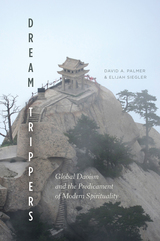 Dream Trippers: Global Daoism and the Predicament of Modern Spirituality
David A. Palmer and Elijah Siegler
University of Chicago Press, 2017 Over the past few decades, Daoism has become a recognizable part of Western “alternative” spiritual life. Now, that Westernized version of Daoism is going full circle, traveling back from America and Europe to influence Daoism in China.
Dream Trippers draws on more than a decade of ethnographic work with Daoist monks and Western seekers to trace the spread of Westernized Daoism in contemporary China. David A. Palmer and Elijah Siegler take us into the daily life of the monastic community atop the mountain of Huashan and explore its relationship to the socialist state. They follow the international circuit of Daoist "energy tourism," which connects a number of sites throughout China, and examine the controversies around Western scholars who become practitioners and promoters of Daoism. Throughout are lively portrayals of encounters among the book’s various characters—Chinese hermits and monks, Western seekers, and scholar-practitioners—as they interact with each other in obtuse, often humorous, and yet sometimes enlightening and transformative ways. Dream Trippers untangles the anxieties, confusions, and ambiguities that arise as Chinese and American practitioners balance cosmological attunement and radical spiritual individualism in their search for authenticity in a globalized world.
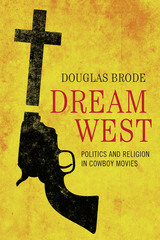 Dream West: Politics and Religion in Cowboy Movies
By Douglas Brode
University of Texas Press, 2013 While political liberals celebrated the end of “cowboy politics” with the election of Barack Obama to the presidency, political conservatives in the Tea Party and other like-minded groups still vociferously support “cowboy” values such as small government, low taxes, free-market capitalism, and the right to bear arms. Yet, as Douglas Brode argues in this paradigm-shifting book, these supposedly cowboy or “Old West” values hail not so much from the actual American frontier of the nineteenth century as from Hollywood’s portrayal of it in the twentieth century. And a close reading of Western films and TV shows reveals a much more complex picture than the romanticized, simplistic vision espoused by the conservative right. Examining dozens of Westerns, including Gunfight at the O.K. Corral, Red River, 3:10 to Yuma (old and new), The Wild Ones, High Noon, My Darling Clementine, The Alamo, and No Country for Old Men, Brode demonstrates that the genre (with notable exceptions that he fully covers) was the product of Hollywood liberals who used it to project a progressive agenda on issues such as gun control, environmental protection, respect for non-Christian belief systems, and community cohesion versus rugged individualism. Challenging us to rethink everything we thought we knew about the genre, Brode argues that the Western stands for precisely the opposite of what most people today—whether they love it or hate it—believe to be the essential premise of “the only truly, authentically, and uniquely American narrative form.”
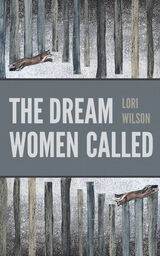 The Dream Women Called
Lori Wilson
Autumn House Press, 2021 Through the poems in The Dream Women Called, Lori Wilson attends to the spirits of depression, uncertainty, and fear while wondering at the beauty in what’s broken, the remarkable in the ordinary, and the balm that the natural world can offer. Following a single speaker, we’re reminded how many lives one woman can live.
This book is about crossing into a new version of your own story—after a marriage ends, the parents die, the children are grown, or the faith is discarded—and finding a place to stand, a new way to take up space in the world. Uniting past and present, these poems create multifaceted portraits, particularly of relationships between mothers and daughters. Wilson’s poems sift through memory, dreams, art, imagination, nature, and close observation, turning each discovery over in order to see it fully. Beneath the fine-grained imagery of these lyric excavations are the sometimes opposing but fundamental desires to be whole and to be seen, which often means looking within as well as turning toward the world outside. The speaker is listening always for the dream women who call, for whatever may beckon from the present and future, preparing her in some way for a life that’s truly hers.
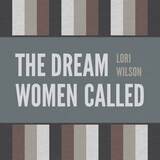 The Dream Women Called
Lori Wilson
Autumn House Press, 2021 Through the poems in The Dream Women Called, Lori Wilson attends to the spirits of depression, uncertainty, and fear while wondering at the beauty in what’s broken, the remarkable in the ordinary, and the balm that the natural world can offer. Following a single speaker, we’re reminded how many lives one woman can live.
This book is about crossing into a new version of your own story—after a marriage ends, the parents die, the children are grown, or the faith is discarded—and finding a place to stand, a new way to take up space in the world. Uniting past and present, these poems create multifaceted portraits, particularly of relationships between mothers and daughters. Wilson’s poems sift through memory, dreams, art, imagination, nature, and close observation, turning each discovery over in order to see it fully. Beneath the fine-grained imagery of these lyric excavations are the sometimes opposing but fundamental desires to be whole and to be seen, which often means looking within as well as turning toward the world outside. The speaker is listening always for the dream women who call, for whatever may beckon from the present and future, preparing her in some way for a life that’s truly hers.
Dream Zones: Anticipating Capitalism and Development in India
Jamie Cross
Pluto Press, 2014 Dream Zones explores the dreamed of and desired futures that constitute, sustain and disrupt capitalism in contemporary India.
Drawing on five years of research in and around India's Special Economic Zones (SEZs), the book follows the stories of regional politicians, corporate executives, rural farmers, industrial workers and social activists to show how the pursuit of growth, profit and development shapes the politics of industrialisation and liberalisation.
This book offers a timely reminder that the global economy is shaped by sentiment as much as reason and that un-realised expectations are the grounds on which new hopes for the future are sown.
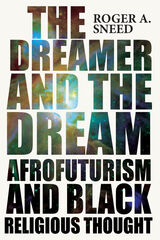 The Dreamer and the Dream: Afrofuturism and Black Religious Thought
Roger A. Sneed
Ohio State University Press, 2021 Finalist for the American Academy of Religion’s Award for Excellence in the Study of Religion, Constructive-Reflexive Studies
In The Dreamer and the Dream: Afrofuturism and Black Religious Thought, Roger A. Sneed illuminates the interplay of Black religious thought with science fiction narratives to present a bold case for Afrofuturism as an important channel for Black spirituality. In the process, he challenges the assumed primacy of the Black church as the arbiter of Black religious life. Incorporating analyses of Octavia Butler’s Parable books, Janelle Monáe’s Afrofuturistic saga, Star Trek’s Captain Benjamin Sisko, Marvel’s Black Panther, and Sun Ra and the Nation of Islam, Sneed demonstrates how Afrofuturism has contributed to Black visions of the future. He also investigates how Afrofuturism has influenced religious scholarship that looks to Black cultural production as a means of reimagining Blackness in the light of the sacred. The result is an expansive new look at the power of science fiction and Afrofuturism to center the diversity of Black spirituality.
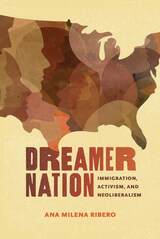 Dreamer Nation: Immigration, Activism, and Neoliberalism
Ana Milena Ribero
University of Alabama Press, 2023 Illustrates how the Dreamer community was created rhetorically—in the discourse, messages, actions, and visual representations of undocumented youth
Dreamer Nation tells the story of how Dreamers in the Obama era creatively confronted a complex sociopolitical landscape to advocate for immigrant rights and empower undocumented youth to proudly represent their lives and identities, all while under the ever-present threat of detention and deportation. Contributing to rhetorical studies of social movements, immigration, and minoritized rhetorics, Ribero argues that even though Dreamer rhetorics were reflective of the discursive limits of the neoliberal milieu, they also worked to disrupt neoliberal constraints through activism that troubled the primacy of the nation-state and citizenship, refused to adhere to respectability politics, forwarded embodied identity and transnational belonging, and looked for liberation in community—not solely in legislative action.
Each chapter presents a different rhetorical situation within the US “crisis” of immigration and the rhetoric that Dreamers used to respond to it. Organized chronologically, the chapters document Dreamer activism during the Obama presidency, from the 2010 hunger strikes advocating for the DREAM Act to undocuqueer “artivism” responding to Trump’s presidential campaign. The author draws not only on the methods and theories of rhetorical studies but also on women of color feminisms, ethnic studies, critical theory, and queer theory. In this way, the book looks across disciplines to illustrate the rhetorical savvy of one of the most important US social movements of our time.
Dreamer of the Ghetto: The Life and Works of Israel Zangwill
Joseph H. Udelson
University of Alabama Press, 1990 "An impressive achievement. . . . Udelson provides a trenchant analysis of Zangwill's works set within a historical context, i.e., Jewish emancipation and the dilemma of how one might remain fully Jewish while becoming fully modern, that helps to illuminate Zangwill's life as well as his writings."
—Jewish Book News
"By carefully following the threads of Zangwill's own divided self through the labyrinths of his life and writings, Udelson convinces us not only of the author's startling political prescience, but that he embodies attitudes now shared by almost all secular Jews as a result of events Zangwill did not witness—Nazism and the founding of Israel."
—Shofar
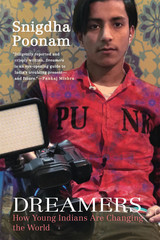 Dreamers: How Young Indians Are Changing the World
Snigdha Poonam
Harvard University Press, 2018 What do India’s millennials want and how are they transforming one of the youngest, most populous nations in the world?
More than half of India is under the age of twenty-five, but India’s millennials are nothing like their counterparts in the West. In a country that is increasingly characterized by ambition and crushing limitations, this is a generation that cannot—and will not—be defined on anything but their own terms. They are wealth-chasers, hucksters, and fame-hunters, desperate to escape their narrow prospects. They are the dreamers.
Award-winning journalist Snigdha Poonam traveled through the small towns of northern India to investigate the phenomenon that is India’s Generation Y. From dubious entrepreneurs to political aspirants, from starstruck strivers to masterly swindlers, these are the clickbaiters who create viral content for Facebook and the internet scammers who stalk you at home, but they are also defiant student union leaders determined to transform campus life. Poonam made her way—on carts and buses, in cars and trucks—through India’s badlands to uncover a theater of toxic masculinity, a spirited brew of ambition, and a hunger for change that is bound to drive the future of the country.
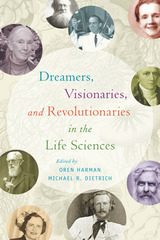 Dreamers, Visionaries, and Revolutionaries in the Life Sciences
Edited by Oren Harman and Michael R. Dietrich
University of Chicago Press, 2018 What are the conditions that foster true novelty and allow visionaries to set their eyes on unknown horizons? What have been the challenges that have spawned new innovations, and how have they shaped modern biology? In Dreamers, Visionaries, and Revolutionaries in the Life Sciences, editors Oren Harman and Michael R. Dietrich explore these questions through the lives of eighteen exemplary biologists who had grand and often radical ideas that went far beyond the run-of-the-mill science of their peers.
From the Frenchman Jean-Baptiste Lamarck, who coined the word “biology” in the early nineteenth century, to the American James Lovelock, for whom the Earth is a living, breathing organism, these dreamers innovated in ways that forced their contemporaries to reexamine comfortable truths. With this collection readers will follow Jane Goodall into the hidden world of apes in African jungles and Francis Crick as he attacks the problem of consciousness. Join Mary Lasker on her campaign to conquer cancer and follow geneticist George Church as he dreams of bringing back woolly mammoths and Neanderthals. In these lives and the many others featured in these pages, we discover visions that were sometimes fantastical, quixotic, and even threatening and destabilizing, but always a challenge to the status quo.
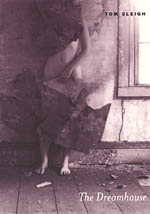 The Dreamhouse
Tom Sleigh
University of Chicago Press, 1999 In The Dreamhouse, Tom Sleigh's poetry is a medium for both revelation and linguistic invention. The meditative clarity of Sleigh's poems, his ability to range between the plain and high style with complete naturalness of intonation, and the varying and always surprising musical effects he accomplishes in each poem display his unequaled flair for innovation that is never willful or forced but which always works to forward the poems' emotional and intellectual resonances. The Dreamhouse marks Sleigh as one of the most inventive and provocative poets of his generation.
Praise for Tom Sleigh:
"Through sheer artistry, Tom Sleigh manages to write . . . in a transcendent way, and without appeal to the metaphysical assumptions transcendence usually requires. The Chain . . . floods darkness with brilliant craft."—Gray Jacobik, Boston Globe
"Tom Sleigh's second book of poems, Waking, is so fine one can hardly do justice to it in a review. . . . Sleigh is nearly as prodigal with his gifts as Yeats."—Liz Rosenberg, New York Times Book Review
 Dreaming a Paradise: Migrations and the Story of Buland Masjid
Chitvan Gill
Seagull Books, 2023 The story of the people of Buland Masjid, a community of migrants in Delhi.
In Dreaming a Paradise, Chitvan Gill draws on years of research and photographic reportage to unveil the tales of individuals driven to escape poverty, violence, and despair in search of happiness and a place to call home. At the heart of this book lies Buland Masjid, an unauthorized colony on the Yamuna riverbank in Delhi, India, which thrives with restless industry even under the unyielding grip of poverty. The women and men of this colony recycle scrap, repair machines, manufacture clothes, run schools, and sell delicious food, breathing new energy into a once-desolate economy. However, beneath the surface lies a tale of urban planning gone awry, reflecting the comprehensive failure of those in power. Delving into the lives of those cast aside and walled off from India’s vast wealth, this book highlights the huge divide between modern India’s haves and have-nots, and the inherent contradictions in a nation grappling with its identity.
In a compelling exploration of humanity’s journey, Dreaming a Paradise reveals the triumphs, tragedies, hopes, and hardships of resilient souls seeking their own patch of heaven amidst chaos. From the eternal cycles of loss and discovery, we witness the formation of civilizations and the timeless yearning that defines the human condition.
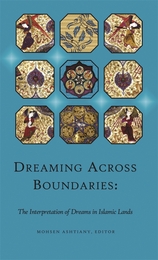 Dreaming Across Boundaries: The Interpretation of Dreams in Islamic Lands
L. Marlow
Harvard University Press, 2008 Descriptions of dreams abound in the literatures of the Near East and North Africa. The Prophet Muhammad endowed them with a theological dimension, saying that after him “true dreams” would be the only channel for prophecy. Dreams were often used to support conflicting theological and political arguments, and the local chronicles contain many accounts of royal dreams justifying the advent of new dynasties.
This volume explores the context of these theological speculations and political aspirations through the medium of dreams to present fascinating insights into the social history of the pre-modern Islamic world in all its cultural diversity. Wider cultural exchanges are discussed through concrete examples such as the Arabic version of the Aristotelian treatise De divinatione per somnum. Some of the current scholarly assumptions about dreams being merely stylized expressions of social conventions are challenged by personal reports that express individual personalities, self-awareness, and spiritual development.
This is the first volume of the Ilex Series on Themes and Traditions. The series explores cross-cultural constructs without losing sight of the rich texture of local variations of traditions or beliefs.
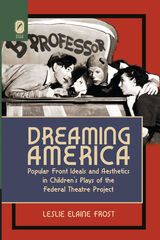 Dreaming America: Popular Front Ideals and Aesthetics in Children's Plays of the Federal Theatre Project
Leslie Elaine Frost
Ohio State University Press, 2013 Dreaming America: Popular Front Ideals and Aesthetics in Children’s Plays of the Federal Theatre Project by Leslie Elaine Frost traces how the tumultuous politics of the late 1930s shaped the stories and staging of federally funded plays for children. Indeed, children’s theater was central to the Federal Theatre Project’s vision of building a national theater. Frost argues that representations of the child and childhood in the FTP children’s plays stage the hopes and anxieties of a nation destabilized by both economic collapse and technological advances. A declining economy and the first stagnant birthrate in three centuries yoked the national economy to the individual family. Profound disagreements over appropriate models of education and parenting, as well as over issues of ethnicity and class, constituted fundamental arguments over democratic values and social norms. Frost locates these plays within the immediate context of the production materials in the FTP archives, as well as within the broader culture of the Great Depression, drawing on disparate primary materials—from parenting magazines to strike literature to political journals—and referencing a range of popular events—from the Joe Louis/Max Schmeling fights to Hollywood movies. As the focus of Depression-era adult anxieties and hopes and as the embodiment of vigor, dynamism, and growth, children carried symbolic value both as the future of America and as the America of the future. Frost examines representative plays’ connections to other media, culture, and politics to situate their singular trajectories in the social history of the Federal Theatre Project and Popular Front culture.
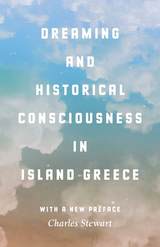 Dreaming and Historical Consciousness in Island Greece
Charles Stewart
University of Chicago Press, 2017 On publication in 2012, Dreaming and Historical Consciousness in Island Greece quickly met wide acclaim as a gripping work that, according to the Times Literary Supplement, “offers a wholly new way of thinking about dreams in their social contexts.” It tells an extraordinary story of spiritual fervor, prophecy, and the ghosts of the distant past coming alive in the present. This new affordable paperback brings it to the wider audience that it deserves.
Charles Stewart tells the story of the inhabitants of Kóronos, on the Greek island of Naxos, who, in the 1830s, began experiencing dreams in which the Virgin Mary instructed them to search for buried Christian icons nearby and build a church to house the ones they found. Miraculously, they dug and found several icons and human remains, and at night the ancient owners of them would speak to them in dreams. The inhabitants built the church and in the years since have experienced further waves of dreams and startling prophesies that shaped their understanding of the past and future and often put them at odds with state authorities. Today, Kóronos is the site of one of the largest annual pilgrimages in the Mediterranean. Telling this fascinating story, Stewart draws on his long-term fieldwork and original historical sources to explore dreaming as a mediator of historical change, while widening the understanding of historical consciousness and history itself.
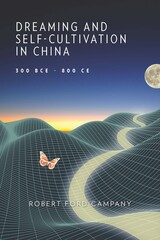 Dreaming and Self-Cultivation in China, 300 BCE–800 CE
Robert Ford Campany
Harvard University Press, 2023 Practitioners of any of the paths of self-cultivation available in ancient and medieval China engaged daily in practices meant to bring their bodies and minds under firm control. They took on regimens to discipline their comportment, speech, breathing, diet, senses, desires, sexuality, even their dreams. Yet, compared with waking life, dreams are incongruous, unpredictable—in a word, strange. How, then, did these regimes of self-fashioning grapple with dreaming, a lawless yet ubiquitous domain of individual experience?
In Dreaming and Self-Cultivation in China, 300 BCE–800 CE, Robert Ford Campany examines how dreaming was addressed in texts produced and circulated by practitioners of Daoist, Buddhist, Confucian, and other self-cultivational disciplines. Working through a wide range of scriptures, essays, treatises, biographies, commentaries, fictive dialogues, diary records, interpretive keys, and ritual instructions, Campany uncovers a set of discrete paradigms by which dreams were viewed and responded to by practitioners. He shows how these paradigms underlay texts of diverse religious and ideological persuasions that are usually treated in mutual isolation. The result is a provocative meditation on the relationship between individuals’ nocturnal experiences and one culture’s persistent attempts to discipline, interpret, and incorporate them into waking practice.
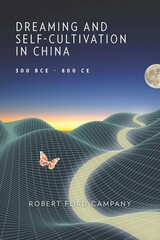 Dreaming and Self-Cultivation in China, 300 BCE–800 CE
Robert Ford Campany
Harvard University Press, 2023 Practitioners of any of the paths of self-cultivation available in ancient and medieval China engaged daily in practices meant to bring their bodies and minds under firm control. They took on regimens to discipline their comportment, speech, breathing, diet, senses, desires, sexuality, even their dreams. Yet, compared with waking life, dreams are incongruous, unpredictable—in a word, strange. How, then, did these regimes of self-fashioning grapple with dreaming, a lawless yet ubiquitous domain of individual experience?
In Dreaming and Self-Cultivation in China, 300 BCE–800 CE, Robert Ford Campany examines how dreaming was addressed in texts produced and circulated by practitioners of Daoist, Buddhist, Confucian, and other self-cultivational disciplines. Working through a wide range of scriptures, essays, treatises, biographies, commentaries, fictive dialogues, diary records, interpretive keys, and ritual instructions, Campany uncovers a set of discrete paradigms by which dreams were viewed and responded to by practitioners. He shows how these paradigms underlay texts of diverse religious and ideological persuasions that are usually treated in mutual isolation. The result is a provocative meditation on the relationship between individuals’ nocturnal experiences and one culture’s persistent attempts to discipline, interpret, and incorporate them into waking practice.
 Dreaming Down the Track: Awakenings in Aboriginal Cinema
William Lempert
University of Minnesota Press, 2025 What can Aboriginal filmmaking reveal about Indigenous presence and futures? The product of years of embedded fieldwork within Indigenous film crews in Northwestern Australia, Dreaming Down the Track delves deeply into Aboriginal cinema as a transformative community process. It follows the social lives of projects throughout their production cycles, from planning and editing to screening, broadcasting, and after-images. Across its narrative sweep, this ethnography engages the film career of Kukatja elder Mark Moora to demonstrate the impact of filmmaking on how Aboriginal futures are collectively imagined and called forth. William Lempert highlights a series of awakenings through which Moora ultimately came to view cinema as a process for catalyzing his family’s return to their home country of Mangkayi. This biographical media journey paints an intimate portrait of the inspiring possibilities and sobering limitations of Indigenous envisioning within settler states. Lempert traces how Moora’s life and films convey a multiplicity of Aboriginal experiences across time and space, from colonial contact to contemporary life in communities like Balgo, including the continued governmental attempts to undermine them. Amid ongoing negotiations to establish the first treaties between Indigenous nations and Australian states, Dreaming Down the Track illustrates what is at stake in how Aboriginal–State relations are represented and understood, both within communities and for the broader public. Lempert stays true to Moora’s insight that film can preserve community stories for generations to come, toward the aim of enacting sovereign futures.
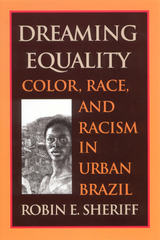 Dreaming Equality: Color, Race, and Racism in Urban Brazil
Sheriff, Robin E.
Rutgers University Press, 2001 In the 1933 publication The Masters and the Slaves, Brazilian scholar and novelist Gilberto Freyre challenged the racist ideas of his day by defending the “African contribution” to Brazil’s culture. In so doing, he proposed that Brazil was relatively free of most forms of racial prejudice and could best be understood as a “racial democracy.” Over time this view has grown into the popular myth that racism in Brazil is very mild or nonexistent.
This myth contrasts starkly with the realities of a pernicious racial inequality that permeates every aspect of Brazilian life. To study the grip of this myth on African Brazilians’ views of themselves and their nation, Robin E. Sheriff spent twenty months in a primarily black shantytown in Rio de Janeiro, studying the inhabitants’s views of race and racism. How, she asks, do poor African Brazilians experience and interpret racism in a country where its very existence tends to be publicly denied? How is racism talked about privately in the family and publicly in the community—or is it talked about at all?
Sheriff’s analysis is particularly important because most Brazilians live in urban settings, and her examination of their views of race and racism sheds light on common but underarticulated racial attitudes. This book is the first to demonstrate that urban African Brazilians do not subscribe to the racial democracy myth and recognize racism as a central factor shaping their lives.
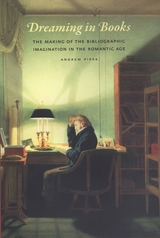 Dreaming in Books: The Making of the Bibliographic Imagination in the Romantic Age
Andrew Piper
University of Chicago Press, 2009 At the turn of the nineteenth century, publishing houses in London, New York, Paris, Stuttgart, and Berlin produced books in ever greater numbers. But it was not just the advent of mass printing that created the era’s “bookish” culture. According to Andrew Piper, romantic writing and romantic writers played a crucial role in adjusting readers to this increasingly international and overflowing literary environment. Learning how to use and to want books occurred through more than the technological, commercial, or legal conditions that made the growing proliferation of books possible; the making of such bibliographic fantasies was importantly a product of the symbolic operations contained within books as well. Examining novels, critical editions, gift books, translations, and illustrated books, as well as the communities who made them, Dreaming in Books tells a wide-ranging story of the book’s identity at the turn of the nineteenth century. In so doing, it shows how many of the most pressing modern communicative concerns are not unique to the digital age but emerged with a particular sense of urgency during the bookish upheavals of the romantic era. In revisiting the book’s rise through the prism of romantic literature, Piper aims to revise our assumptions about romanticism, the medium of the printed book, and, ultimately, the future of the book in our so-called digital age.
Dreaming in Christianity and Islam: Culture, Conflict, and Creativity
Edited and with an Introduction by Kelly Bulkeley, Kate Adams, and Patricia M. Davis
Rutgers University Press, 2009 Throughout history to the present day, religion has ideologically fueled wars, conquests, and persecutions. Christianity and Islam, the world's largest and geopolitically powerful faiths, are often positioned as mortal enemies locked in an apocalyptic "clash of civilizations." Rarely are similarities addressed. Dreaming in Christianity and Islam, the first book to explore dreaming in these religions through original essays, fills this void. The editors reach a plateau by focusing on how studying dreams reveals new aspects of social and political reality. International scholars document the impact of dreams on sacred texts, mystical experiences, therapeutic practices, and doctrinal controversies.
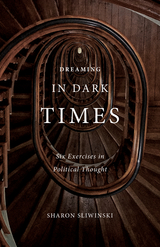 Dreaming in Dark Times: Six Exercises in Political Thought
Sharon Sliwinski
University of Minnesota Press, 2017 What do dreams manage to say—or indeed, show—about human experience that is not legible otherwise? Can the disclosure of our dream-life be understood as a form of political avowal? To what does a dream attest? And to whom? Blending psychoanalytic theory with the work of such political thinkers as Hannah Arendt and Michel Foucault, Sharon Sliwinski explores how the disclosure of dream-life represents a special kind of communicative gesture—a form of unconscious thinking that can serve as a potent brand of political intervention and a means for resisting sovereign power. Each chapter centers on a specific dream plucked from the historical record, slowly unwinding the significance of this extraordinary disclosure. From Wilfred Owen and Lee Miller to Frantz Fanon and Nelson Mandela, Sliwinski shows how each of these figures grappled with dream-life as a means to conjure up the courage to speak about dark times. Here dreaming is defined as an integral political exercise—a vehicle for otherwise unthinkable thoughts and a wellspring for the freedom of expression. Dreaming in Dark Times defends the idea that dream-life matters—that attending to this thought-landscape is vital to the life of the individual but also vital to our shared social and political worlds.
 Dreaming in Ensemble: How Black Artists Transformed American Opera
Lucy Caplan
Harvard University Press, 2025 A revelatory new account of Black innovation in American opera, showing how composers, performers, and critics redefined the genre both aesthetically and politically in the early twentieth century.
The inauguration of a “golden age” in Black opera is often dated to 1955, when Marian Anderson became the first Black singer to perform in a leading role at New York’s Metropolitan Opera. Yet Anderson’s debut was actually preceded by a rich Black operatic tradition that developed in the first half of the twentieth century. Lucy Caplan tells the stories of the Black composers, performers, critics, teachers, and students who created this vibrant opera culture, even as they were excluded from the genre’s most prominent institutions. Their movement, which flourished alongside the Harlem Renaissance, redefined opera as a wellspring of aesthetic innovation, sociality, and antiracist activism.
Caplan argues that Black opera in the early twentieth century had decidedly countercultural ambitions. In opera’s sonic grandeur and dramatic maximalism, artists found creative resources for expressing the complexity of Black life. The protagonists of this story include composers Harry Lawrence Freeman and Shirley Graham, whose operas boldly interpreted Black diasporic history; performers Caterina Jarboro and Florence Cole-Talbert, who both starred in the racially fraught role of Aida; and critics Sylvester Russell and Nora Holt, who wrote imaginatively about the genre in the Black press. Yet Caplan also focuses on the many Black students, amateurs, opera house staff, and listeners who contributed indelibly to opera’s meanings.
With the creation of new companies, choruses, and audiences, opera not only circulated in the Black public sphere but itself became a public sphere with radical potential.
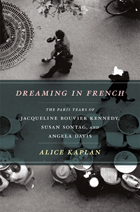 Dreaming in French: The Paris Years of Jacqueline Bouvier Kennedy, Susan Sontag, and Angela Davis
Alice Kaplan
University of Chicago Press, 2012 A year in Paris . . . since World War II, countless American students have been lured by that vision—and been transformed by their sojourn in the City of Light. Dreaming in French tells three stories of that experience, and how it changed the lives of three extraordinary American women.
All three women would go on to become icons, key figures in American cultural, intellectual, and political life, but when they embarked for France, they were young, little-known, uncertain about their future, and drawn to the culture, sophistication, and drama that only Paris could offer. Yet their backgrounds and their dreams couldn’t have been more different. Jacqueline Bouvier was a twenty-year-old debutante, a Catholic girl from a wealthy East Coast family. Susan Sontag was twenty-four, a precocious Jewish intellectual from a North Hollywood family of modest means, and Paris was a refuge from motherhood, a failing marriage, and graduate work in philosophy at Oxford. Angela Davis, a French major at Brandeis from a prominent African American family in Birmingham, Alabama, found herself the only black student in her year abroad program—in a summer when all the news from Birmingham was of unprecedented racial violence.
Kaplan takes readers into the lives, hopes, and ambitions of these young women, tracing their paths to Paris and tracking the discoveries, intellectual adventures, friendships, and loves that they found there. For all three women, France was far from a passing fancy; rather, Kaplan shows, the year abroad continued to influence them, a significant part of their intellectual and cultural makeup, for the rest of their lives. Jackie Kennedy carried her love of France to the White House and to her later career as a book editor, bringing her cultural and linguistic fluency to everything from art and diplomacy to fashion and historic restoration—to the extent that many, including Jackie herself, worried that she might seem “too French.” Sontag found in France a model for the life of the mind that she was determined to lead; the intellectual world she observed from afar during that first year in Paris inspired her most important work and remained a key influence—to be grappled with, explored, and transcended—the rest of her life. Davis, meanwhile, found that her Parisian vantage strengthened her sense of political exile from racism at home and brought a sense of solidarity with Algerian independence. For her, Paris was a city of political commitment, activism, and militancy, qualities that would deeply inform her own revolutionary agenda and soon make her a hero to the French writers she had once studied.
Kaplan, whose own junior year abroad played a prominent role in her classic memoir, French Lessons, spins these three quite different stories into one evocative biography, brimming with the ferment and yearnings of youth and shot through with the knowledge of how a single year—and a magical city—can change a whole life. No one who has ever dreamed of Paris should miss it.
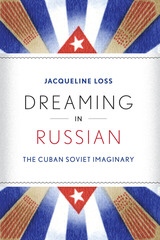 Dreaming in Russian: The Cuban Soviet Imaginary
By Jacqueline Loss
University of Texas Press, 2013 The specter of the Soviet Union lingers in Cuba, yet until now there has been no book-length work on the ways Cubans process their country’s relationship with the Soviet bloc. Dreaming in Russian at last brings into the light the reality that for nearly three decades, the Soviet Union subsidized the island economically, intervened in military matters, and exported distinct pedagogical and cultural models to Cuba. Drawing on interviews with Cuban artists and intellectuals, as well as treasures from cinematographic and bibliographic archives, Jacqueline Loss delivers the first book to show that Cuba remembers and retains many aspects of the Soviet era, far from shedding those cultural facets as relics of the Cold War. Weaving together intriguing, seldom-seen images, Dreaming in Russian showcases the ways in which Cuba’s relationship to its Soviet benefactors lingered after the disintegration of the U.S.S.R. in 1991. Analyzing numerous literary texts and works of visual art, Loss also incorporates aspects of architecture, popular culture, the space race, and other strands to create a captivating new perspective on Cuban society. Among the luminaries featured are poet Reina María Rodríguez, writer Antonio José Ponte, visual artist Tonel, and novelist Wendy Guerra. A departure from traditional cultural history, Loss’s approach instead presents a kaleidoscopic series of facets, reflecting the hybrid nature of the self-images that emerged in the aftermath of the Soviet aegis. As speculations about Cuba’s future under Fidel Castro’s heir apparent continue, the portrait that emerges in Dreaming in Russian is both timely and mesmerizing.
 Dreaming of a Mail-Order Husband: Russian-American Internet Romance
Ericka Johnson
Duke University Press, 2007 In the American media, Russian mail-order brides are often portrayed either as docile victims or as gold diggers in search of money and green cards. Rarely are they allowed to speak for themselves. Until now. In Dreaming of a Mail-Order Husband, six Russian women who are in search of or have already found U.S. husbands via listings on the Internet tell their stories. Ericka Johnson, an American researcher of gender and technology, interviewed these women and others. The women, in their twenties and thirties, describe how they placed listings on the Internet and what they think about their contacts with Western men. They discuss their expectations about marriage in the United States and their reasons for wishing to emigrate. Their differing backgrounds, economic situations, and educational levels belie homogeneous characterizations of Russian mail-order brides. Each chapter presents one woman’s story and then links it to a discussion of gender roles, the mail-order bride industry, and the severe economic and social constraints of life in Russia. The transitional economy has often left people, after a month’s work, either unpaid or paid unexpectedly with a supply of sunflower oil or toilet paper. Women over twenty-three are considered virtually unmarriageable in Russian society. Russia has a large population of women who are single, divorced, or widowed, who would like to be married yet feel that they have no chance finding a Russian husband. Grim realities such as these motivate women to seek better lives abroad. For many of those seeking a mail-order husband, children or parents play significant roles in the search for better lives, and they play a role in Johnson’s account as well. In addition to her research in the former Soviet Union, Johnson conducted interviews in the United States, and she shares the insights—about dating, marriage, and cross-cultural communication—of a Russian-American married couple who met via the Internet.
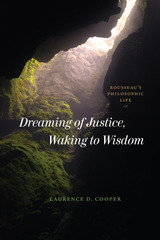 Dreaming of Justice, Waking to Wisdom: Rousseau's Philosophic Life
Laurence D. Cooper
University of Chicago Press, 2023 A surprising look at how Rousseau defended the philosophic life as the most natural and best of lives.
Dreaming of Justice, Waking to Wisdom reveals what could be thought of as the capstone of Rousseau’s thought, even if that capstone has been nearly invisible to readers. Despite criticizing philosophy for its corrosive effects on both natural goodness and civic virtue, Rousseau, argues Laurence D. Cooper, held the philosophic life as an ideal. Cooper expertly unpacks Rousseau’s vivid depiction of the philosophic life and the case for that life as the most natural, the freest, or, in short, the best or most choice-worthy of lives. Cooper focuses especially on a single feature, arguably the defining feature of the philosophic life: the overcoming of the ordinary moral consciousness in favor of the cognitivist view of morality. Cooper shows that Rousseau, with his particular understanding and embrace of the philosophic life, proves to be a kind of latter-day Socratic. Thorough and thought-provoking, Dreaming of Justice, Waking to Wisdom provides vital insight into Rousseau.
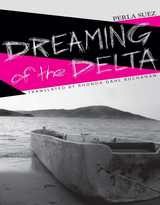 Dreaming of the Delta
Perla Suez
Texas Tech University Press, 2014 A blend of fiction and drama, in which nothing is certain
With Dreaming of the Delta, Perla Suez joins the ranks of other prominent Argentine writers who have incorporated the horrors of the violent period of the Proceso de Reorganización Nacional. Highly experimental, this novel is a tale of secrecy, betrayal, and violence that reflects on a personal scale the national struggle for power and control at the height of the dictatorship of 1976 to 1983. And though violence takes center stage, it is played out in a private drama that unfolds in a mansion on the shores of the Paraná River in the province of Entre Ríos. Like the timeless river itself, Suez’s words ebb and flow across the pages, leaving in their wake volatile voids that suggest to the reader that what is not disclosed is as powerful as what is revealed. With a skeletal prose that blurs the line between novel, theater, and film, Suez condenses decades of cruelty and longing into a few brief hours.
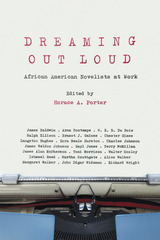 Dreaming Out Loud: African American Novelists at Work
Horace Porter
University of Iowa Press, 2015 Dreaming Out Loud brings together essays by many of the most well-known and respected African American writers of the twentieth and twenty-first centuries, discussing various aspects of the vocation, craft, and art of writing fiction. Though many of the writers included here are also accomplished poets, essayists, and playwrights, this collection and the essays it contains remains focused on the novel as a genre and an art form.
Some essays explore the challenges of being an African American writer in the United States, broadly addressing aesthetic and racial prejudice in American publishing and literature and its changing face over the decades. Others are more specific and personal, recounting how the authors came to be a reader and writer in a culture that did not always encourage them to do so. Some are more general and focus on practice and craft, while still other essays offer detailed behind-the-scenes accounts of how famous novels, such as Native Son, Invisible Man, The Autobiography of Miss Jane Pittman, and The Color Purple, came to life. Ranging from the Harlem Renaissance, through the Civil Rights movement, and into the twenty-first century, this anthology explores what it has meant to be an African American novelist over the past hundred years.
Found within are essays by twenty-one African American novelists, including Nobel Prize-winner Toni Morrison, National Book Award-winners Ralph Ellison and Charles Johnson, Pulitzer Prize-winners Alice Walker and James Alan McPherson, and well-known canonical writers such as W. E. B. Du Bois, James Weldon Johnson, Langston Hughes, Richard Wright, Zora Neale Hurston, and Margaret Walker. Dreaming Out Loud seeks to inspire writers and readers alike, while offering a fascinating and important portrait of novelists at work in their own words.
CONTRIBUTORS
James Baldwin, Arna Bontemps, W. E. B. Du Bois, Ralph Ellison, Ernest Gaines, Chester Himes, Langston Hughes, Zora Neale Hurston, Charles Johnson, James Weldon Johnson, Gayl Jones, Terry McMillan, James Alan McPherson, Toni Morrison, Walter Mosley, Ishmael Reed, Martha Southgate, Alice Walker, Margaret Walker, John Edgar Wideman, Richard Wright
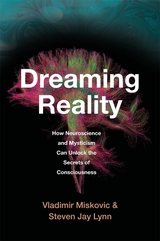 Dreaming Reality: How Neuroscience and Mysticism Can Unlock the Secrets of Consciousness
Vladimir Miskovic and Steven Jay Lynn
Harvard University Press, 2024 A cutting-edge neuroscientist and a leading clinical psychologist look to religious, mystical, and mind-altering experience to challenge scientific orthodoxies concerning consciousness.
We are nothing but a pack of neurons, Francis Crick once said. Vladimir Miskovic and Steven Jay Lynn show that this way of thinking is both limited and an obstacle to understanding consciousness. In Dreaming Reality, Miskovic and Lynn connect the latest findings from neuroscience—which studies the brain from the outside in, as a purely physical object—to the insights of the world’s mystical traditions, which chart elaborate cartographies of the mind from inside out through experiences of meditation, prayer, and ecstasy. We can tackle the biggest questions surrounding the nature of consciousness when we place objective scientific research alongside the phenomenology of “altered” states.
Dreaming Reality offers a rich synthesis of brains and minds, new and old, that challenges many cherished notions of how we experience our worlds and selves. Instead of privileging the experience of waking life, Miskovic and Lynn take this only as the starting point of a progressive disentanglement of consciousness. Delving into Buddhism, Vedanta, and Christian mysticism, they find that we have much to learn from dreams, hallucinations, visionary states, ego death, mind wandering, sensory deprivation, psychedelic experimentation, meditation, and minimal phenomenal experiences of consciousness.
Each chapter brings us closer to understanding how we dream reality into existence and how we might transcend impoverished materialist models, whose unacknowledged effect is to drive us toward nihilism. Instead, we arrive at a model of consciousness that is more capacious and compassionate than biological sciences alone can imagine.
Dreaming Revolution: Transgression in the Development of American Romance
Scott Bradfield
University of Iowa Press, 1993 Dreaming Revolution usefully employs current critical theory to address how the European novel of class revolt was transformed into the American novel of imperial expansion. Bradfield shows that early American romantic fiction—including works by William Godwin, Charles Brockden Brown, James Fenimore Cooper, and Edgar Allan Poe—can and should be considered as part of a genre too often limited to the nineteenth-century European novel. In a spirited discussion of the works from these four authors, Bradfield argues that Americans take the class dynamics of the European psychological novel and apply them to the American landscape, reimagining psychological spaces as geographical ones.
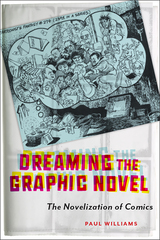 Dreaming the Graphic Novel: The Novelization of Comics
Paul Williams
Rutgers University Press, 2020 Winner of the Best Book Award in Comics History from the Grand Comics Database
Honorable Mention, 2019-2020 Research Society for American Periodicals Book Prize
The term “graphic novel” was first coined in 1964, but it wouldn’t be broadly used until the 1980s, when graphic novels such as Watchmen and Maus achieved commercial success and critical acclaim. What happened in the intervening years, after the graphic novel was conceptualized yet before it was widely recognized?
Dreaming the Graphic Novel examines how notions of the graphic novel began to coalesce in the 1970s, a time of great change for American comics, with declining sales of mainstream periodicals, the arrival of specialty comics stores, and (at least initially) a thriving underground comix scene. Surveying the eclectic array of long comics narratives that emerged from this fertile period, Paul Williams investigates many texts that have fallen out of graphic novel history. As he demonstrates, the question of what makes a text a ‘graphic novel’ was the subject of fierce debate among fans, creators, and publishers, inspiring arguments about the literariness of comics that are still taking place among scholars today.
Unearthing a treasure trove of fanzines, adverts, and unpublished letters, Dreaming the Graphic Novel gives readers an exciting inside look at a pivotal moment in the art form’s development.
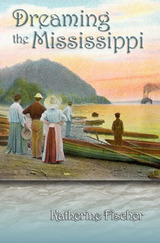 Dreaming the Mississippi
Katherine Fischer
University of Missouri Press, 2006
Offering a fresh perspective on the river’s environment, industry, and recreation, Dreaming the Mississippi challenges old stereotypes through the experiences of modern Americans who work the barges, rope-swing into muddy bottoms, struggle against hurricane floodwaters, and otherwise find new meaning on this great watery corridor. In an engaging voice, earnest and energetic, Katherine Fischer describes how the river’s natural and human histories overlap and interweave as she tells of her own gradual immersion in its life—which led her to buy a house so close to its banks that each spring she must open her basement doors to accept its inevitable floods.
Fischer blends stories of people living along the river with accounts of national and global consequence. She weaves humorous accounts of river rats and towboat pilots with stories of sandbagging against a flood tide that refuses to be contained. She tells of river hangouts—“joints” that literally join segments of humanity along the river—as she revels in the colorful clientele of her favorite waterfront taverns. Some chapters connect the wildness of this mythical river to outside regions such as the Great Salt Lake and Florida, taking the lure of the mighty Mississippi as far as Japan. Another chapter, about the river’s mouth, “Gulf,” considers the gulf between engineers and naturalists—and between America’s haves and have-nots—as it offers heartfelt reflections on Katrina’s wrath.
Through compelling words and photographs, Dreaming the Mississippi invites readers to taste life on today’s Mississippi, as sweet, tangy, and wildly cantankerous as it gets. In conveying her understanding of contemporary life along the river’s length, Katherine Fischer has much to teach us not only about reverence for this glorious American waterway but also about our eternal connections to the natural world.
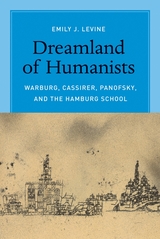 Dreamland of Humanists: Warburg, Cassirer, Panofsky, and the Hamburg School
Emily J. Levine
University of Chicago Press, 2013 Deemed by Heinrich Heine a city of merchants where poets go to die, Hamburg was an improbable setting for a major intellectual movement. Yet it was there, at the end of World War I, at a new university in this commercial center, that a trio of twentieth-century pioneers in the humanities emerged. Working side by side, Aby Warburg, Ernst Cassirer, and Erwin Panofsky developed new avenues in art history, cultural history, and philosophy, changing the course of cultural and intellectual history in Weimar Germany and throughout the world.
In Dreamland of Humanists, Emily J. Levine considers not just these men, but the historical significance of the time and place where their ideas took form. Shedding light on the origins of their work on the Renaissance and the Enlightenment, Levine clarifies the social, political, and economic pressures faced by German-Jewish scholars on the periphery of Germany’s intellectual world. By examining the role that context plays in our analysis of ideas, Levine confirms that great ideas—like great intellectuals—must come from somewhere.
Dreams
Percy Goldthwait Stiles
Harvard University Press
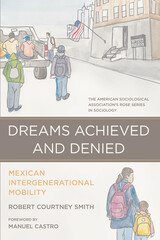 Dreams Achieved and Denied: Mexican Intergenerational Mobility
Robert Courtney Smith
Russell Sage Foundation, 2024 U.S.-born Mexicans in New York City have achieved perhaps the biggest single generation jump in mobility in American immigration history. In 2020, 42-percent of second-generation U.S.-born Mexican men and 49-percent of U.S.-born Mexican women in New York City had graduated from college – versus a 13-14-percent second-generation college graduation rate for most places for most studies done in recent decades. How did U.S.-born Mexicans in New York City achieve such remarkable mobility? In Dreams Achieved and Denied, sociologist Robert Courtney Smith examines the laws, policies, and individual and family practices that promoted – and inhibited – their social mobility.
For over twenty years, Smith followed the lives and mobility of nearly one hundred children of Mexican immigrants in New York City. Smith’s longitudinal, ethnographic data enabled him to intimately describe how specific mechanisms blocked or promoted mobility for years as his participants moved from adolescence through early adulthood and into established adulthood. Smith documents how having or gaining legal status made certain New York City or New York State policies and practices more efficacious in supporting individual and family efforts and strategies for mobility. Such immigrant-inclusive and mobility-promoting measures include enabling undocumented people to attend public colleges at in-state tuition rates, and later to get driver’s licenses, offering healthcare to all in New York City, and the City’s subway and school choice systems, which enabled students to attend better schools or take opportunities outside their neighborhoods.
Smith finds that keeping the immigrant bargain – whereby children of immigrants redeem their parents’ sacrifice by doing well in school, helping their parents and siblings, and becoming “good” people (in their parents’ words) – helped them towards better adult outcomes and lives. Having mentors, picking academically stronger schools and friends, and using second chance mechanisms also promoted more adult mobility. However, lacking legal status blocked mobility, by preventing them from benefiting from these same mobility-promoting city and state policies, from mentors, or from working hard and keeping the immigrant bargain.
Dreams Achieved and Denied deeply analyzes the historic upward mobility of U.S.-born Mexicans in New York City. Itcounters the dominant story research and public discourse tell about Mexican mobility in the U.S. and shows how thoughtful public policy can improve the lives of young immigrants and families.
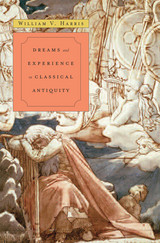 Dreams and Experience in Classical Antiquity
William V. Harris
Harvard University Press, 2009 From the Iliad to Aristophanes, from the gospel of Matthew to Augustine, Greek and Latin texts are constellated with descriptive images of dreams. Some are formulaic, others intensely vivid. The best ancient minds—Plato, Aristotle, the physician Galen, and others—struggled to understand the meaning of dreams.
With Dreams and Experience in Classical Antiquity the renowned ancient historian William Harris turns his attention to oneiric matters. This cultural history of dreams in antiquity draws on both contemporary post-Freudian science and careful critiques of the ancient texts. Harris traces the history of characteristic forms of dream-description and relates them both to the ancient experience of dreaming and to literary and religious imperatives. He analyzes the nuances of Greek and Roman belief in the truth-telling potential of dreams, and in a final chapter offers an assessment of ancient attempts to understand dreams naturalistically.
How did dreaming culture evolve from Homer’s time to late antiquity? What did these dreams signify? And how do we read and understand ancient dreams through modern eyes? Harris takes an elusive subject and writes about it with rigor and precision, reminding us of specificities, contexts, and changing attitudes through history.
Dreams and Visions in the Bible and Related Literature
Richard J. Bautch
SBL Press, 2023 The essays in Dreams and Visions in the Bible and Related Literature focus on how the reading community interprets dreams or visions and what is at stake for whom in a dream or vision’s interpretation. Contributors explore the hermeneutics of readership, the relationship between reading and intertextuality, and the interplay of affect and emotion within dreams and visions in religious texts. A variety of methodologies are employed, including rhetorical analysis, critical theory, trauma studies, the analysis of space and society, and the history of emotions. Contributors are Richard J. Bautch, Genevive Dibley, Roy Fisher, Gina Hens-Piazza, Joseph McDonald, Deborah Prince, Jean-François Racine, Andrea Spatafora, and Rodney A. Werline.
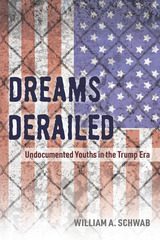 Dreams Derailed: Undocumented Youths in the Trump Era
William A. Schwab
University of Arkansas Press, 2018 During the 2016 presidential campaign millions of voters, concerned about the economic impact of illegal immigration, rallied behind the notion of a border wall between the United States and Mexico. Well into the Trump presidency, immigration endures as a hotly contested issue in United States politics. In Dreams Derailed sociologist William A. Schwab shares the stories of immigration reform advocates and follows up on stories told in his 2013 book Right to DREAM, which argued in favor of the DREAM Act that would have provided conditional residency for undocumented youth brought to the United States as children, a version of which was later enacted by executive order and referred to as DACA (Deferred Action for Childhood Arrivals). Taking as its focal point the Trump administration’s decision to rescind Obama-era DACA protection, Dreams Derailed delves into the economic, political, and social factors that inform the public conversation about immigration, making a clear case for the many benefits of inclusive policies and the protection of undocumented youths. Schwab also takes a close look at the factors that carried Donald Trump to the White House, demonstrates how economic upheaval and the issue of immigration influenced the 2016 presidential election, analyzes current immigration laws, and suggests next steps for reform.
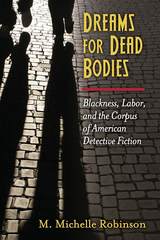 Dreams for Dead Bodies: Blackness, Labor, and the Corpus of American Detective Fiction
M. Michelle Robinson
University of Michigan Press, 2016 Dreams for Dead Bodies: Blackness, Labor, and the Corpus of American Detective Fiction offers new arguments about the origins of detective fiction in the United States, tracing the lineage of the genre back to unexpected texts and uncovering how authors such as Edgar Allan Poe, Mark Twain, Pauline Hopkins, and Rudolph Fisher made use of the genre’s puzzle-elements to explore the shifting dynamics of race and labor in America.
The author constructs an interracial genealogy of detective fiction to create a nuanced picture of the ways that black and white authors appropriated and cultivated literary conventions that coalesced in a recognizable genre at the turn of the twentieth century. These authors tinkered with detective fiction’s puzzle-elements to address a variety of historical contexts, including the exigencies of chattel slavery, the erosion of working-class solidarities by racial and ethnic competition, and accelerated mass production. Dreams for Dead Bodies demonstrates that nineteenth- and early twentieth-century American literature was broadly engaged with detective fiction, and that authors rehearsed and refined its formal elements in literary works typically relegated to the margins of the genre. By looking at these margins, the book argues, we can better understand the origins and cultural functions of American detective fiction.
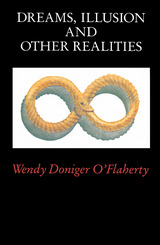 Dreams, Illusion, and Other Realities
Wendy Doniger O'Flaherty
University of Chicago Press, 1984 "Wendy Doniger O'Flaherty . . . weaves a brilliant analysis of the complex role of dreams and dreaming in Indian religion, philosophy, literature, and art. . . . In her creative hands, enchanting Indian myths and stories illuminate and are illuminated by authors as different as Aeschylus, Plato, Freud, Jung, Kurl Gödel, Thomas Kuhn, Borges, Picasso, Sir Ernst Gombrich, and many others. This richly suggestive book challenges many of our fundamental assumptions about ourselves and our world."—Mark C. Taylor, New York Times Book Review
"Dazzling analysis. . . . The book is firm and convincing once you appreciate its central point, which is that in traditional Hindu thought the dream isn't an accident or byway of experience, but rather the locus of epistemology. In its willful confusion of categories, its teasing readiness to blur the line between the imagined and the real, the dream actually embodies the whole problem of knowledge. . . . [O'Flaherty] wants to make your mental flesh creep, and she succeeds."—Mark Caldwell, Village Voice
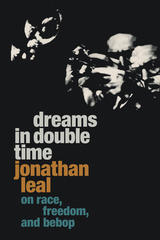 Dreams in Double Time: On Race, Freedom, and Bebop
Jonathan Leal
Duke University Press, 2023 In Dreams in Double Time Jonathan Leal examines how the musical revolution of bebop opened up new futures for racialized and minoritized communities. Blending lyrical nonfiction with transdisciplinary critique and moving beyond standard Black/white binary narratives of jazz history, Leal focuses on the stories and experiences of three musicians and writers of color: James Araki, a Nisei multi-instrumentalist, soldier-translator, and literature and folklore scholar; Raúl Salinas, a Chicano poet, jazz critic, and longtime activist who endured the US carceral system for over a decade; and Harold Wing, an Afro-Chinese American drummer, pianist, and songwriter who performed with bebop pioneers before working as a public servant. Leal foregrounds that for these men and their collaborators, bebop was an affectively and intellectually powerful force that helped them build community and dream new social possibilities. Bebop’s complexity and radicality, Leal contends, made it possible for those like Araki, Salinas, and Wing who grappled daily with state-sanctioned violence to challenge a racially supremacist, imperial nation, all while hearing and making the world anew.
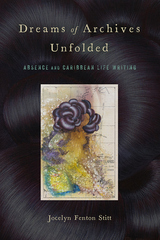 Dreams of Archives Unfolded: Absence and Caribbean Life Writing
Jocelyn Fenton Stitt
Rutgers University Press, 2021 The first book on pan-Caribbean life writing, Dreams of Archives Unfolded reveals the innovative formal practices used to write about historical absences within contemporary personal narratives. Although the premier genres of writing postcoloniality in the Caribbean have been understood to be fiction and poetry, established figures such as Erna Brodber, Maryse Condé, Lorna Goodison, Edwidge Danticat, Saidiya Hartmann, Ruth Behar, and Dionne Brand and emerging writers such as Yvonne Shorter Brown, and Gaiutra Bahadur use life writing to question the relationship between the past and the present. Stitt theorizes that the remarkable flowering of life writing by Caribbean women since 2000 is not an imitation of the “memoir boom” in North America and Europe; instead, it marks a different use of the genre born out of encountering gendered absences in archives and ancestral memory that cannot be filled with more research. Dreams of Archives makes a significant contribution to studies of Caribbean literature by demonstrating that women’s autobiographical narratives published in the past twenty years are feminist epistemological projects that rework Caribbean studies’ longstanding commitment to creating counter-archives.
 Dreams of Difference, Songs of the Same: The Musical Moment in Film
Amy Herzog
University of Minnesota Press, 2009 Musical spectacles are excessive and abstract, reconfiguring time and space and creating intense bodily responses. Amy Herzog's engaging work examines those instances where music and movement erupt from within more linear narrative frameworks. The representational strategies found in these films are often formulaic, repeating familiar story lines and stereotypical depictions of race, gender, and class. Yet she finds the musical moment contains a powerful disruptive potential. Dreams of Difference, Songs of the Same investigates the tension and the fusion of difference and repetition in films to ask, How does the musical moment work? Herzog looks at an eclectic mix of works, including the Soundie and Scopitone jukebox films, the musicals of French director Jacques Demy, the synchronized swimming spectacles of Esther Williams, and an apocalyptic musical by Taiwanese director Tsai Ming-liang. Several refrains circulate among these texts: their reliance on clichés, their rewriting of cultural narratives, and their hallucinatory treatment of memory and history. Drawing on the philosophical work of Gilles Deleuze, she explores all of these dissonances as productive forces, and in doing so demonstrates the transformative power of the unexpected.
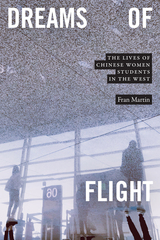 Dreams of Flight: The Lives of Chinese Women Students in the West
Fran Martin
Duke University Press, 2022 In Dreams of Flight, Fran Martin explores how young Chinese women negotiate competing pressures on their identity while studying abroad. On one hand, unmarried middle-class women in the single-child generations are encouraged to develop themselves as professional human capital through international education, molding themselves into independent, cosmopolitan, career-oriented individuals. On the other, strong neotraditionalist state, social, and familial pressures of the post-Mao era push them back toward marriage and family by age thirty. Martin examines these women’s motivations for studying in Australia and traces their embodied and emotional experiences of urban life, social media worlds, work in low-skilled and professional jobs, romantic relationships, religion, Chinese patriotism, and changed self-understanding after study abroad. Martin illustrates how emerging forms of gender, class, and mobility fundamentally transform the basis of identity for a whole generation of Chinese women.
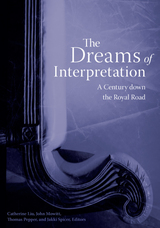 The Dreams of Interpretation: A Century down the Royal Road
Catherine Liu
University of Minnesota Press, 2007 Rethinking the importance of Sigmund Freud’s landmark book The Interpretation of Dreams a century after its publication in 1900, this work brings together psychoanalysts, philosophers, cultural theorists, film and visual theorists, and literary critics from several continents in a compilation of the best clinical and theoretical work being done in psychoanalysis today. It is unique in convening both theory and practice in productive dialogue, reflecting on the encounter between psychoanalysis and the tradition of hermeneutics. Collectively the essays argue that Freud’s legacy has shaped the way we think about not only psychology and the nature of the self but also our understanding of politics, culture, and even thought itself. Contributors: Willy Apollon, Gifric; Karyn Ball, U of Alberta, Edmonton; Raymond Bellour, Centre National de la Recherche Scientifique; Patricia Gherovici, Philadelphia Lacan Study Group and Seminar; Judith Feher-Gurewich, New York U; Jonathan Kahana, New York U; A. Kiarina Kordela, Macalester College; Pablo Kovalovsky, Clinica de Borde; Jean Laplanche, U of Lausanne; Laura Marcus, U of Sussex; Andrew McNamara, Queensland U of Technology; Claire Nahon; Yun Peng, U of Minnesota; Gerard Pommier, Nantes U; Jean-Michel Rabaté, Princeton U; Laurence A. Rickels, U of California, Santa Barbara; Avital Ronell, New York U; Elke Siegel, Yale U; Rei Terada, U of California, Irvine; Klaus Theweleit, U of Freiburg-im-Breisgau; Paul Verhaege, U of Ghent, Belgium; Silke-Maria Weineck, U of Michigan. Catherine Liu is associate professor of comparative literature and film and media studies at the University of California, Irvine. John Mowitt is professor and chair of cultural studies and comparative literature at the University of Minnesota. Thomas Pepper is associate professor of cultural studies and comparative literature at the University of Minnesota. Jakki Spicer received her Ph.D. in cultural studies and comparative literature from the University of Minnesota.
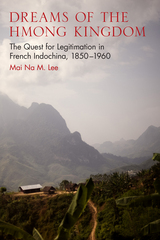 Dreams of the Hmong Kingdom: The Quest for Legitimation in French Indochina, 1850–1960
Mai Na M. Lee
University of Wisconsin Press, 2015 Countering notions that Hmong history begins and ends with the “Secret War” in Laos of the 1960s and 1970s, Dreams of the Hmong Kingdom reveals how the Hmong experience of modernity is grounded in their sense of their own ancient past, when this now-stateless people had their own king and kingdom, and illuminates their political choices over the course of a century in a highly contested region of Asia.
In China, Vietnam, and Laos, the Hmong continuously negotiated with these states and with the French to maintain political autonomy in a world of shifting boundaries, emerging nation-states, and contentious nationalist movements and ideologies. Often divided by clan rivalries, the Hmong placed their hope in finding a leader who could unify them and recover their sovereignty. In a compelling analysis of Hmong society and leadership throughout the French colonial period, Mai Na M. Lee identifies two kinds of leaders—political brokers who allied strategically with Southeast Asian governments and with the French, and messianic resistance leaders who claimed the Mandate of Heaven. The continuous rise and fall of such leaders led to cycles of collaboration and rebellion. After World War II, the powerful Hmong Ly clan and their allies sided with the French and the new monarchy in Laos, but the rival Hmong Lo clan and their supporters allied with Communist coalitions.
Lee argues that the leadership struggles between Hmong clans destabilized French rule and hastened its demise. Martialing an impressive array of oral interviews conducted in the United States, France, and Southeast Asia, augmented with French archival documents, she demonstrates how, at the margins of empire, minorities such as the Hmong sway the direction of history.
Best books for public & secondary school libraries from university presses, American Library Association
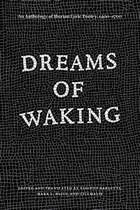 Dreams of Waking: An Anthology of Iberian Lyric Poetry, 1400-1700
Edited and Translated by Vincent Barletta, Mark L. Bajus, and Cici Malik
University of Chicago Press, 2013 In this anthology, Vincent Barletta, Mark L. Bajus, and Cici Malik treat the Iberian lyric in the late Middle Ages and early modernity as a deeply multilingual, transnational genre that needs to break away from the old essentialist ideas about language, geography, and identity in order to be understood properly. More and more, scholars and students are recognizing the limitations of single-language, nationalist, and period-bound canons and are looking for different ways to approach the study of literature. The Iberian Peninsula is an excellent site for this approach, where the history and politics of the region, along with its creative literature, need to be read and studied together with the way the works were composed by poets and eventually consumed by readers. With a generous selection of more than one hundred poems from thirty-three poets, Dreams of Waking is unique in its coverage of the three main languages—Catalan, Portuguese, and Spanish—and lyrical styles employed by peninsular poets. It contains new translations of canonical poems but also translations of many poems that have never before been edited or translated. Brief headnotes provide essential details of the poets’ lives, and a general introduction by the volume editors shows how the poems and languages fruitfully intersect. With helpful annotations to the poetry, as well as a selected bibliography containing the most important editions and translations from all three of the main Iberian languages, this volume will be an indispensable tool for both specialists and students in comparative literature.
Dreams, Questions, Struggles: South Asian Women in Britain
Amrit Wilson
Pluto Press, 2006 From schoolgirls to matriarchs, single mothers to extended families, and businesswomen to factory workers, the experience of Asian women in Britain today is polarised by class and religion.
This book explores the lives and struggles of two generations of British Asian women to present a political account of their experiences: personal and public, individual and collective, their struggles take on power structures within the family, the community and, on occasion, the British state.
Combining their personal testimony within a theoretical framework, Amrit Wilson locates their experiences in the wider context of global and regional politics. She examines what impact the feminist movement has had on their lives, and explores issues such as domestic violence, Asian marriages, representations of Asian women, mental disturbance and suicide.
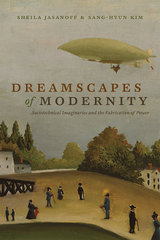 Dreamscapes of Modernity: Sociotechnical Imaginaries and the Fabrication of Power
Edited by Sheila Jasanoff and Sang-Hyun Kim
University of Chicago Press, 2015 Dreamscapes of Modernity offers the first book-length treatment of sociotechnical imaginaries, a concept originated by Sheila Jasanoff and developed in close collaboration with Sang-Hyun Kim to describe how visions of scientific and technological progress carry with them implicit ideas about public purposes, collective futures, and the common good. The book presents a mix of case studies—including nuclear power in Austria, Chinese rice biotechnology, Korean stem cell research, the Indonesian Internet, US bioethics, global health, and more—to illustrate how the concept of sociotechnical imaginaries can lead to more sophisticated understandings of the national and transnational politics of science and technology. A theoretical introduction sets the stage for the contributors’ wide-ranging analyses, and a conclusion gathers and synthesizes their collective findings. The book marks a major theoretical advance for a concept that has been rapidly taken up across the social sciences and promises to become central to scholarship in science and technology studies.
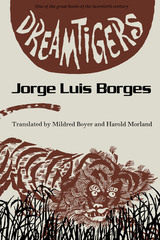 Dreamtigers
By Jorge Luis Borges
University of Texas Press, 1964 Dreamtigers has been heralded as one of the literary masterpieces of the twentieth century by Mortimer J. Adler, editor of Great Books of the Western World. It has been acknowledged by its author as his most personal work. Composed of poems, parables, and stories, sketches and apocryphal quotations, Dreamtigers at first glance appears to be a sampler—albeit a dazzling one—of the master's work. Upon closer examination, however, the reader discovers the book to be a subtly and organically unified self-revelation. Dreamtigers explores the mysterious territory that lies between the dreams of the creative artist and the "real" world. The central vision of the work is that of a recluse in the "enveloping serenity " of a library, looking ahead to the time when he will have disappeared but in the timeless world of his books will continue his dialogue with the immortals of the past — Homer, Don Quixote, Shakespeare. Like Homer, the maker of these dreams is afflicted with failing sight. Still, he dreams of tigers real and imagined and reflects upon of a life that, above all, has been intensely introspective, a life of calm self-possession and absorption in the world of the imagination. At the same time he is keenly aware of that other Borges, the public figure about whom he reads with mixed emotions: "It's the other one, it's Borges, that things happen to."
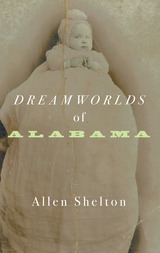 Dreamworlds of Alabama
Allen Shelton
University of Minnesota Press, 2007 “I speak in what others often hear as a strange accent. My past can’t be located. I live in Buffalo, New York, an exile from the South. But these aren’t Yankee dreams, even though my past seems like a fabrication, a dreamworld in which I’m a paper character and not a historical participant, with scars from barbed wire ripping under the pressure and flying through the air like a swarm of bees, or a horse rearing up and banging its head into mine from within, exploding my forehead.” —from the Preface Wisteria draped on a soldier’s coffin, sent home to Alabama from a Virginia battlefield. The oldest standing house in the county, painted gray and flanked by a pecan orchard. A black steel fence tool, now perched atop a pile of books like a prehistoric bird of prey. In Dreamworlds of Alabama, Allen Shelton explores physical, historical, and social landscapes of northeastern Alabama. His homeplace near the Appalachian foothills provides the setting for a rich examination of cultural practices, a place where the language of place and things resonates with as much vitality and emotional urgency as the language of humans. Throughout the book, Shelton demonstrates how deeply culture is inscribed in the land and in the most intimate spaces of the person—places of belonging and loss, insight and memory. Born and raised in Jacksonville, Alabama, Allen Shelton is associate professor of sociology at Buffalo State College.
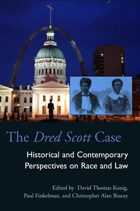 The Dred Scott Case: Historical and Contemporary Perspectives on Race and Law
David Thomas Konig
Ohio University Press, 2010 In 1846 two slaves, Dred and Harriet Scott, filed petitions for their freedom in the Old Courthouse in St. Louis, Missouri. As the first true civil rights case decided by the U.S. Supreme Court, Dred Scott v. Sandford raised issues that have not been fully resolved despite three amendments to the Constitution and more than a century and a half of litigation. The Dred Scott Case: Historical and Contemporary Perspectives on Race and Law presents original research and the reflections of the nation’s leading scholars who gathered in St. Louis to mark the 150th anniversary of what was arguably the most infamous decision of the U.S. Supreme Court. The decision, which held that African Americans “had no rights” under the Constitution and that Congress had no authority to alter that, galvanized Americans and thrust the issue of race and law to the center of American politics. This collection of essays revisits the history of the case and its aftermath in American life and law. In a final section, the present-day justices of the Missouri Supreme Court offer their reflections on the process of judging and provide perspective on the misdeeds of their nineteenth-century predecessors who denied the Scotts their freedom.
Contributors: Austin Allen, Adam Arenson, John Baugh, Hon. Duane Benton, Christopher Alan Bracey, Alfred L. Brophy, Paul Finkelman, Louis Gerteis, Mark Graber, Daniel W. Hamilton, Cecil J. Hunt II, David Thomas Konig, Leland Ware, Hon. Michael A. Wolff
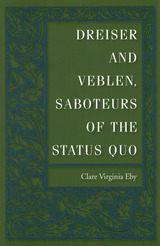 Dreiser and Veblen, Saboteurs of the Status Quo
Clare Virginia Eby
University of Missouri Press, 1999
In this important interdisciplinary study, Clare Eby argues that the writings of Theodore Dreiser and Thorstein Veblen form a neglected chapter in the history of United States cultural criticism that is especially relevant today.
This study leaves behind the narrow frameworks through which most of Veblen's and Dreiser's writings have been interpreted, covering a wide range of both authors' major and minor works. Moving beyond Veblen's The Theory of the Leisure Class and Dreiser's Sister Carrie, Eby shows how the two writers, as saboteurs of the status quo, anticipated many preoccupations of cultural critics today: the cultural role of the intellectual, the relationship of science to society, the place of consumption in modern life, and the intersection of class, gender, and power.
Eby uses cultural criticism as a unifying concept that shows how Veblen fuses satire, sociology, economics, history, psychology, anthropology, political science, and philosophy; and how Dreiser connects fiction, travelogue, literary manifesto, occasional essay, autobiography, biography, and philosophy. By reading Veblen through Dreiser, and Dreiser through Veblen, Eby illustrates the striking parallels between their works, demonstrating how literature and social science can merge in cultural criticism.
Although Dreiser's interest in the natural and social sciences has often been noted, this study provides the only extended analysis of how his works actually resemble, and strive to become, critically informed social science. Similarly, despite the singularity of Veblen's rhetoric, the centrality of literary devices to his works has never been systematically examined. By placing the works of Veblen and Dreiser into dialogue, this study contributes significantly to the recent attempts to bring together the concerns of literary analysts and social scientists.
Dreiser and Veblen, Saboteurs of the Status Quo makes an important contribution not only to Dreiser and Veblen studies but also to cultural criticism itself.
Dress in American Culture
Edited by Patricia A. Cunningham and Susan Voso Lab
University of Wisconsin Press, 1993 Early Americans accommodated, adapted, and manipulated their clothing to adjust to their physical and social environment. This book focuses on the relationship of dress to the struggle of indigenous and immigrant Americans to fill expected and unexpected needs and express political ideologies and ethnic identity. In doing so the contributors hope to prompt readers to reconsider the place of dress in the interpretation of American culture. The casual reader of this book of essays may be surprised to learn that it has little to do with different styles of clothing or the vagaries of fashion.
The contributors reveal the politics, or power, of dress, especially in its function as a symbol of American ideals, and examine changes in clothing behavior that occurred as Americans faced new experiences.
Dressed as in a Painting: Women and British Aestheticism in an Age of Reform
Kimberly Wahl
University of New Hampshire Press, 2013 In Dressed as in a Painting, Kimberly Wahl provides a lucid exploration of the interrelations between fashion, art, and Aestheticism during the latter half of the nineteenth century. Although artistic forms of dress have been the subject of short studies before, no book has focused exclusively on Aesthetic dress and its various expressions in the visual cultures of Victorian Britain. More important, no book has attempted to investigate the gap between the material facts of artistic clothing as it was embodied on the wearer, and its presence as an idealized sartorial trope in the visual and textual print culture of the period.
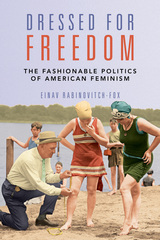 Dressed for Freedom: The Fashionable Politics of American Feminism
Einav Rabinovitch-Fox
University of Illinois Press, 2021 Often condemned as a form of oppression, fashion could and did allow women to express modern gender identities and promote feminist ideas. Einav Rabinovitch-Fox examines how clothes empowered women, and particularly women barred from positions of influence due to race or class. Moving from 1890s shirtwaists through the miniskirts and unisex styles of the 1970s, Rabinovitch-Fox shows how the rise of mass media culture made fashion a vehicle for women to assert claims over their bodies, femininity, and social roles. She also highlights how trends in women’s sartorial practices expressed ideas of independence and equality. As women employed new clothing styles, they expanded feminist activism beyond formal organizations and movements and reclaimed fashion as a realm of pleasure, power, and feminist consciousness. A fascinating account of clothing as an everyday feminist practice, Dressed for Freedom brings fashion into discussions of American feminism during the long twentieth century.
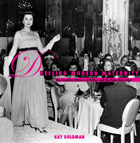 Dressing Modern Maternity: The Frankfurt Sisters of Dallas and the Page Boy Label
Kay Goldman
Texas Tech University Press, 2013
In Depression-era Dallas, Elsie Frankfurt and Edna Frankfurt Ravkind raised five hundred dollars and launched a daring new enterprise, Page Boy Maternity Clothing--the first to engineer elegance in comfort. When Louise Frankfurt Gartner joined the team, the sisters’ combined engineering, business, and PR genius made Page Boy the foremost maternity-clothing manufacturer in the United States. Dressing entertainment icons such as Loretta Young, Elizabeth Taylor, and Florence Henderson, Page Boy broke new ground in every direction. Innovative marketing and business strategies would make the Page Boy label internationally known and land the Frankfurt sisters celebrity in their own right. As a company, Page Boy would thrive till the end of the twentieth century, leaving a rich legacy in the histories of fashion and women in business.
Illuminating the Page Boy story are Goldman’s insights into the history of maternity clothing in the U.S., American women in business prior to the 1930s, Jewish involvement in garment manufacturing in Dallas, and ultimately the decisions that would lead to Page Boy’s demise.
The Dressing Room: Backstage Lives and American Film
Desirée J. Garcia
Rutgers University Press, 2025 A recurrent and popular setting in American cinema, the dressing room has captured the imaginations of filmmakers and audiences for over a century. In The Dressing Room: Backstage Lives and American Film, the only book-length study of the space, author Desirée J. Garcia explores how dressing rooms are dynamic realms in which a diverse cast of performers are made and exposed. Garcia analyzes the backstage film, which spans film history, modes, and genre, to show how dressing rooms have been a useful space for filmmakers to examine the performativity of American life. From the Black maid to the wife and mother to the leading man, dressing rooms navigate, shape, and challenge society’s norms. The stakes are high in dressing rooms, Garcia argues, because they rehearse larger questions about identity and its performance, negotiating who can succeed and who cannot and on what terms.
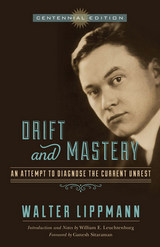 Drift and Mastery: An Attempt to Diagnose the Current Unrest
Walter Lippmann, Introduction and notes by William E. Leuchtenburg, Foreword by Ganesh Sitaraman
University of Wisconsin Press, 2015 In 1914, a brilliant young political journalist published a book arguing that the United States had entered a period of “drift”—a lack of control over rapidly changing forces in society. He highlighted the tensions between expansion and consolidation, traditionalism and progressivism, and emotion and rationality. He wrote to convince readers that they could balance these tensions: they could be organized, efficient, and functional without sacrificing impulse, choice, or liberty. Mastery over drift is attainable, Walter Lippmann argued, through diligent attention to facts and making active choices. Democracy, Lippman wrote, is “a use of freedom, an embrace of opportunity.” Lippman’s Drift and Mastery became one of the most important and influential documents of the Progressive Movement. It remains a valuable text for understanding the political thought of early twentieth-century America and a lucid exploration of timeless themes in American government and politics. Distinguished historian Walter Leuchtenberg’s 1986 introduction and notes are retained in this edition. Ganesh Sitaraman, who has provided a foreword for this centennial edition, suggests that Lippmann’s classic still has much to say to twenty-first-century progressives. The underlying solutions for our time, he believes, are similar to those of Lippman’s era. Sitaraman contends that American society can regain mastery over drift by reforming finance and reducing inequality, by rethinking the relationship between corporations and workers, and by embracing changes in social life.
 Drift Net: The Aesthetics of Literature and Media in Migration
Chris Campanioni
Lever Press, 2025 Today’s aesthetic strategies to compose content and identity across digital media are neither new nor exclusively digital, but emerged from migration. In Drift Net: The Aesthetics of Literature and Media in Migration, Chris Campanioni theorizes an aesthetics of transmedia as a framework for civic activism, while showing how migrants have forecasted and reshaped new media practices and norms, producing a political subjectivity that resists subjectification. As borders, global inequality, racism, and xenophobia proliferate, migrants continue to enact the possibilities of something else, beyond being spoken about and spoken for.
Through a model Campanioni calls a “migratory text,” Drift Net advances a theory of literature and art born in translation that calls into question established theories of world literature, national literatures, literary periodization, and translation itself. Through an analysis of works born in translation and produced in passage, detention, and exile, Campanioni utilizes this model to read creatively across a wide range of social and political formations, from the experience of his parents' exiles to alternative housing initiatives and asylum reform efforts throughout Europe, including the largest LGBT+ refugee center in the world. Drawing on a mixed methodology of qualitative interviews with asylum applicants and shelter directors, textual analysis, and autoethnographic narrative, Drift Net traces literary developments alongside contemporary social and political interventions. This approach proposes interventions on the organizational levels of asylum, integration, public housing, and membership. It also marks the ways migrant creators have reformulated subjectivity through the same genres and modes that have contributed to their devaluation as minoritized subjects.
Drift Net both deepens and broadens our conceptualization of migrant literature, and recovers an understanding and application of transmedia that predates digital cultures. Campanioni offers a wide-ranging study of texts including Edward Said and Jean Mohr’s After the Last Sky: Palestinian Lives, Edgar Garcia’s Skins of Columbus, Anna Seghers’s Transit, Francis Ponge’s Soap, Walid Raad’s The Atlas Group, Klára Hosnedlová’s embroidered paintings, Reem Karssli and Caroline Williams’s Now is the Time To Say Nothing, Cornelia Schleime’s paper prints, and more. Drift Net formulates the “migratory” as a site of artistic production, resistance, and possibility, where theory is not an end but the beginning of tools and practices that might help researchers, instructors, and organizers to develop their strategies.
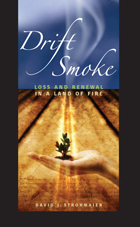 Drift Smoke: Loss and Renewal in a Land of Fire
David J. Strohmaier
University of Nevada Press, 2009 David Strohmaier’s long career as a firefighter has given him intimate knowledge of wildfire and its complex role in the natural world of the American West. It has also given him rare understanding of the painful losses that are a consequence of fire. Strohmaier addresses our ambivalence about fire and the realities of loss to it—of life, human and animal, of livelihoods, of beloved places. He also examines the process of renewal that is yet another consequence of fire, from the infusion of essential nutrients into the soil, to the sprouting of seeds that depend on fire for germination, to the renewal of species as the land restores itself. Ultimately, according to Strohmaier, living with fire is a matter of choices, of “seeing the connection between loss on a personal scale and loss on a landscape scale: in relationship with persons, and in relationship to and with the land.” We must cultivate a longer perspective, he says, accepting that loss is a part of life and that “humility and empathy and care are not only core virtues between humans but are also essential virtues in our attitudes and actions toward the earth.” Drift Smoke is a powerful and moving meditation on wildfire by someone who has seen it in all its terror and beauty, who has lost colleagues and beloved terrain to its ferocity, and who has also seen the miracle of new life sprouting in the ashes. The debate over the role and control of fire in the West will not soon end, but Strohmaier’s contribution to the debate will help all of us better appreciate both the complexity of the issues and the possibilities of hitherto unconsidered solutions that will allow us to inhabit a place where fire is a natural, and needed, part of life.
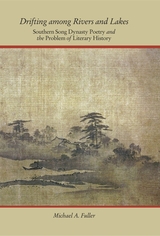 Drifting among Rivers and Lakes: Southern Song Dynasty Poetry and the Problem of Literary History
Michael A. Fuller
Harvard University Press, 2013 What drives literary change? Does literature merely follow shifts in a culture, or does it play a distinctive role in shaping emergent trends? Michael Fuller explores these questions while examining the changes in Chinese shi poetry from the late Northern Song dynasty (960–1127) to the end of the Southern Song (1127–1279), a period of profound social and cultural transformation.
Shi poetry written in response to events was the dominant literary genre in Song dynasty China, serving as a central form through which literati explored meaning in their encounters with the world. By the late Northern Song, however, old models for meaning were proving inadequate, and Daoxue (Neo-Confucianism) provided an increasingly attractive new ground for understanding the self and the world. Drifting among Rivers and Lakes traces the intertwining of the practice of poetry, writings on poetics, and the debates about Daoxue that led to the cultural synthesis of the final years of the Southern Song and set the pattern for Chinese society for the next six centuries. Examining the writings of major poets and Confucian thinkers of the period, Fuller discovers the slow evolution of a complementarity between poetry and Daoxue in which neither discourse was self-sufficient.
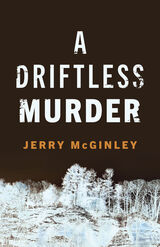 A Driftless Murder
Jerry McGinley
University of Wisconsin Press, 2021 As he finishes a cup of his morning coffee, retired cop and former detective Pat Donegal gets a curious call from the Kickapoo County Chief Deputy Hennie Duggan. A gruesome discovery of human remains on a ridge portends grisly possibilities that neither man wants to consider. Donegal, physically and emotionally hungover from a rough break-up, is known for his unorthodox methods and a tendency to bend the rules. Even though Duggan chafes at his style, he knows he needs a skilled investigator like Donegal to have his back.
As strange details continue to emerge, the detectives enlist the help of city cop and data expert Shea Sommers. As the team crisscrosses the state to chase a few promising leads, their search expands beyond local guides and neighbors to members of a sinister, secret hunting society. When Duggan mysteriously disappears—and becomes a suspect himself—Donegal must take over the investigation. He soon realizes the case might not only be unsolvable but could land him in prison—or an early grave.
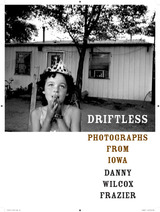 Driftless: Photographs from Iowa
Danny Wilcox Frazier
Duke University Press, 2007 Winner of the third biennial Center for Documentary Studies/Honickman First Book Prize Robert Frank, Prize Judge In Driftless, Danny Wilcox Frazier’s dramatic black-and-white photographs portray a changing Midwest of vanishing towns and transformed landscapes. As rural economies fail, people, resources, and services are migrating to the coasts and cities, as though the heart of America were being emptied. Frazier’s arresting photographs take us into Iowa’s abandoned places and illuminate the lives of those people who stay behind and continue to live there: young people at leisure, fishermen on the Mississippi, veterans on Memorial Day, Amish women playing cards, as well as more recent arrivals: Lubavitcher Hasidic Jews at prayer, Latinos at work in the fields. Frazier’s camera finds these newcomers while it also captures activities that seemingly have gone on forever: harvesting and hunting, celebrating and socializing, praying and surviving. This collection of photographs is a portrait of contemporary rural Iowa, but it is also more that that. It shows what is happening in many rural and out-of-the-way communities all over the United States, where people find ways to get by in the wake of closing factories and the demise of family farms. Taken by a true insider who has lived in Iowa his entire life, Frazier’s photographs are rich in emotion and give expression to the hopes and desires of the people who remain, whose needs and wants are complicated by the economic realities remaking rural America. Poetic and dark but illuminated with flashes of insight, Frazier’s stunning images evoke the brilliance of Robert Frank’s The Americans. To view an image gallery, click here.
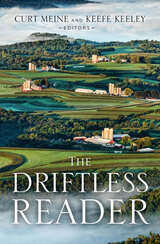 The Driftless Reader
Edited by Curt Meine and Keefe Keeley
University of Wisconsin Press, 2017 Ancient glaciers passed by the Driftless Area and waterways vein its interior, forming an enchanting, enigmatic landscape of sharp ridgetops and deep valleys. Across time, this rugged topography has been home to an astonishing variety of people: Sauk, Dakota, and Ho-Chunk villagers, Norwegian farmers and Mexican mercado owners, Dominican nuns and Buddhist monks, river raftsmen and Shakespearean actors, Cornish miners and African American barn builders, organic entrepreneurs and Hmong truck gardeners.
The Driftless Reader gathers writings that highlight the unique natural and cultural history, landscape, and literature of this region that encompasses southwestern Wisconsin and adjacent Minnesota, Iowa, and Illinois. The more than eighty selected texts include writings by Black Hawk, Mark Twain, Laura Ingalls Wilder, Frank Lloyd Wright, Aldo Leopold, David Rhodes, and many other Native people, explorers, scientists, historians, farmers, songwriters, journalists, and poets. Paintings, photographs, maps, and other images complement the texts, providing a deeper appreciation of this region's layered natural and human history.
Highlights include excerpts and art from:
Carol Ryrie Brink
William Cronon
John T. Curtis
August Derleth
Richard Eberhart
Fabu
Hamlin Garland
Pedro Guerrero
Hoowaneka (Little Elk)
Juliet Kinzie
Patty Loew
Ben Logan
Truman Lowe
Jacques Marquette
Ken McCullough
Edna Meudt
Mountain Wolf Woman
Zebulon Pike
Henry Schoolcraft
Clifford D. Simak
Wallace Stegner
Pearl Swiggum
Frank Utpatel
Mark Wunderlich
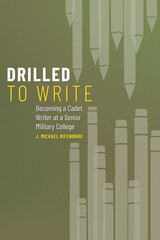 Drilled to Write: Becoming a Cadet Writer at a Senior Military College
by J. Michael Rifenburg
Utah State University Press, 2022 Drilled to Write offers a rich account of US Army cadets navigating the unique demands of Army writing at a senior military college. In this longitudinal case study, J. Michael Rifenburg follows one cadet, Logan Blackwell, for four years and traces how he conceptualizes Army writing and Army genres through immersion in military science classes, tactical exercises in the Appalachian Mountains, and specialized programs like Airborne School. Drawing from research on rhetorical genre studies, writing transfer, and materiality, Drilled to Write speaks to scholars in writing studies committed to capturing how students understand their own writing development. Collectively, these chapters articulate four ways Blackwell leveraged resources through ROTC to become a cadet writer at this military college. Each chapter is dedicated to one year of his undergraduate experience with focus on curricular writing for his business management major and military science classes as well as his extracurricular writing, like his Ballroom Dance Club bylaws and a three-thousand-word short story. In Drilled to Write, Rifenburg invites readers to see how cadets are positioned between civilian and military life—a curiously liminal space where they develop as writers. Using Army ROTC as an entry into genre theory and larger conversations about the role higher education plays in developing Army officers, he shows how writing students develop genre awareness and flexibility while forging a personal identity.
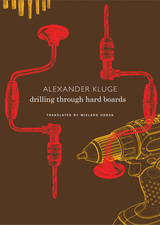 Drilling through Hard Boards: 133 Political Stories
Alexander Kluge
Seagull Books, 2019 Max Weber famously described politics as “a strong, slow drilling through hard boards with both passion and judgment.” Taking this as his inspiration, Alexander Kluge brings readers yet another literary masterpiece. Drilling through Hard Boards is a kaleidoscopic meditation on the tools available to those who struggle for power. Weber’s metaphorical drill certainly embodies intelligent tenacity as a precondition for political change. But what is a hammer in the business of politics, Kluge wonders, and what is a subtle touch? Eventually, we learn that all questions of politics lead to a single one: what is political in the first place?
In the book, Kluge masterfully unspools more than one hundred vignettes, through which it becomes clear that the political is more often than not personal. Politics are everywhere in our everyday lives, so along with the stories of major political figures, we also find here the small, mostly unknown ones: Elfriede Eilers alongside Pericles, Chilean miners next to Napoleon, a three-month-old baby beside Alexander the Great. Drilling through Hard Boards is not just Kluge’s newest fiction, it is a masterpiece of political thought.
 Drinkers, Drivers, and Bartenders: Balancing Private Choices and Public Accountability
Frank A. Sloan, Emily M. Stout, Kathryn Whetten-Goldstein, and Lan Liang
University of Chicago Press, 2000 According to the United States Public Health Service, over 100,000 deaths a year are attributable to alcohol, including 20,000 highway fatalities. In response, legislatures have enacted various forms of regulation intended both to reduce alcohol consumption and to curb its harmful effects. This groundbreaking study focuses on one such form of regulation, the liability imposed on alcohol servers and social hosts by tort law. Basing their analysis on important new data from their extensive research and in-depth interviews with actors on all sides of the issue, the authors conclude that, despite their relative unpopularity, tort laws are very effective in reducing accidents—even more than criminal sanctions.
Extraordinary in scope and exacting in detail, Drinkers, Drivers, and Bartenders: Balancing Private Choices and Public Accountability links alcohol problems, deterrence, and serving practices in a way no other work has been able to do and is certain to become a crucial reference point for researchers and policymakers alike.
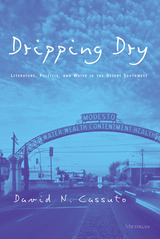 Dripping Dry: Literature, Politics and Water in the Desert Southwest
David N. Cassuto
University of Michigan Press, 2001 More than any other single characteristic, aridity defines the American West. Water scarcity and its biologically critical function have also molded the regional literature of the region. Using novels by Barbara Kingsolver, Edward Abbey, John Steinbeck and Mary Austin, Dripping Dry combines literary analysis with environmental criticism to demonstrate how the myths that have pervaded the regional literature of the West have interacted with the myths that have shaped water policy throughout the twentieth century.
The four works selected (Animal Dreams, The Monkey Wrench Gang, The Grapes of Wrath, and The Ford) present a composite portrait of reclamation, which the author argues is one of the most important cultural and ecological phenomena in the nation's history. The tensions and contradictions presented by the novels underscore the compelling need for an ecocritique of the relationship between literature and politics. David N. Cassuto deciphers the myths of reclamation and restoration and presents a third alternative--sustainability--in their stead. The challenge is a large one, because of the size and complexity of the region and because nature continues to evolve and create itself, a process involving language, ideology, and the land.
The book is designed to be an interdisciplinary contribution both to the emerging field of literature and the environment, as well as to environmental studies. It will be welcomed by scholars as well as general readers interested in new approaches to literature and environmental issues, and by those interested in the geography and literature of the western United States.
David N. Cassuto, formerly of the English Department of the University of Missouri-Rolla, is a practicing attorney in San Francisco, specializing in environmental issues.
Drive in Cinema: Essays on Film, Theory and Politics
Marc James Léger
Intellect Books, 2015 In Drive in Cinema, Marc James Léger presents Žižek-influenced studies of films made by some of the most influential filmmakers of our time, including Jean-Luc Godard, Pier Paolo Pasolini, Werner Herzog, Alexander Kluge, William Klein, Jim Jarmusch, Hal Hartley, Harmony Korine, and more. Working with radical theory and Lacanian ethics, Léger draws surprising connections between art, film, and politics, taking his analysis beyond the academic obsession with cultural representation and filmic technique and instead revealing film’s potential as an emancipatory force.
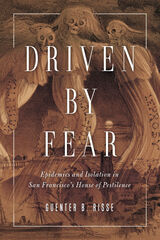 Driven by Fear: Epidemics and Isolation in San Francisco's House of Pestilence
Guenter B. Risse
University of Illinois Press, 2015 From the late nineteenth century until the 1920s, authorities required San Francisco's Pesthouse to segregate the diseased from the rest of the city. Although the Pesthouse stood out of sight and largely out of mind, it existed at a vital nexus of civic life where issues of medicine, race, class, environment, morality, and citizenship entwined and played out. Guenter B. Risse places this forgotten institution within an emotional climate dominated by widespread public dread and disgust. In Driven by Fear, he analyzes the unique form of stigma generated by San Franciscans. Emotional states like xenophobia and racism played a part. Yet the phenomenon also included competing medical paradigms and unique economic needs that encouraged authorities to protect the city's reputation as a haven of health restoration. As Risse argues, public health history requires an understanding of irrational as well as rational motives. To that end he delves into the spectrum of emotions that drove extreme measures like segregation and isolation and fed psychological, ideological, and pragmatic urges to scapegoat and stereotype victims--particularly Chinese victims--of smallpox, leprosy, plague, and syphilis. Filling a significant gap in contemporary scholarship, Driven by Fear looks at the past to offer critical lessons for our age of bioterror threats and emerging infectious diseases.
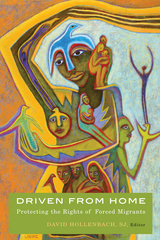 Driven from Home: Protecting the Rights of Forced Migrants
David Hollenbach, SJ, Editor
Georgetown University Press, 2010 Throughout human history people have been driven from their homes by wars, unjust treatment, earthquakes, and hurricanes. The reality of forced migration is not new, nor is awareness of the suffering of the displaced a recent discovery. The United Nations High Commissioner for Refugees estimates that at the end of 2007 there were 67 million persons in the world who had been forcibly displaced from their homes—including more than 16 million people who had to flee across an international border for fear of being persecuted due to race, religion, nationality, social group, or political opinion. Driven from Home advances the discussion on how best to protect and assist the growing number of persons who have been forced from their homes and proposes a human rights framework to guide political and policy responses to forced migration. This thought-provoking volume brings together contributors from several disciplines, including international affairs, law, ethics, economics, and theology, to advocate for better responses to protect the global community’s most vulnerable citizens.
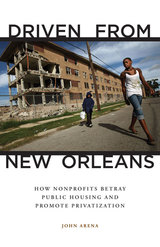 Driven from New Orleans: How Nonprofits Betray Public Housing and Promote Privatization
John Arena
University of Minnesota Press, 2012 In the early 1980s the tenant leaders of the New Orleans St. Thomas public housing development and their activist allies were militant, uncompromising defenders of the city’s public housing communities. Yet ten years later these same leaders became actively involved in a planning effort to privatize and downsize their community—an effort that would drastically reduce the number of affordable apartments. What happened? John Arena—a longtime community and labor activist in New Orleans—explores this drastic change in Driven from New Orleans, exposing the social disaster visited on the city’s black urban poor long before the natural disaster of Katrina magnified their plight. Arena argues that the key to understanding New Orleans’s public housing transformation from public to private is the co-optation of grassroots activists into a government and foundation-funded nonprofit complex. He shows how the nonprofit model created new political allegiances and financial benefits for activists, moving them into a strategy of insider negotiations that put the profit-making agenda of real estate interests above the material needs of black public housing residents. In their turn, white developers and the city’s black political elite embraced this newfound political “realism” because it legitimized the regressive policies of removing poor people and massively downsizing public housing, all in the guise of creating a new racially integrated, “mixed-income” community. In tracing how this shift occurred, Driven from New Orleans reveals the true nature, and the true cost, of reforms promoted by an alliance of a neoliberal government, nonprofits, community activists, and powerful real estate interests.
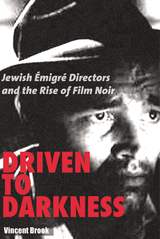 Driven to Darkness: Jewish Emigre Directors and the Rise of Film Noir
Brook, Vincent
Rutgers University Press, 2009 From its earliest days, the American film industry has attracted European artists. With the rise of Hitler, filmmakers of conscience in Germany and other countries, particularly those of Jewish origin, found it difficult to survive and fledùfor their work and their livesùto the United States. Some had trouble adapting to Hollywood, but many were celebrated for their cinematic contributions, especially to the dark shadows of film noir. Driven to Darkness explores the influence of Jewish TmigrT directors and the development of this genre. While filmmakers such as Fritz Lang, Billy Wilder, Otto Preminger, and Edward G. Ulmer have been acknowledged as crucial to the noir canon, the impact of their Jewishness on their work has remained largely unexamined until now. Through lively and original analyses of key films, Vincent Brook penetrates the darkness, shedding new light on this popular film form and the artists who helped create it.
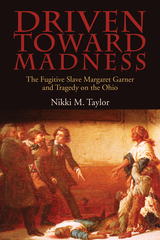 Driven toward Madness: The Fugitive Slave Margaret Garner and Tragedy on the Ohio
Nikki M. Taylor
Ohio University Press, 2016 Margaret Garner was the runaway slave who, when confronted with capture just outside of Cincinnati, slit the throat of her toddler daughter rather than have her face a life in slavery. Her story has inspired Toni Morrison’s Beloved, a film based on the novel starring Oprah Winfrey, and an opera. Yet, her life has defied solid historical treatment. In Driven toward Madness, Nikki M. Taylor brilliantly captures her circumstances and her transformation from a murdering mother to an icon of tragedy and resistance. Taylor, the first African American woman to write a history of Garner, grounds her approach in black feminist theory. She melds history with trauma studies to account for shortcomings in the written record. In so doing, she rejects distortions and fictionalized images; probes slavery’s legacies of sexual and physical violence and psychic trauma in new ways; and finally fleshes out a figure who had been rendered an apparition.
Driver Adaptation to Information and Assistance Systems
Alan Stevens
The Institution of Engineering and Technology, 2013 Driver information and assistance systems have emerged as an integral part of modern road vehicles in order to support the driver while driving. They make use of the newest information technologies in order to enhance driver awareness, safety and comfort, and thereby avoiding driver errors and accidents. Driver Adaptation to Information and Assistance Systems brings together recent work by the Marie-Curie Initial Training Network ADAPTATION. The project has studied drivers' behavioural adaptation to these new technologies from an integrative perspective working under a joint conceptual theoretical framework of behavioural adaptation that can be used to generate research hypotheses about how drivers will adapt to information and assistance systems and to derive guidelines for the design and deployment of such systems.
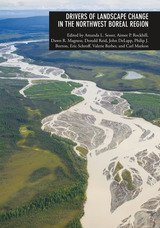 Drivers of Landscape Change in the Northwest Boreal Region
Edited by Carl Markon, Amanda L. Sesser, Aimee P. Rockhill, Dawn R. Magness, Don Reid, John DeLapp, Phil Burton, Eric Schroff, and Valerie Barber
University of Alaska Press, 2019 The northwest boreal region (NWB) of North America is a land of extremes. Extending more than 1.3 million square kilometers (330 million acres), it encompasses the entire spectrum between inundated wetlands below sea level to the tallest peak in North America. Permafrost gradients span from nearly continuous to absent. Boreal ecosystems are inherently dynamic and continually change over decades to millennia. The braided rivers that shape the valleys and wetlands continually change course, creating and removing vast wetlands and peatlands. Glacial melt, erosion, fires, permafrost dynamics, and wind-blown loess are among the shaping forces of the landscape. As a result, species interactions and ecosystem processes are shifting across time.
The NWB is a data-poor region, and the intention of the NWB Landscape Conservation Cooperative is to determine what data are not available and what data are available. For instance, historical baseline data describing the economic and social relationships in association with the ecological condition of the NWB landscape are often lacking. Likewise, the size and remoteness of this region make it challenging to measure basic biological information, such as species population sizes or trends. The paucity of weather and climate monitoring stations also compound the ability to model future climate trends and impacts, which is part of the nature of working in the north. The purpose of this volume is to create a resource for regional land and resource managers and researchers by synthesizing the latest research on the historical and current status of landscape-scale drivers (including anthropogenic activities) and ecosystem processes, future projected changes of each, and the effects of changes on important resources. Generally, each chapter is coauthored by researchers and land and natural resource managers from the United States and Canada.
Drivers of Long-Term Insecurity and Instability in Pakistan: Urbanization
Jonah Blank
RAND Corporation, 2014 Pakistan is already one of the most urbanized nations in South Asia, and a majority of its population is projected to be living in cities within three decades. This demographic shift is likely to have a significant impact on Pakistan’s politics and stability. This report briefly examines urbanization as a potential driver of long-term insecurity and instability, with particular attention to the cities of Karachi, Lahore, and Quetta.
 Driving a Table Down
Barry Phipps
University of Iowa Press, 2020 On September 23, 2018, photographer Barry Phipps drove seven hours south from his home in Iowa to his parents’ house in southern Missouri. There they wrestled a family heirloom into his car—a wooden table for his Aunt Diane—and Barry and his mother drove more than twelve hundred miles to Diane’s home on Florida’s Gulf Coast, stayed a few days, then drove back to Missouri.
Phipps presents the 104 color photographs in Driving a Table Down—selected from more than 2,000 photographs taken over the twelve-day trip—in sequential order to show, in his words, “what does and does not change as one travels through shifting cultural and geographic regions.” By capturing the present moment while referencing the past with faded signs, almost obliterated murals, closed businesses in quiet towns, forgotten tourist attractions, and many other layers of historical accumulations, the photographs illustrate the stark fact that the present is never entirely present tense. Phipps’s attention to the real-time details of rural regions of the Midwest and the South, juxtaposed with personal photographs of his family, gives us a momentary definition of America in a state of flux, an America that looks to the past in a time of an uncertain future.
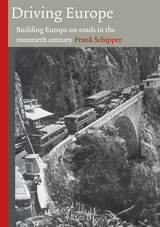 Driving Europe: Building Europe on Roads in the Twentieth Century (Technology and Europe History) (Volume 3)
Frank Schipper
Amsterdam University Press, 2009 Today we can hardly imagine life in Europe without roads and the automobiles that move people and goods around. In fact, the vast majority of movement in Europe takes place on the road. Travelers use the car to explore parts of the continent on their holidays, and goods travel large distances to reach consumers. Indeed, the twentieth century has deservedly been characteried as the century of the car. The situation looked very different around 1900. People crossing national borders by car encountered multiple hurdles on their way. Technically, they imported their vehicle into a neighboring country and had to pay astronomic import duties. Often they needed to pass a driving test in each country they visited. Early on, automobile and touring clubs sought to make life easier for traveling motorists. International negotiations tackled the problems arising from differing regulations. The resulting volume describes everything from the standardied traffic signs that saved human lives on the road to the Europabus taking tourists from Stockholm to Rome in the 1950s. Driving Europe offers a highly original portrait of a Europe built on roads in the course of the twentieth century.
 Driving Force: The Natural Magic of Magnets
James D. Livingston
Harvard University Press, 1996 Driving Force unfolds the long and colorful history of magnets: how they guided (or misguided) Columbus; mesmerized eighteenth-century Paris but failed to fool Benjamin Franklin; lifted AC power over its rival, DC, despite all the animals, one human among them, executed along the way; led Einstein to the theory of relativity; helped defeat Hitler's U-boats; inspired writers from Plato to Dave Barry. In a way that will delight and instruct even the nonmathematical among us, James Livingston shows us how scientists today are creating magnets and superconductors that can levitate high-speed trains, produce images of our internal organs, steer high-energy particles in giant accelerators, and--last but not least--heat our morning coffee.
From the "new" science of materials to everyday technology, Driving Force makes the workings of magnets a matter of practical wonder. The book will inform and entertain technical and nontechnical readers alike and will give them a clearer sense of the force behind so much of the working world.
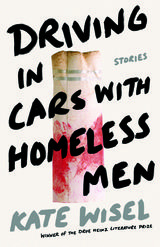 Driving in Cars with Homeless Men: Stories
Kate Wisel
University of Pittsburgh Press, 2019 A Library Journal Best Book of 2019
Finalist, 2019 Foreword Indies Award
Driving in Cars with Homeless Men is a love letter to women moving through violence. These linked stories are set in the streets and the bars, the old homes, the tiny apartments, and the landscape of a working-class Boston. Serena, Frankie, Raffa, and Nat collide and break apart like pool balls to come back together in an imagined post-divorce future. Through the gritty, unraveling truths of their lives, they find themselves in the bed of an overdosed lover, through the panting tongue of a rescue dog who is equally as dislanguaged as his owner, in the studio apartment of a compulsive liar, sitting backward but going forward in the galley of an airplane, in relationships that are at once playgrounds and cages. Homeless Men is the collective story of women whose lives careen back into the past, to the places where pain lurks and haunts. With riotous energy and rage, they run towards the future in the hopes of untangling themselves from failure to succeed and fail again.
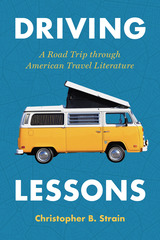 Driving Lessons: A Road Trip through American Travel Literature
Christopher B. Strain
University of Alabama Press, 2025 Weaves the author’s own four-month cross-country sojourn in a VW van with thoughts on travel narratives across the history of American literature In Driving Lessons, Christopher B. Strain sets out on a quintessential American road trip, exploring not just the roads and byways of the country but the road trip’s place in American culture. Strain dives into the well of American travel writing, illuminating fascinating aspects of the road trip, such as how race, class, and gender shape the experiences of road trippers. In the summer of 1998, amid a professional crisis of confidence, Strain settled on a plan to reconnect with both himself and the country he studies. He purchased a 1972 Volkswagen Westfalia van and set off on his own cross-country odyssey. In the weeks that followed, he ruminated on his own ongoing journey alongside great journeys from the past and how they reveal the heart of the traveler as well as the landscape of the nation. Visiting archives and landmarks across the United States, Strain's journey became a parallel to the stories he studied—an opportunity to see and experience the cities, national parks, and monuments that define US history. Driving Lessons is a compelling blend of literary analysis and memoir, offering readers an insightful and heartfelt reflection on the enduring power of the American road trip.
Driving Simulators for the Evaluation of Human-Machine Interfaces in Assisted and Automated Vehicles
Toshio Ito
The Institution of Engineering and Technology, 2021 Driving Simulators for the Evaluation of Human-Machine Interfaces in Assisted and Automated Vehicles is a concise reference work on driving simulators, which conveys the technology behind simulator systems used to test driver assistance systems and automated vehicles, including electric vehicles. Coverage includes architecture, computer graphics, evaluation parameters and applied examples.
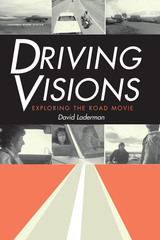 Driving Visions: Exploring the Road Movie
By David Laderman
University of Texas Press, 2002 From the visionary rebellion of Easy Rider to the reinvention of home in The Straight Story, the road movie has emerged as a significant film genre since the late 1960s, able to cut across a wide variety of film styles and contexts. Yet, within the variety, a certain generic core remains constant: the journey as cultural critique, as exploration beyond society and within oneself. This book traces the generic evolution of the road movie with respect to its diverse presentations, emphasizing it as an "independent genre" that attempts to incorporate marginality and subversion on many levels. David Laderman begins by identifying the road movie's defining features and by establishing the literary, classical Hollywood, and 1950s highway culture antecedents that formatively influenced it. He then traces the historical and aesthetic evolution of the road movie decade by decade through detailed and lively discussions of key films. Laderman concludes with a look at the European road movie, from the late 1950s auteurs through Godard and Wenders, and at compelling feminist road movies of the 1980s and 1990s.
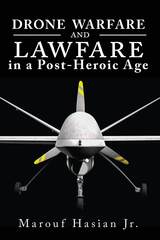 Drone Warfare and Lawfare in a Post-Heroic Age
Marouf Hasian Jr.
University of Alabama Press, 2016 In the past decade, the United States has rapidly deployed militarized drones in theaters of war for surveillance as well as targeted killing. The swiftness with which drones were created and put into service has outstripped the development of an associated framework for discussing them, with the result that basic conversations about these lethal weapons have been stymied for a lack of a shared rhetoric. Marouf Hasian’s Drone Warfare and Lawfare in a Post-Heroic Age fills that critical gap.
With a growing fleet of more than 7,500 drones, these emblems of what one commentary has dubbed “push-button, bloodless wars” comprise as much as a third of the US aircraft force. Their use is hotly debated, some championing air power that doesn’t risk the lives of pilots, others arguing that drone strikes encourage cycles of violence against the United States, its allies, and interests.
In this landmark study, Hasian illuminates both the discursive and visual argumentative strategies that drone supporters and critics both rely on. He comprehensively reviews how advocates and detractors parse and re-contextualize drone images, casualty figures, governmental “white papers,” NGO reports, documentaries, and blogs to support their points of view. He unpacks the ideological reflexes and assumptions behind these legal, ethical, and military arguments.
Visiting both formal legal language used by legislators, political leaders, and policy makers as well as public, vernacular commentaries about drones, Drone Warfare and Lawfare in a Post-Heroic Age dispassionately illuminates the emotive, cognitive, and behavioral strategies partisans use to influence public and official opinion.
 Drones and Support for the Use of Force
James Igoe Walsh and Marcus Schulzke
University of Michigan Press, 2018 Combat drones are transforming attitudes about the use of military force. Military casualties and the costs of conflict sap public support for war and for political and military leaders. Combat drones offer an unprecedented ability to reduce these costs by increasing accuracy, reducing the risks to civilians, and protecting military personnel from harm. These advantages should make drone strikes more popular than operations involving ground troops. Yet many critics believe drone warfare will make political leaders too willing to authorize wars, weakening constraints on the use of force. Because combat drones are relatively new, these arguments have been based on anecdotes, a handful of public opinion polls, or theoretical speculation.
Drones and Support for the Use of Force uses experimental research to analyze the effects of combat drones on Americans’ support for the use of force. The authors’ findings—that drones have had important but nuanced effects on support for the use of force—have implications for democratic control of military action and civil-military relations and provide insight into how the proliferation of military technologies influences foreign policy.
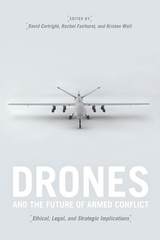 Drones and the Future of Armed Conflict: Ethical, Legal, and Strategic Implications
Edited by David Cortright, Rachel Fairhurst, and Kristen Wall
University of Chicago Press, 2015 During the past decade, armed drones have entered the American military arsenal as a core tactic for countering terrorism. When coupled with access to reliable information, they make it possible to deploy lethal force accurately across borders while keeping one’s own soldiers out of harm’s way. The potential to direct force with great precision also offers the possibility of reducing harm to civilians. At the same time, because drones eliminate some of the traditional constraints on the use of force—like the need to gain political support for full mobilization—they lower the threshold for launching military strikes. The development of drone use capacity across dozens of countries increases the need for global standards on the use of these weapons to assure that their deployment is strategically wise and ethically and legally sound.
Presenting a robust conversation among leading scholars in the areas of international legal standards, counterterrorism strategy, humanitarian law, and the ethics of force, Drones and the Future of Armed Conflict takes account of current American drone campaigns and the developing legal, ethical, and strategic implications of this new way of warfare. Among the contributions to this volume are a thorough examination of the American government’s legal justifications for the targeting of enemies using drones, an analysis of American drone campaigns’ notable successes and failures, and a discussion of the linked issues of human rights, freedom of information, and government accountability.
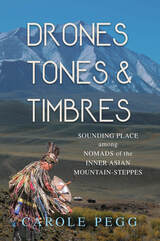 Drones, Tones, and Timbres: Sounding Place among Nomads of the Inner Asian Mountain-Steppes
Carole Pegg
University of Illinois Press, 2024 An indispensable study of the music of Altai-Sayan peoples
Based on more than twenty years of collaborative research, Carole Pegg’s long-awaited participatory ethnography explores how Indigenous nomadic peoples of Russia’s southern Siberian republics (Altai, Khakassia, Tyva) sound multiphonies of place in a post-Soviet global world. Inspired by the mountain-steppe ecology and pathways of nomadism, soundscapes created in performative ritual events cross political and multiple-world boundaries in a shamanic-animist universe, enabling human and spirit actor interactions in a series of sensuous worlds. As with the “throat-singing” for which Indigenous Altai-Sayan peoples are famous, senses of place involve sonic relations, rootedness, movement, and plurality. Pegg echoes their drone-partials musical and ontological models in an innovative theoretical entwinement. Three strands form the book’s multivocal drone, the partials of which sound in each chapter: ontological sonicality and musicality that enables emplacement and movement; the importance of shamanism-animism--at the core of Indigenous spiritual practices--for personhood and community; and the agency of sonic performances. Sounding place, Pegg demonstrates, is essential to the identities, ways of life, and very senses of being of Indigenous Altai-Sayan peoples.
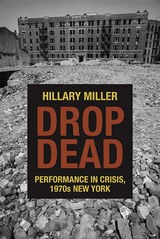 Drop Dead: Performance in Crisis, 1970s New York
Hillary Miller
Northwestern University Press, 2016 Winner, 2017 American Theater and Drama Society John W. Frick Book Award
Winner, 2017 ASTR Barnard Hewitt Award for Outstanding Research in Theater History
Hillary Miller’s Drop Dead: Performance in Crisis, 1970s New York offers a fascinating and comprehensive exploration of how the city’s financial crisis shaped theater and performance practices in this turbulent decade and beyond. New York City’s performing arts community suffered greatly from a severe reduction in grants in the mid-1970s. A scholar and playwright, Miller skillfully synthesizes economics, urban planning, tourism, and immigration to create a map of the interconnected urban landscape and to contextualize the struggle for resources. She reviews how numerous theater professionals, including Ellen Stewart of La MaMa E.T.C. and Julie Bovasso, Vinnette Carroll, and Joseph Papp of The Public Theater, developed innovative responses to survive the crisis. Combining theater history and close readings of productions, each of Miller’s chapters is a case study focusing on a company, a production, or an element of New York’s theater infrastructure. Her expansive survey visits Broadway, Off-, Off-Off-, Coney Island, the Brooklyn Academy of Music, community theater, and other locations to bring into focus the large-scale changes wrought by the financial realignments of the day. Nuanced, multifaceted, and engaging, Miller’s lively account of the financial crisis and resulting transformation of the performing arts community offers an essential chronicle of the decade and demonstrates its importance in understanding our present moment.
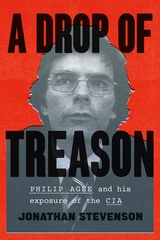 A Drop of Treason: Philip Agee and His Exposure of the CIA
Jonathan Stevenson
University of Chicago Press, 2021 Philip Agee’s story is the stuff of a John le Carré novel—perilous and thrilling adventures around the globe. He joined the CIA as a young idealist, becoming an operations officer in hopes of seeing the world and safeguarding his country. He was the consummate intelligence insider, thoroughly entrenched in the shadow world. But in 1975, he became the first such person to publicly betray the CIA—a pariah whose like was not seen again until Edward Snowden. For almost forty years in exile, he was a thorn in the side of his country.
The first biography of this contentious, legendary man, Jonathan Stevenson’s A Drop of Treason is a thorough portrait of Agee and his place in the history of American foreign policy and the intelligence community during the Cold War and beyond. Unlike mere whistleblowers, Agee exposed American spies by publicly blowing their covers. And he didn’t stop there—his was a lifelong political struggle that firmly allied him with the social movements of the global left and against the American project itself from the early 1970s on. Stevenson examines Agee’s decision to turn, how he sustained it, and how his actions intersected with world events.
Having made profound betrayals and questionable decisions, Agee lived a rollicking, existentially fraught life filled with risk. He traveled the world, enlisted Gabriel García Márquez in his cause, married a ballerina, and fought for what he believed was right. Raised a conservative Jesuit in Tampa, he died a socialist expat in Havana. In A Drop of Treason, Stevenson reveals what made Agee tick—and what made him run.
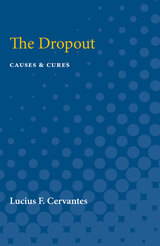 The Dropout: Causes & Cures
Lucius F. Cervantes
University of Michigan Press, 1965 Dropouts appear with the regularity of automobiles rolling off the assembly line. Secretary of Labor W. Willard Wirtz describes them as "the outlaw pack" who are "unemployed today and will be for the rest of their lives at a cost to us of $1,000 a head a year . . . ." Michael Harrington calls them "The New Lost Generation" and James B. Conant's more strikingly descriptive phrase, "social dynamite," is enough to pull every citizen up sharp. J. Edgar Hoover, in a report on the outbreak of violence in nine Northern communities, pointed his finger at the dropout, rather than racists or communists, as Public Enemy Number 1.But, how does the dropout see himself? When given a chance, what does he have to say? Has his failure to obtain a high-school diploma deprived him of full citizenship in our affluent society? Whom does he blame for his failure? If he is unable to find work, how will he live in our automated economy?In this unique and imaginative book the dropout speaks for himself. His views are compared with those of a high-school graduate having the same I.Q. and similar social and economic background. We learn how these young people feel about their families, friends, and teachers. We gain insight into many of their basic emotions and attitudes.This intensely human document lays bare the causes and cures of one of the greatest challenges ever to face our people. Reading this book is an important step toward solving the problem of the dropout. The picture that emerges is authentic, compelling, and fascinating.
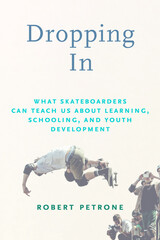 Dropping In: What Skateboarders Can Teach Us about Learning, Schooling, and Youth Development
Robert Petrone
University of Massachusetts Press, 2023 The die-hard local skateboarders of Franklin Skatepark—a group of working-class, Latino and white young men in the rural Midwest—are typically classified by schools and society as “struggling,” “at-risk,” “failing,” and “in crisis.” But at the skatepark, they thrive and succeed, not only by landing tricks but also by finding meaning and purpose in their lives. In Dropping In, Robert Petrone draws from multiple years of ethnographic research to bring readers into this rich environment, exploring how and why these young men engage more with skateboarding and its related cultural communities than with school. For them, it is in these alternative communities and spaces that they meet their intellectual, literate, and learning needs; cultivate meaningful and supportive relationships; and develop a larger understanding of their place in the world. By looking at what these skateboarders can teach us about what is right and working in their lives, Petrone asks educators and others committed to youth development to rethink schooling structures and practices to provide equitable education for all students.
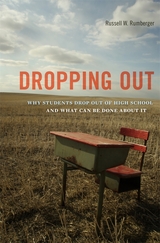 Dropping Out: Why Students Drop Out of High School and What Can Be Done About It
Russell W. Rumberger
Harvard University Press, 2012 The vast majority of kids in the developed world finish high school—but not in the United States. More than a million kids drop out every year, around 7,000 a day, and the numbers are rising. Dropping Out offers a comprehensive overview by one of the country’s leading experts, and provides answers to fundamental questions: Who drops out, and why? What happens to them when they do? How can we prevent at-risk kids from short-circuiting their futures?
Students start disengaging long before they get to high school, and the consequences are severe—not just for individuals but for the larger society and economy. Dropouts never catch up with high school graduates on any measure. They are less likely to find work at all, and more likely to live in poverty, commit crimes, and suffer health problems. Even life expectancy for dropouts is shorter by seven years than for those who earn a diploma.
Russell Rumberger advocates targeting the most vulnerable students as far back as the early elementary grades. And he levels sharp criticism at the conventional definition of success as readiness for college. He argues that high schools must offer all students what they need to succeed in the workplace and independent adult life. A more flexible and practical definition of achievement—one in which a high school education does not simply qualify you for more school—can make school make sense to young people. And maybe keep them there.
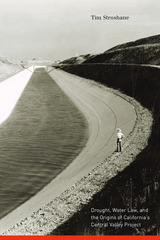 Drought, Water Law, and the Origins of California's Central Valley Project
Tim Stroshane
University of Nevada Press, 2016 This book is an account of how water rights were designed as a key part of the state’s largest public water system, the Central Valley Project. Along sixty miles of the San Joaquin River, from Gustine to Mendota, four corporate entities called “exchange contractors” retain paramount water rights to the river. Their rights descend from the days of the Miller & Lux Cattle Company, which amassed an empire of land and water from the 1850s through the 1920s and protected these assets through business deals and prolific litigation. Miller & Lux’s dominance of the river relied on what many in the San Joaquin Valley regarded as wasteful irrigation practices and unreasonable water usage. Economic and political power in California’s present water system was born of this monopoly on water control. Stroshane tells how drought and legal conflict shaped statewide economic development and how the grand bargain of a San Joaquin River water exchange was struck from this monopoly legacy, setting the stage for future water wars. His analysis will appeal to readers interested in environmental studies and public policy.
The Drowning Boy's Guide to Water
Cameron Barnett
Autumn House Press, 2017 Cameron Barnett’s poetry collection, The Drowning Boy’s Guide to Water (winner of the 2017 Rising Writer Contest), explores the complexity of race and the body for a black man in today’s America.
The Drowning Boy's Guide to Water
Cameron Barnett
Autumn House Press, 2022 Cameron Barnett’s poetry collection, The Drowning Boy’s Guide to Water (winner of the 2017 Rising Writer Contest), explores the complexity of race and the body for a black man in today’s America.
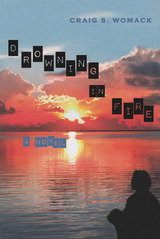 Drowning in Fire
Craig S. Womack
University of Arizona Press, 2001 Josh Henneha has always been a traveler, drowning in dreams, burning with desires. As a young boy growing up within the Muskogee Creek Nation in rural Oklahoma, Josh experiences a yearning for something he cannot tame. Quiet and skinny and shy, he feels out of place, at once inflamed and ashamed by his attraction to other boys. Driven by a need to understand himself and his history, Josh struggles to reconcile the conflicting voices he hears—from the messages of sin and scorn of the non-Indian Christian churches his parents attend in order to assimilate, to the powerful stories of his older Creek relatives, which have been the center of his upbringing, memory, and ongoing experience. In his fevered and passionate dreams, Josh catches a glimpse of something that makes the Muskogee Creek world come alive. Lifted by his great-aunt Lucille’s tales of her own wild girlhood, Josh learns to fly back through time, to relive his people’s history, and uncover a hidden legacy of triumphs and betrayals, ceremonies and secrets he can forge into a new sense of himself. When as a man, Josh rediscovers the boyhood friend who first stirred his desires, he realizes a transcendent love that helps take him even deeper into the Creek world he has explored all along in his imagination. Interweaving past and present, history and story, explicit realism and dreamlike visions, Craig Womack’s Drowning in Fire explores a young man’s journey to understand his cultural and sexual identity within a framework drawn from the community of his origins. A groundbreaking and provocative coming-of-age story, Drowning in Fire is a vividly realized novel by an impressive literary talent.
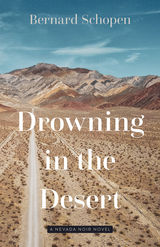 Drowning in the Desert: A Nevada Noir Novel
Bernard Schopen
University of Nevada Press, 2023 Desert stillness meets the cacophony of Las Vegas.
Norman “Fats” Rangle, an ex–deputy sheriff, operates a horse stabling and excursion business with his brother and sister-in-law on their family ranch in the small rural community of Blue Lake, a few hours outside of Las Vegas. But fate has other plans for him when, high on a southern Nevada mountain range, Fats discovers the wreckage of a plane that crashed two years earlier. Although he reports his find to the sheriff, he does not disclose that someone had already been to the crash site—evidence that Fats deliberately destroyed.
Soon, Fats is tracking back and forth between Las Vegas and Blue Lake in a search for a missing cousin, a briefcase full of cash, and, finally, for a killer. Along the way, Fats also begins to understand that he’s searching for himself and his place in a rapidly changing West.
Angry and alienated, Fats distrusts everyone he meets, from sleaze-merchants and political power brokers to two women: one he wants to believe in, a retired judge; and the other, a police sergeant, he can’t quite believe isn’t deceiving him. After all, in this Nevada, corruption is a given. Everybody lies. Much is uncertain—motives, loyalties, affections. But in Drowning in the Desert, one thing is certain: water is a precious resource that can both kill and be killed for.
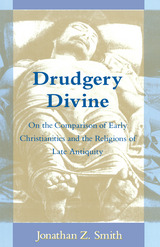 Drudgery Divine: On the Comparison of Early Christianities and the Religions of Late Antiquity
Jonathan Z. Smith
University of Chicago Press, 1990 In this major theoretical and methodological statement on the history of religions, Jonathan Z. Smith shows how convert apologetic agendas can dictate the course of comparative religious studies. As his example, Smith reviews four centuries of scholarship comparing early Christianities with religions of late Antiquity (especially the so-called mystery cults) and shows how this scholarship has been based upon an underlying Protestant-Catholic polemic. The result is a devastating critique of traditional New Testament scholarship, a redescription of early Christianities as religious traditions amenable to comparison, and a milestone in Smith's controversial approach to comparative religious studies.
"An important book, and certainly one of the most significant in the career of Jonathan Z. Smith, whom one may venture to call the greatest pathologist in the history of religions. As in many precedent cases, Smith follows a standard procedure: he carefully selects his victim, and then dissects with artistic finesse and unequaled acumen. The operation is always necessary, and a deconstructor of Smith's caliber is hard to find."—Ioan P. Coulianu, Journal of Religion
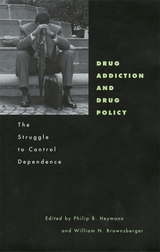 Drug Addiction and Drug Policy: The Struggle to Control Dependence
Philip B. Heymann
Harvard University Press, 2001 This book is the culmination of five years of impassioned conversations among distinguished scholars in law, public policy, medicine, and biopsychology, about the most difficult questions in drug policy and the study of addictions. As these intensely argued chapters show, the obvious answers are always alluring but frequently wrong.
Do drug addicts have an illness, or is their addiction under their control? Should they be treated as patients, or as criminals? Challenging the conventional wisdom in both the psychiatric community and the enforcement community, the authors show the falsity of these standard dichotomies. They argue that the real question is how coercion and support can be used together to steer addicts toward productive life.
Written in clear and forceful language, without ideological blinkers and with close attention to empirical data, this book has something to teach both novice and expert in the fields of drug addiction and drug policy. The authors' resistance to sloganeering from right or left will raise the quality of public discussion of a complex issue, and contribute to the management of one of the most painful and enduring problems of American society.
 Drug Cartels Do Not Exist: Narcotrafficking in US and Mexican Culture
Oswaldo Zavala
Vanderbilt University Press, 2022 Through political and cultural analysis of representations of the so-called war on drugs, Oswaldo Zavala makes the case that the very terms we use to describe drug traffickers are a constructed subterfuge for the real narcos: politicians, corporations, and the military. Immigration has endured as a prevailing news topic, but it is a fixture of modern society in the neoliberal era; the future will be one of exile brought on by state violence and the plundering of our natural resources to sate capitalist greed.
Yet the realities of violence in Mexico and along the border are obscured by the books, films, and TV series we consume. In truth, works like Sicario, The Queen of the South, and Narcos hide Mexico's political realities. Alongside these examples, Zavala discusses Charles Bowden, 2666 by Roberto Bolaño, and other important Latin American writers as examples of those who do capture the realities of the drug war.
Translated into English by William Savinar, Drug Cartels Do Not Exist will be useful for journalists, political scientists, philosophers, and writers of any kind who wish to break down the constructed barriers—physical and mental—created by those in power around the reality of the Mexican drug trade.
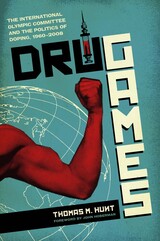 Drug Games: The International Olympic Committee and the Politics of Doping, 1960–2008
By Thomas M. Hunt
University of Texas Press, 2011 On August 26, 1960, twenty-three-year-old Danish cyclist Knud Jensen, competing in that year's Rome Olympic Games, suddenly fell from his bike and fractured his skull. His death hours later led to rumors that performance-enhancing drugs were in his system. Though certainly not the first instance of doping in the Olympic Games, Jensen's death serves as the starting point for Thomas M. Hunt's thoroughly researched, chronological history of the modern relationship of doping to the Olympics. Utilizing concepts derived from international relations theory, diplomatic history, and administrative law, this work connects the issue to global political relations. During the Cold War, national governments had little reason to support effective anti-doping controls in the Olympics. Both the United States and the Soviet Union conceptualized power in sport as a means of impressing both friends and rivals abroad. The resulting medals race motivated nations on both sides of the Iron Curtain to allow drug regulatory powers to remain with private sport authorities. Given the costs involved in testing and the repercussions of drug scandals, these authorities tried to avoid the issue whenever possible. But toward the end of the Cold War, governments became more involved in the issue of testing. Having historically been a combined scientific, ethical, and political dilemma, obstacles to the elimination of doping in the Olympics are becoming less restrained by political inertia.
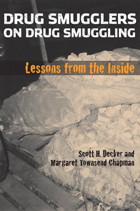 Drug Smugglers on Drug Smuggling: Lessons from the Inside
Scott H. Decker and Margaret Townsend Chapman
Temple University Press, 2008 Drug Smugglers on Drug Smuggling features interviews with 34 convicted drug smugglers -- most of them once major operators -- detailing exactly how drugs are smuggled into the U.S. from Latin America. These sources provide tangible evidence of the risks, rewards, and organization of international drug smuggling.
Quoting frequently from their interviews, Decker and Chapman explain how individuals are recruited into smuggling, why they stay in it, and how their roles change over time. They describe the specific strategies their interviewees employed to bring drugs into the country and how they previously escaped apprehension. Over-all, the authors find that drug smuggling is organized in a series of networks which are usually unconnected.
This extraordinarily informative book will be of particular interest to law enforcement officials and policymakers, but it will appeal to anyone who wants to know how the drug business actually works.
The Drug, the Soul, and God: A Catholic Moral Perspective on Antidepressants
John-Mark Miravalle
University of Scranton Press, 2010 With The Drug, the Soul, and God, John-Mark Miravelle examines the stance of the Catholic Church regarding the prescription and consumption of antidepressants. After a careful investigation of Catholic moral theology and philosophy, Miravelle argues that treating depression with medication alone fails to address the underlying causes of the depression and does not facilitate the cognitive, interpersonal, and environmental changes necessary for a patient’s long-term health. In addition, he suggests that such medication may deprive sufferers of providential opportunities for personal and communal conversion and sanctification. This controversial volume will engage theologians and medical professionals alike.
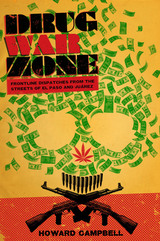 Drug War Zone: Frontline Dispatches from the Streets of El Paso and Juárez
By Howard Campbell
University of Texas Press, 2009 Winner, Southwest Book Award, Border Regional Library Association, 2011 Thousands of people die in drug-related violence every year in Mexico. Ciudad Juárez, Chihuahua, adjacent to El Paso, Texas, has become the most violent city in the Mexican drug war. Much of the cocaine, marijuana, and methamphetamine consumed in the United States is imported across the Mexican border, making El Paso/Juárez one of the major drug-trafficking venues in the world. In this anthropological study of drug trafficking and anti-drug law enforcement efforts on the U.S.-Mexico border, Howard Campbell uses an ethnographic perspective to chronicle the recent Mexican drug war, focusing especially on people and events in the El Paso/Juárez area. It is the first social science study of the violent drug war that is tearing Mexico apart. Based on deep access to the drug-smuggling world, this study presents the drug war through the eyes and lives of direct participants. Half of the book consists of oral histories from drug traffickers, and the other half from law enforcement officials. There is much journalistic coverage of the drug war, but very seldom are the lived experiences of traffickers and "narcs" presented in such vivid detail. In addition to providing an up-close, personal view of the drug-trafficking world, Campbell explains and analyzes the functioning of drug cartels, the corruption that facilitates drug trafficking, the strategies of smugglers and anti-narcotics officials, and the perilous culture of drug trafficking that Campbell refers to as the "Drug War Zone."
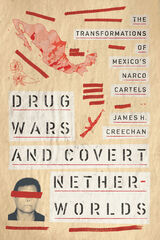 Drug Wars and Covert Netherworlds: The Transformations of Mexico's Narco Cartels
James H. Creechan
University of Arizona Press, 2021 The popular history of narco-Mexico has long been narrowly framed by the U.S. “War on Drugs.” Stereotypes overemphasize the criminal agency of celebrity drug lords. Common understanding of the narco world is rooted in mythology and misunderstanding, and the public narrative has consistently downplayed links to respected individuals and legitimate society.
In Drug Wars and Covert Netherworlds sociologist and criminologist James H. Creechan draws on decades of research to paint a much more nuanced picture of the transformation of Mexico’s narco cartels. Creechan details narco cartel history, focusing on the decades since Richard Nixon declared the War on Drugs. With sobering detail, Creechan unravels a web of government dependence, legitimate enterprises, covert connections, and violent infighting. He details how drug smuggling organizations have grown into powerful criminal mafias with the complicit involvement of powerful figures in civil society to create covert netherworlds.
Mexico is at a moment of change—a country on the verge of transition or perdition. It can only move forward by examining its history of narco-connections spun and re-spun over the last fifty years.
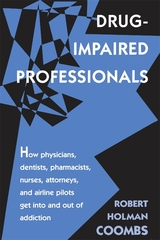 Drug-Impaired Professionals
Robert Holman Coombs
Harvard University Press "I started out snorting a couple of lines a night and ended up injecting and snorting about three grams a day."--That could be your dentist talking.
"I worked a lot with hangovers and made lots of mistakes when coming down off acid."--That might be your nurse.
"The patient was waking up and I was out cold."--And that was some unlucky patient's anesthesiologist.
Professionals trusted with our well-being are the last people we suspect of drug addiction. And yet they are at least as likely as anyone else to abuse alcohol and other drugs--a well-kept secret finally aired and fully examined in this powerful book. Drawing on more than 120 personal interviews with addicted physicians, dentists, nurses, pharmacists, attorneys, and airline pilots and those who treat them, Robert Coombs gives us a startling picture of drug abuse among "pedestal professionals." He discusses addiction as an occupational hazard for those with the easiest access to drugs, the greatest sense of immunity to their perils, and the most extensive means (and reasons) for hiding their problems. Throughout, the interviewees' eloquent and often harrowing testimony reminds us of the human drama behind the exhaustive research and analysis presented here. Their bittersweet stories bear out Coombs's contention that recovering addicts, free of their magical elixirs, can become more complete people than they were before addiction.
From the biological, psychosocial, and spiritual roots of addiction to the equally diverse approaches to recovery, to the merits and failures of government drug policy, Drug-Impaired Professionals offers a clear and complete overview of a complex problem that affects nearly every family in America.
 Drugs and Foods from Little-Known Plants: Notes in Harvard University Herbaria
Siri von Reis Altschul
Harvard University Press, 1973 The medicinal properties of plants have been of interest to society for centuries and continue to be a subject of modern research. Yet too often research has been predicated upon poorly identified plant material and secondary sources of information. Much of what we know about the use of plants as drugs, poisons, foods, and as instruments of magical or religious practice derives from lore inherited from the clay tablets and papyri of the ancients and from compilations of early Greek, Arabic, and Indian physicians. Meanwhile, information pertaining to plant parts used even now in the daily life of peoples far removed from the influence of modern medical and health practices has been largely overlooked.
With the encroachment of civilized cultures on primitive societies, unique traditions—often unwritten—are being destroyed. In many instances, the very plants involved are disappearing. Not infrequently, the only record, where one exists at all, of these vanishing pools of knowledge is that of the botanical field worker. For no matter what chemical or biological investigations may follow, the botanist can affix to an actual specimen, as he collects it in the field, the local terms applied to the plant and a description of native medicinal or other uses.
Dr. Altschul has compiled field notes of health and medical interest on over 5,000 species of plants, culled from some 2,500,000 specimens of higher plants collected by field botanists from all over the world and deposited in the combined collections of the Arnold Arboretum and Gray Herbarium of Harvard University. The resulting catalogue represents a unique approach to supplying new investigational leads to researchers seeking biologically active plant principles. Dr. Altschul's meticulous sheet&ndashby–sheet examination of the Harvard collections provides the pharmacognosist, pharmacologist, and others in the medical and health sciences with an extensive firsthand survey of the domestic medicines of many cultures.
These previously unpublished botanists' notes are here made available in a comprehensive publication that should become an important resource for every investigation into the area of medicinal phytochemistry. Indexes to families and genera are provided, as well as a medical index referring to diseases and to therapeutic properties for researchers intent on locating plants with special medicinal capacities. The author is a Research Fellow at the Botanical Museum of Harvard University.
 Drugs for Life: How Pharmaceutical Companies Define Our Health
Joseph Dumit
Duke University Press, 2012 Every year the average number of prescriptions purchased by Americans increases, as do healthcare expenditures, which are projected to reach one-fifth of the U.S. gross domestic product by 2020. In Drugs for Life, Joseph Dumit considers how our burgeoning consumption of medicine and cost of healthcare not only came to be, but also came to be taken for granted. For several years, Dumit attended pharmaceutical industry conferences; spoke with marketers, researchers, doctors, and patients; and surveyed the industry's literature regarding strategies to expand markets for prescription drugs. He concluded that underlying the continual growth in medications, disease categories, costs, and insecurity is a relatively new perception of ourselves as inherently ill and in need of chronic treatment. This perception is based on clinical trials that we have largely outsourced to pharmaceutical companies. Those companies in turn see clinical trials as investments and measure the value of those investments by the size of the market and profits that they will create. They only ask questions for which the answer is more medicine. Drugs for Life challenges our understanding of health, risks, facts, and clinical trials, the very concepts used by pharmaceutical companies to grow markets to the point where almost no one can imagine a life without prescription drugs.
Drugs in Afghanistan: Opium, Outlaws and Scorpion Tales
David Macdonald
Pluto Press, 2007 Afghanistan is the world's largest producer of opium and heroin. This book explores the devastating impact that the drugs trade has had on the Afghan people.
Author David Macdonald has worked as a drugs advisor to the UN. Based on his extensive experience, this book breaks down the myths surrounding the cultivation and consumption of drugs, providing a detailed analysis of the history of drug use within the country. He examines the impact of over 25 years of continuous conflict, and shows how poverty and instability has led to an increase in drugs consumption. He also considers the recent rise in the use of pharmaceutical drugs, resulting in dangerous chemical cocktails and analyses the effect of Afghanistan's drug trade on neighbouring countries.
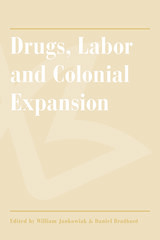 Drugs, Labor and Colonial Expansion
William Jankowiak
University of Arizona Press, 2003 The emergence of European powers on the world scene after the fifteenth century brought with it more than the subjugation of colonized peoples; it also brought an increase in the market for drugs, which until then had seen little distribution beyond their lands of origin. Growth in trade required goods for which there was demand, and drugs filled that role neatly. This book explores how Europeans introduced and used drugs in colonial contexts for the exploitation and placation of indigenous labor. Combining history and anthropology, it examines the role of drugs in trade and labor during the age of western colonial expansion. From considering the introduction of alcohol in the West African slave trade to the use of coca as a labor enhancer in the Andes, these original contributions examine both the encouragement of drug use by colonial powers and the extent to which local peoples' previous experience with psychoactive substances shaped their use of drugs introduced by Europeans. The authors show that drugs possessed characteristics that made them a particularly effective means for propagating trade or increasing the extent and intensity of labor. In the early stages of European expansion, drugs were introduced to draw people, quite literally, into relations of dependency with European trade partners. Over time, the drugs used to intensify the amount and duration of labor shifted from alcohol, opium, and marijuana—which were used to overcome the drudgery and discomfort of physical labor—to caffeine-based stimulants, which provided a more alert workforce. Valuable not only for its ethnographic detail but also for its broader insight into the nature of capitalist expansion, this collection reveals the surprising consistency of drug use in the colonial process. Drugs, Labor and Colonial Expansion is a book rich with cross-cultural insights that ranges widely across disciplines to provide a new and needed look at the colonial experience.
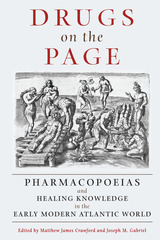 Drugs on the Page: Pharmacopoeias and Healing Knowledge in the Early Modern Atlantic World
Mathew Crawford and Joseph Gabriel
University of Pittsburgh Press, 2019 In the early modern Atlantic World, pharmacopoeias—official lists of medicaments and medicinal preparations published by municipal, national, or imperial governments—organized the world of healing goods, giving rise to new and valuable medical commodities such as cinchona bark, guaiacum, and ipecac. Pharmacopoeias and related texts, developed by governments and official medical bodies as a means to standardize therapeutic practice, were particularly important to scientific and colonial enterprises. They served, in part, as tools for making sense of encounters with a diversity of peoples, places, and things provoked by the commercial and colonial expansion of early modern Europe.
Drugs on the Page explores practices of recording, organizing, and transmitting information about medicinal substances by artisans, colonial officials, indigenous peoples, and others who, unlike European pharmacists and physicians, rarely had a recognized role in the production of official texts and medicines. Drawing on examples across various national and imperial contexts, contributors to this volume offer new and valuable insights into the entangled histories of knowledge resulting from interactions and negotiations between Europeans, Africans, and Native Americans from 1500 to 1850.
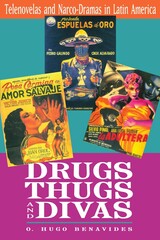 Drugs, Thugs, and Divas: Telenovelas and Narco-Dramas in Latin America
By O. Hugo Benavides
University of Texas Press, 2008 Soap opera speaks a universal language, presenting characters and plots that resonate far beyond the culture that creates them. Latin American soap operas—telenovelas—have found enthusiastic audiences throughout the Americas and Europe, as well as in Egypt, Russia, and China, while Mexican narco-dramas have become highly popular among Latinos in the United States. In this first comprehensive analysis of telenovelas and narco-dramas, Hugo Benavides assesses the dynamic role of melodrama in creating meaningful cultural images to explain why these genres have become so successful while more elite cultural productions are declining in popularity. Benavides offers close readings of the Colombian telenovelas Betty la fea (along with its Mexican and U.S. reincarnations La fea más bella and Ugly Betty), Adrián está de visita, and Pasión de gavilanes; the Brazilian historical telenovela Xica; and a variety of Mexican narco-drama films. Situating these melodramas within concrete historical developments in Latin America, he shows how telenovelas and narco-dramas serve to unite peoples of various countries and provide a voice of rebellion against often-oppressive governmental systems. Indeed, Benavides concludes that as one of the most effective and lucrative industries in Latin America, telenovelas and narco-dramas play a key role in the ongoing reconfiguration of social identities and popular culture.
 Drumbeats, Masks, and Metaphor: Contemporary Afro-American Theatre
Geneviève Fabre
Harvard University Press, 1983 Contemporary Afro–American theatre is an exciting spectacle of an emerging black identity during a period when blacks have come to the forefront of political activity in the United States. Geneviève Fabre brings us the vast and rich production of black drama since 1945, placing it in historical and cultural context as a platform for political statement. Two strains emerge: the militant theatre of protest, and the ethnic theatre of black experience.
Militant theatre breaks free from dominant white traditions and seeks to mobilize members of the community into common action. Masks and metaphors assume their fullest meaning: when the “white masks” are torn off, “black skins” suddenly appear. At first a shout of anger and of challenge, the militant theatre later becomes an almost visionary world. The Pike of LeRoi Jones/Amiri Baraka rise like clenched fists. Among the other dramatists of militant theatre are Douglas Turner Ward, Ted Shine, Ben Caldwell, and Sonia Sanchez. We see their plays that examine relations between blacks and whites; stories of victims and rebels and traitors; and rituals of vengeance.
In contrast to the didactic speech of the militant theatre, the theatre of experience develops out of a dialogue in the language of blacks about their own experience. It embraces the rituals of daily life: the liturgy of the black church, traditional music, and folklore. This theatre celebrates a vital culture existing outside the boundaries of the dominant society. We hear the voice of the blues and the rhetoric of religion, we see depictions of the family and the street world of the ghetto, as well as the time–honored art of the trickster. James Baldwin, Ed Bullins, Melvin Van Peebles, and Edgar White are among the playwrights shown making extensive use of black cultural traditions.
Fabre is the first to attempt such an ambitious assessment of contemporary black theatre, one that evaluates its development as well as individual authors, plays, and performances, and also defines the growth of a distinctive and thriving theatrical tradition.
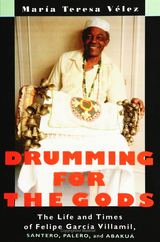 Drumming For The Gods
Maria Velez
Temple University Press, 2000 "I am Felipe Garcia Villamil" begins Drumming for the Gods, the life history of the Afro-Cuban artist whose music has survived both political and personal upheaval. "Balogun for thirty years. Oluana, of Matanzas, Cuba, for about forty years. Omoana for almost forty-five years. OluIyesa [he knows the secrets of the Iyesa drums]." A practitioner of sacred drumming for almost his entire life, Felipe practiced his trade in Cuba both before and after the Revolution and brought it with him to New York, where he continues to play for the gods.
This book focuses on three periods of Felipe's life, each marked by changes in his personal life and by important historical events. The first period covers his formative years during which he received his initial training. Through Felipe's story, we explore the legacy of slavery in Cuba, the nature of Afro-Cuban religions and their musical traditions, and the history of bata drums. The second period covers the critical years of the Cuban Revolution. Here we see the effect of social turmoil both n music and religious practice (santero, palero, and abakua). The third period covers Felipe's life in New York as a refugee/immigrant, and the role of music in rebuilding his identity. Felipe's story illuminates his cultural practices and beliefs as well as the ways in which an individual musician selects and modifies the elements of his cultural heritage to create a voice that is personal and unique. Felipe not only lives through history but also makes history, shaping an identity that cannot be described as "Cuban immigrant," "Afro-Cuban," "religious drummer," or "santeria initiate," but is composed of all of them.
Through Felipe's experiences, Maria Teresa Velez reveals the interaction between social, political, economic, and cultural forces and an individual's own actions. The professionalization of musicians in Cuba following the Revolution and the plight of Afro-Cuban immigrants in New York are seen as large historical and social problems to which Felipe must personally respond. A noted ethnomusicologist, Velez provides the most insightful and comprehensive English-language study of an individual Cuban religious drummer available.
Drumming for the Gods is a must-read for those interested in ethnomusicology, Caribbean studies, and Afro-Cuban religions and culture.
Drums In The Forest: Decision At The Forks
Alfred Proctor James
University of Pittsburgh Press, 1958 Originally published to commemorate the bicentennial of Pittsburgh's founding, Drums in the Forest is reissued to mark the 250th anniversary of the French and Indian War. It comprises two parts: the first, by Alfred Proctor James, provides the historical background leading up to the capture of Fort Duquesne by the British; the second, by Charles Morse Stotz, is a description of the five forts built at the forks of the Ohio between 1754 and 1815.
 The Drums of the 47th
Robert J. Burdette
University of Illinois Press, 2000 This eloquent memoir records the Civil War experiences of Robert J. Burdette, private in the 47th Illinois Infantry Regiment.
From Peoria to Corinth, from Corinth to Vicksburg, up the Red River country, down to Mobile and Fort Blakely, and back to Tupelo and Selma, the 47th marched three thousand miles during Burdette's tour, from March 1862 to December 1864.
In a literate voice rare in war memoirs, Burdette speaks of comradeship built and tested, the noise and confusion of the battlefield, the conflicting feelings of witnessing a military execution. Both nostalgic and piercingly immediate, his remembrances evoke the sights, sounds, smells, and above all the inner feelings stirred up by war, from exuberance to terror and from patriotic fervor to compassion for a fallen enemy.
Originally published--on the eve of another great conflict--in 1914, The Drums of the 47th is a moving depiction of the inner life of the common soldier. Like Stephen Crane's The Red Badge of Courage, Burdette's book puts a human face on the war and his words speak to all who have served or imagined serving under fire. The introduction by John E. Hallwas provides a biographical sketch of Burdette and a commentary on his engaging Civil War memoir.
Drunk Driving: An American Dilemma
James B. Jacobs
University of Chicago Press, 1989 In this ambitious interdisciplinary study, James B. Jacobs provides the first comprehensive review and analysis of America's drunk driving problem and of America's anti-drunk driving policies and jurisprudence. In a clear and accessible style, he considers what has been learned, what is being done, and what constitutional limits exist to the control and enforcement of drunk driving.
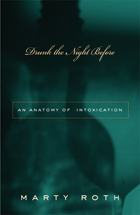 Drunk the Night Before: An Anatomy of Intoxication
Marty Roth
University of Minnesota Press, 2005 This invigorating work traces the cultural history of convivial drinking before the concept of addiction overshadowed intoxication's reputation as a creative, philosophical, and spiritual force. Marty Roth's Drunk the Night Before illustrates altered consciousness from myth to contemporary life, laying bare the behaviors and beliefs, sacred and secular, invested in intoxication. From the days of antiquity to the twentieth century, Roth follows the often veiled language of intoxication through religion and aesthetics, poetry and art, popular festivals and film. In this sweeping work, he examines the cultural roots of love potions and the fountain of youth, drunkenness in Hollywood cinema, the religious concept of a spiritual high versus the condemnation of intoxication. Roth reinvigorates the currently rebuffed connection between intoxication and artistic creativity, taking up by turn the poet Anacreon and the canon of drink poetry - from classical Greek to the European lyric, Euripides' Bacchae and the figure of Socrates in Plato's Symposium, the heavy investment of Western philosophy in intoxication, and the concepts of the carnivalesque in Friedrich Nietzsche and Mikhail Bakhtin. At once deeply erudite and irresistibly congenial, this encyclopedic work makes critical sense of the long history of alcohol as potion and poison, as pharmakon and catalyst, revealing altered states as the hidden thread in the story of sensation and Western cultural consciousness.
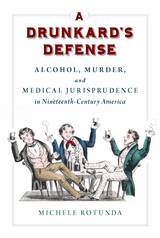 A Drunkard's Defense: Alcohol, Murder, and Medical Jurisprudence in Nineteenth-Century America
Michele Rotunda
University of Massachusetts Press, 2021 Is drunkenness a defense for murder? In the early nineteenth century, the answer was a resounding no. Intoxication was considered voluntary, and thus provided no defense. Yet as the century progressed, American courts began to extend exculpatory value to heavy drinking. The medicalization of alcohol use created new categories of mental illness which, alongside changes in the law, formed the basis for defense arguments that claimed unintended consequences and lack of criminal intent. Concurrently, advocates of prohibition cast “demon rum” and the “rum-seller” as the drunkard's accomplices in crime, mitigating offenders' actions. By the postbellum period, a backlash, led by medical professionals and an influential temperance movement, left the legacy of an unsettled legal standard.
In A Drunkard's Defense, Michele Rotunda examines a variety of court cases to explore the attitudes of nineteenth-century physicians, legal professionals, temperance advocates, and ordinary Americans toward the relationship between drunkenness, violence, and responsibility, providing broader insights into the country's complicated relationship with alcohol.
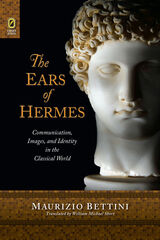 The Drunken Duchess of Vassar: Communication, Images, and Identity in the Classical World
Maurizio Bettini
Ohio State University Press, 2011 Though in many respects similar to us moderns, the Greeks and Romans often conceived things differently than we do. The cultural inheritance we have received from them can therefore open our eyes to many “manners of life” we might otherwise overlook. The ancients told fascinating—but different—stories; they elaborated profound—but different—symbols. Above all, they confronted many of the problems we still face today—memory and forgetfulness; identity and its strategies; absolutist moralism and behavioral relativity—only in profoundly different ways, since their own cultural forms and resources were different. In The Ears of Hermes: Communication, Images, and Identity in the Classical World, renowned scholar and author Maurizio Bettini explores these different cultural experiences, choosing paths through this territory that are diverse and sometimes unexpected: a little-known variant of a myth or legend, such as that of Brutus pretending, like Hamlet, to be a Fool; a proverb, like lupus in fabula (the wolf in the tale), that expresses the sense of foreboding aroused by the sudden arrival of someone who was just the subject of conversation; or great works, like Plautus’ Amphitruo and Vergil’s Aeneid, where we encounter the mysteries of the Doppelgänger and of “doubles” fabricated to ease the pain of nostalgia. Or the etymology of a word—its own “story”—leads us down some unforeseen avenue of discovery. While scholarly in presentation, this book, in an elegant English translation by William Michael Short, will appeal not only to classicists but also students, as well as to anthropologists and historians of art and literature beyond classics.
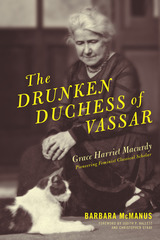 The Drunken Duchess of Vassar: Grace Harriet Macurdy, Pioneering Feminist Classical Scholar
Barbara McManus
Ohio State University Press, 2017 In this biography, Barbara McManus recovers the intriguing life story of Grace Harriet Macurdy (1866–1946), Professor of Greek at Vassar College and the first woman classicist to focus her scholarship on the lives of ancient Greco-Roman women. Fondly known as “the Drunken Duchess,” although she never drank alcohol, Macurdy came from a poor family with no social, economic, or educational advantages. Moreover, she struggled with disability for decades after becoming almost totally deaf in her early fifties. Yet she became an internationally known Greek scholar with a long list of publications and close friends as renowned as Gilbert Murray and John Masefield. Through Macurdy’s eyes and experiences, McManus examines significant issues and developments from the late nineteenth to the mid-twentieth century, such as the opening of higher education to women, the erosion of gender and class barriers in the professions, the delicate balancing act between personal and professional life required of women, the marginalized role of women’s colleges in academic politics, and changes in the discipline and profession of Classics in response to the emerging role of women and new social conditions.
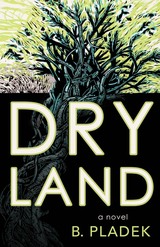 Dry Land
B. Pladek
University of Wisconsin Press, 2023 As the Great War rages across Europe, Rand Brandt, an idealistic young forester in the northwoods of Wisconsin, discovers a remarkable gift: his touch can grow any plant in minutes. Overjoyed, he dreams of devoting his life to conservation, restoring to its former glory a landscape devastated by lumbering. At night, Rand tests his powers, pushing his physical limits and revealing his secret only to his lover, Gabriel. But his frequent absences from camp don’t go unnoticed, and it isn’t long before Rand is drafted to grow timber for the war effort. Along with Gabriel, he’s shipped to France—though the army is a dangerous place for two men in love.
While at camp, Rand also realizes the true price of his gift: everything he grows withers and dies, leaving the soil empty of all living matter. Horrified, he throws himself into ever more self-destructive trials, buckling under the pressure of so many secrets. In order to survive, he must confront the terrifying possibility that his gift is actually a curse, upending everything he believes about nature, love, and himself.
 Dry: Life Without Water
Ehsan Masood
Harvard University Press, 2006 Water is in the air we breathe and beneath the ground we walk on. The very substance of life, it makes up as much as 60 percent of the human body. And yet, for one billion people there is such a thing as life without water. These are the people we meet in Dry--those who live in the dry lands of Africa, Asia, the Pacific, and the Americas, eking out an existence at once remarkable and mundane between craggy mountains, near oases, or close to well-springs surrounded by cracked earth or shifting sands.
From the ingenuity of the highland people of Chile's Atacama desert who use giant nets to capture water from clouds of fog, to the ancient wisdom that protects the grazing lands of Kenya's Masai, this beautifully illustrated book tells the diverse stories about people in very hot, very cold, or very high places, who spend their lives collecting, chasing, piping, and trapping the water that life requires--all the while taking great care that no form of life, plant or animal, benefits at the expense of another.
In a world of finite resources, where the struggle for shrinking sources of water intensifies daily, these stories--collected over three years by photographers, writers, and scientists from four continents--are a source of hope and wonder. This book contains a wealth of information and images designed to further awareness of the vast array of life that is carried on precariously yet proudly on the earth's dryest lands.
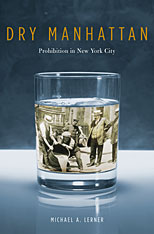 Dry Manhattan: Prohibition in New York City
Michael A. Lerner
Harvard University Press, 2007 In 1919, the United States embarked on the country’s boldest attempt at moral and social reform: Prohibition. The 18th Amendment to the Constitution prohibited the manufacture, transportation, and sale of alcohol around the country. This “noble experiment,” as President Hoover called it, was intended to usher in a healthier, more moral, and more efficient society. Nowhere was such reform needed more, proponents argued, than in New York City—and nowhere did Prohibition fail more spectacularly. Dry Manhattan is the first major work on Prohibition in nearly a quarter century, and the only full history of Prohibition in the era’s most vibrant city.
Though New Yorkers were cautiously optimistic at first, Prohibition quickly degenerated into a deeply felt clash of cultures that utterly transformed life in the city. Impossible to enforce, the ban created vibrant new markets for illegal alcohol, spawned corruption and crime, fostered an exhilarating culture of speakeasies and nightclubs, and exposed the nation’s deep prejudices. Writ large, the conflict over Prohibition, Michael Lerner demonstrates, was about much more than the freedom to drink. It was a battle between competing visions of the United States, pitting wets against drys, immigrants against old stock Americans, Catholics and Jews against Protestants, and proponents of personal liberty against advocates of societal reform.
In his evocative history, Lerner reveals Prohibition to be the defining issue of the era, the first major “culture war” of the twentieth century, and a harbinger of the social and moral debates that divide America even today.
 Dry Place: Landscapes Of Belonging And Exclusion
Patricia L. Price
University of Minnesota Press, 2004 Gathers tales from the Southwestern United States and Northern Mexico to understand the relationship between people and place in a borderland Landscape is the space of negotiation between human beings and the physical world, and rarely are the negotiations more complex and subtle than those conducted through the desert landscape along the Mexico-U.S. border. Patricia L. Price views the shaping of the landscape on and around the border through various narratives that have sought to establish claims to these dry lands. Most prominent are the accounts of Anglo-American expansionism and Manifest Destiny juxtaposed with the Chicano nationalist tale of Aztlán in the twentieth century, all constituting collective, contending claims to the U.S. Southwest. Demonstrating how stories can become vehicles for changing places and identities, Price considers characters old and new who inhabit the contemporary borderlands between Mexico and the United States—ranging from longstanding manifestations of good and evil in the figures of the Virgin of Guadalupe and the Devil to a collection of lay saints embodying current concerns. Dry Place weaves together theoretical insights with field-based inquiry, autobiography, and creative writing to arrive at a textured understanding of the bordered landscape of late modern subjectivity.
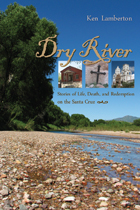 Dry River: Stories of Life, Death, and Redemption on the Santa Cruz
Ken Lamberton
University of Arizona Press, 2011 Poet and writer Alison Deming once noted, “In the desert, one finds the way by tracing the aftermath of water . . . ”
Here, Ken Lamberton finds his way through a lifetime of exploring southern Arizona’s Santa Cruz River. This river—dry, still, and silent one moment, a thundering torrent of mud the next—serves as a reflection of the desert around it: a hint of water on parched sand, a path to redemption across a thirsty landscape.
With his latest book, Lamberton takes us on a trek across the land of three nations—the United States, Mexico, and the Tohono O’odham Nation—as he hikes the river’s path from its source and introduces us to people who draw identity from the river—dedicated professionals, hardworking locals, and the author’s own family. These people each have their own stories of the river and its effect on their lives, and their narratives add immeasurable richness and depth to Lamberton’s own astute observations and picturesque descriptions.
Unlike books that detail only the Santa Cruz’s decline, Dry River offers a more balanced, at times even optimistic, view of the river that ignites hope for reclamation and offers a call to action rather than indulging in despair and resignation. At once a fascinating cultural history lesson and an important reminder that learning from the past can help us fix what we have damaged, Dry River is both a story about the amazing complexity of this troubled desert waterway and a celebration of one man’s lifelong journey with the people and places touched by it.
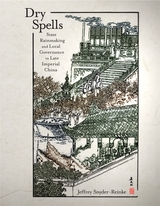 Dry Spells: State Rainmaking and Local Governance in Late Imperial China
Jeffrey Snyder-Reinke
Harvard University Press, 2009 Chinese officials put considerable effort into managing the fiscal and legal affairs of their jurisdictions, but they also devoted significant time and energy to performing religious rituals on behalf of the state. This groundbreaking study explores this underappreciated aspect of Chinese political life by investigating rainmaking activities organized or conducted by local officials in the Qing dynasty. Using a wide variety of primary sources, this study explains how and why state rainmaking became a prominent feature of the late imperial religious landscape. It also vividly describes the esoteric, spectacular, and occasionally grotesque techniques officials used to pray for rain. Charting the ways in which rainmaking performances were contested by local communities, this study argues that state rainmaking provided an important venue where the relationship between officials and their constituents was established and maintained. For this reason, the author concludes that official rainmaking was instrumental in constituting state power at the local level. This monograph addresses issues that are central to the study of late imperial Chinese society and culture, including the religious activities of Chinese officials, the nature of state orthodoxy, and the symbolic dimensions of local governance.
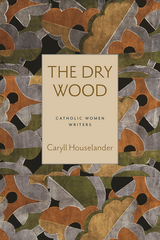 The Dry Wood
Caryll Houselander
Catholic University of America Press, 2021 In the English-speaking world, the Catholic Literary Revival is typically associated with the work of G. K. Chesterton/Hilaire Belloc, Evelyn Waugh and Graham Greene. But in fact the Revival’s most numerous members were women. While some of these women remain well known⎯Muriel Spark, Antonia White, Flannery O’Connor, Dorothy Day - many have been almost entirely forgotten. They include: Enid Dinnis, Anna Hanson Dorsey, Alice Thomas Ellis, Eleanor Farjeon, Rumer Godden, Caroline Gordon, Clotilde Graves, Caryll Houselander, Sheila Kaye-Smith, Jane Lane, Marie Belloc Lowndes, Alice Meynell, Kathleen Raine, Pearl Mary Teresa Richards, Edith Sitwell, Gladys Bronwyn Stern, Josephine Ward, and Maisie Ward.
There are various reasons why each of these writers fell out of print: changes in the commercial publishing world after World War II, changes within the Church itself and in the English-speaking universities that redefined the literary canon in the last decades of the 20th century. Yet it remains puzzling that a body of writing so creative, so attuned to its historical moment, and so unique in its perspective on the human condition, should have fallen into obscurity for so long.
The Catholic Women Writers series brings together the English-language prose works of Catholic women from the 19th and 20th centuries; work that is of interest to a broad range of readers. Each volume is printed with an accessible but scholarly introduction by theologians and literary specialists.
The first volume in the series is Caryll Houselander’s The Dry Wood. Houselander is known primarily for her spiritual writings but she also wrote one novel, set in a post-war London Docklands parish. There a motley group of lost souls are mourning the death of their saintly priest and hoping for the miraculous healing of a vulnerable child whose gentleness in the face of suffering brings conversion to them all in surprising and unexpected ways. The Dry Wood offers a vital contribution to the modern literary canon and a profound meditation on the purpose of human suffering.
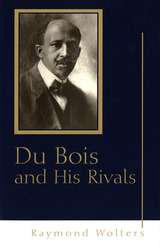 Du Bois and His Rivals
Raymond Wolters
University of Missouri Press, 2002 W. E. B. Du Bois was the preeminent black scholar of his era. He was also a principal founder and for twenty-eight years an executive officer of the nation’s most effective civil rights organization, the National Association for the Advancement of Colored People (NAACP). Even though Du Bois was best known for his lifelong stance against racial oppression, he represented much more. He condemned the racism of the white world but also criticized African Americans for mistakes of their own. He opposed segregation but had reservations about integration. Today he would be known as a pluralist. In Du Bois and His Rivals, Raymond Wolters provides a distinctive biography of this great pioneer of the American civil rights movement. Readers are able to follow the outline of Du Bois’s life, but the book’s main emphasis is on discrete scenes in his life, especially the controversies that pitted Du Bois against his principal black rivals. He challenged Booker T. Washington because he could not abide Washington’s conciliatory approach toward powerful whites. At the same time, Du Bois’s pluralism led him to oppose the leading separatists and integrationists of his day. He berated Marcus Garvey for giving up on America and urging blacks to pursue a separate destiny. He also rejected Walter White’s insistence that integration was the best way to promote the advancement of black people.
Du Bois felt that American blacks should be full-fledged Americans, with all the rights of other American citizens. However, he believed that they should also preserve and develop enough racial distinctiveness to enable them to maintain and foster a sense of racial identity, community, and pride. Du Bois and His Rivals shows that Du Bois stood for much more than protest against racial oppression. He was also committed to pluralism, and his pluralism emphasized the importance of traditional standards and of internal cooperation within the black community. Anyone interested in the civil rights movement, black history, or the history of the United States during the early twentieth century will find this book valuable.
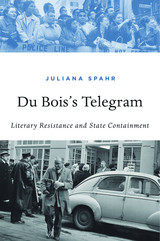 Du Bois’s Telegram: Literary Resistance and State Containment
Juliana Spahr
Harvard University Press, 2018 In 1956 W. E. B. Du Bois was denied a passport to attend the Présence Africaine Congress of Black Writers and Artists in Paris. So he sent the assembled a telegram. “Any Negro-American who travels abroad today must either not discuss race conditions in the United States or say the sort of thing which our State Department wishes the world to believe.” Taking seriously Du Bois’s allegation, Juliana Spahr breathes new life into age-old questions as she explores how state interests have shaped U.S. literature. What is the relationship between literature and politics? Can writing be revolutionary? Can art be autonomous, or is escape from nations and nationalisms impossible?
Du Bois’s Telegram brings together a wide range of institutional forces implicated in literary production, paying special attention to three eras of writing that sought to defy political orthodoxies by contesting linguistic conventions: avant-garde modernism of the early twentieth century; social-movement writing of the 1960s and 1970s; and, in the twenty-first century, the profusion of English-language works incorporating languages other than English. Spahr shows how these literatures attempted to assert their autonomy, only to be shut down by FBI harassment or coopted by CIA and State Department propagandists. Liberal state allies such as the Ford and Rockefeller foundations made writers complicit by funding multiculturalist works that celebrated diversity and assimilation while starving radical anti-imperial, anti-racist, anti-capitalist efforts.
Spahr does not deny the exhilarations of politically engaged art. But her study affirms a sobering reality: aesthetic resistance is easily domesticated.
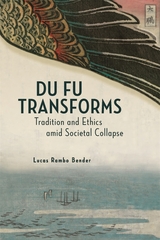 Du Fu Transforms: Tradition and Ethics amid Societal Collapse
Lucas Rambo Bender
Harvard University Press, 2021 Often considered China’s greatest poet, Du Fu (712–770) came of age at the height of the Tang dynasty, in an era marked by confidence that the accumulated wisdom of the precedent cultural tradition would guarantee civilization’s continued stability and prosperity. When his society collapsed into civil war in 755, however, he began to question contemporary assumptions about the role that tradition should play in making sense of experience and defining human flourishing.
In this book, Lucas Bender argues that Du Fu’s reconsideration of the nature and importance of tradition has played a pivotal role in the transformation of Chinese poetic understanding over the last millennium. In reimagining his relationship to tradition, Du Fu anticipated important philosophical transitions from the late-medieval into the early-modern period and laid the template for a new and perduring paradigm of poetry’s relationship to ethics. He also looked forward to the transformations his own poetry would undergo as it was elevated to the pinnacle of the Chinese poetic pantheon.
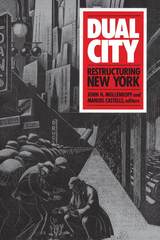 Dual City: Restructuring New York
John H. Mollenkopf
Russell Sage Foundation, 1991 Have the last two decades produced a New York composed of two separate and unequal cities? As the contributors to Dual City reveal, the complexity of inequality in New York defies simple distinctions between black and white, the Yuppies and the homeless. The city's changing economic structure has intersected with an increasingly diversified population, providing upward mobility for some groups while isolating others. As race, gender, ethnicity, and class become ever more critical components of the postindustrial city, the New York experience illuminates not just one great city, or indeed all large cities, but the forces affecting most of the globe. "The authors constitute an impressive assemblage of seasoned scholars, representing a wide array of pertinent disciplines. Their product is a pioneering volume in the social sciences and urban studies...the 20-page bibliography is a major research tool on its own." —Choice
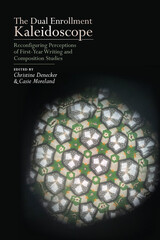 The Dual Enrollment Kaleidoscope: Reconfiguring Perceptions of First-Year Writing and Composition Studies
Christine Denecker
Utah State University Press, 2022 The Dual Enrollment Kaleidoscope serves as a starting point for elevating the voices of those who do dual enrollment (DE) work—those who historicize, legitimize, scrutinize, critically analyze, align, and assess it—pushing readers beyond unique, singular views of DE first-year composition and positioning DE’s impact on composition instruction as one that shifts dependent upon perspective. Just as kaleidoscopes reconfigure images, DE provides writing studies with reflecting images of what FYC was, is, and could be.
DE disrupts long-held beliefs of who should take and who should teach college writing. Giving higher education pause about the place of writing instruction within the academy, DE force those in the field to reflect upon the purposes and value of FYC and its pedagogical approaches. Featuring seventeen chapters written by a wide and diverse range of authors, this collection includes the voices of prominent scholars in rhetoric and composition at two- and four-year public and private institutions, as well as emerging scholars in the field. It also features a variety of methodologies, including archival research, quantitative and qualitative data collection, and autoethnography.
Few texts have been published on dual enrollment writing in rhetoric and composition studies. The Dual Enrollment Kaleidoscope should be mandatory reading for anyone interested in or tasked with doing the work of DE writing instruction, administration, mentoring, or assessment.
Contributors: Dominic Ashby, Anna Bogen, Tyler Branson, Melanie Burdick, Scott Campbell, Christine R. Farris, David Gehler, Leigh Graziano, Jane Greer, Jennifer Hadley, Jacquelyn Hoermann-Elliott, Joseph Jones, Nancy Knowles, Amy Lueck, Miles McCrimmon, Katie McWain, Annie S. Mendenhall, Keith Miller, Brice Nordquist, Cornelia Paraskevas, Jill Parrot, Shirley K Rose, Barbara Schneider, Erin Scott-Stewart
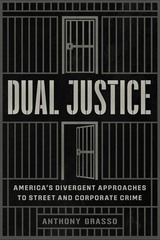 Dual Justice: America’s Divergent Approaches to Street and Corporate Crime
Anthony Grasso
University of Chicago Press, 2024 A far-reaching examination of how America came to treat street and corporate crime so differently. While America incarcerates its most marginalized citizens at an unparalleled rate, the nation has never developed the capacity to consistently prosecute corporate wrongdoing. Dual Justice unearths the intertwined histories of these two phenomena and reveals that they constitute more than just modern hypocrisy. By examining the carceral and regulatory states’ evolutions from 1870 through today, Anthony Grasso shows that America’s divergent approaches to street and corporate crime share common, self-reinforcing origins. During the Progressive Era, scholars and lawmakers championed naturalized theories of human difference to justify instituting punitive measures for poor offenders and regulatory controls for corporate lawbreakers. These ideas laid the foundation for dual justice systems: criminal justice institutions harshly governing street crime and regulatory institutions governing corporate misconduct. Since then, criminal justice and regulatory institutions have developed in tandem to reinforce politically constructed understandings about who counts as a criminal. Grasso analyzes the intellectual history, policy debates, and state and federal institutional reforms that consolidated these ideas, along with their racial and class biases, into America’s legal system.
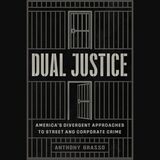 Dual Justice: America's Divergent Approaches to Street and Corporate Crime
Anthony Grasso
University of Chicago Press, 2024 This is an auto-narrated audiobook version of this book.
A far-reaching examination of how America came to treat street and corporate crime so differently. While America incarcerates its most marginalized citizens at an unparalleled rate, the nation has never developed the capacity to consistently prosecute corporate wrongdoing. Dual Justice unearths the intertwined histories of these two phenomena and reveals that they constitute more than just modern hypocrisy. By examining the carceral and regulatory states’ evolutions from 1870 through today, Anthony Grasso shows that America’s divergent approaches to street and corporate crime share common, self-reinforcing origins. During the Progressive Era, scholars and lawmakers championed naturalized theories of human difference to justify instituting punitive measures for poor offenders and regulatory controls for corporate lawbreakers. These ideas laid the foundation for dual justice systems: criminal justice institutions harshly governing street crime and regulatory institutions governing corporate misconduct. Since then, criminal justice and regulatory institutions have developed in tandem to reinforce politically constructed understandings about who counts as a criminal. Grasso analyzes the intellectual history, policy debates, and state and federal institutional reforms that consolidated these ideas, along with their racial and class biases, into America’s legal system.
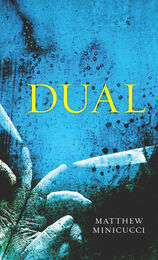 Dual: Poems
Matthew Minicucci
Acre Books, 2023 A poetry collection examining masculinity, aggression, and violence.
In his fourth poetry collection, Matthew Minicucci examines masculinity and gun violence as he brings to life the grammatical concept of the dual, a number that is neither singular nor plural. Though now lost in English, the concept is present in other languages both extant and ancient. The poems’ forms fittingly include the elegy, palinode, and contrapuntal, which is both a single poem and two poems intertwined. They align contemporary moments with key texts from Western literature, including ancient Greek epics, in a way that helps us reconsider the aggression of young men. “The world kills kind boys,” Minicucci writes, and “we bury the bodies inside men.”
Minicucci recategorizes our idea of “West,” the Western canon, and the Old West and its bullets, comparing them to modern-day landscapes in Utah, Oregon, Washington, California, and Hawai’i. Whether memorializing a woodworking grandfather or poets Brigit Pegeen Kelly and James Longenbach, Dual notes that loss has a double vision. While weighty in their subjects, Dual’s poems make room for unexpected moments of lightness, such as when the speaker compares the complications of love to “reading the Iliad and realizing, sure, there's anger, // but before that there’s just a lot of camping.”
The book argues, in the end, that there is an unalienable dual between the observer and the observed, the self and the self as confessed to another.
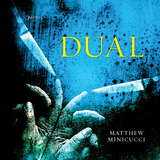 Dual: Poems
Matthew Minicucci
Acre Books, 2023 A poetry collection examining masculinity, aggression, and violence.
In his fourth poetry collection, Matthew Minicucci examines masculinity and gun violence as he brings to life the grammatical concept of the dual, a number that is neither singular nor plural. Though now lost in English, the concept is present in other languages both extant and ancient. The poems’ forms fittingly include the elegy, palinode, and contrapuntal, which is both a single poem and two poems intertwined. They align contemporary moments with key texts from Western literature, including ancient Greek epics, in a way that helps us reconsider the aggression of young men. “The world kills kind boys,” Minicucci writes, and “we bury the bodies inside men.”
Minicucci recategorizes our idea of “West,” the Western canon, and the Old West and its bullets, comparing them to modern-day landscapes in Utah, Oregon, Washington, California, and Hawai’i. Whether memorializing a woodworking grandfather or poets Brigit Pegeen Kelly and James Longenbach, Dual notes that loss has a double vision. While weighty in their subjects, Dual’s poems make room for unexpected moments of lightness, such as when the speaker compares the complications of love to “reading the Iliad and realizing, sure, there's anger, // but before that there’s just a lot of camping.”
The book argues, in the end, that there is an unalienable dual between the observer and the observed, the self and the self as confessed to another.
Dub: Finding Ceremony
Alexis Pauline Gumbs
Duke University Press, 2019 The concluding volume in a poetic trilogy, Alexis Pauline Gumbs's Dub: Finding Ceremony takes inspiration from theorist Sylvia Wynter, dub poetry, and ocean life to offer a catalog of possible methods for remembering, healing, listening, and living otherwise. In these prose poems, Gumbs channels the voices of her ancestors, including whales, coral, and oceanic bacteria, to tell stories of diaspora, indigeneity, migration, blackness, genius, mothering, grief, and harm. Tracing the origins of colonialism, genocide, and slavery as they converge in Black feminist practice, Gumbs explores the potential for the poetic and narrative undoing of the knowledge that underpins the concept of Western humanity. Throughout, she reminds us that dominant modes of being human and the oppression those modes create can be challenged, and that it is possible to make ourselves and our planet anew.
 Dubai, the City as Corporation
Ahmed Kanna
University of Minnesota Press, 2010 Somewhere in the course of the late twentieth century, Dubai became more than itself. The city was, suddenly, a postmodern urban spectacle rising from the desert—precisely the glittering global consumer utopia imagined by Dubai’s rulers and merchant elite. In Dubai, the City as Corporation, Ahmed Kanna looks behind this seductive vision to reveal the role of cultural and political forces in shaping both the image and the reality of Dubai.
Exposing local struggles over power and meaning in the making and representation of Dubai, Kanna examines the core questions of what gets built and for whom. His work, unique in its view of the interconnectedness of cultural identity, the built environment, and politics, offers an instructive picture of how different factions—from local and non-Arab residents and expatriate South Asians to the cultural and economic elites of the city—have all participated in the creation and marketing of Dubai. The result is an unparalleled account of the ways in which the built environment shapes and is shaped by the experience of globalization and neoliberalism in a diverse, multinational city.
 Dubious Alliance: The Making of Minnesota’s DFL Party
John Earl Haynes
University of Minnesota Press, 1984 Dubious Alliance was first published in 1984. Minnesota Archive Editions uses digital technology to make long-unavailable books once again accessible, and are published unaltered from the original University of Minnesota Press editions. The formation of the Democratic-Farmer-Labor party of Minnesota took place in a context of intense factional struggle that lasted from the death of Governor Floyd B. Olson in 1936 to the election of Hubert Humphrey to the U.S. Senate in 1948. Dubious Alliance, the first full account of this critical chapter in the state's political history, has wider significance not only because many of the leading figures in the story have played a role in national politics, but also because it deals with issues—chief among them, the origins of Cold War liberalism— that matter far beyond the boundaries of a single state. John Haynes follows the struggle from its inception to the postwar battle within the new DFL between Popular Front adherents and anti-Communist liberals led by Minneapolis Mayor Hubert Humphrey. He makes clear that the struggle with the Popular Front was the formative political experience of Humphrey's generation; those who fought with him, and who became active in national politics—Orville Freeman, Eugene McCarthy, Walter Mondale, Donald Fraser—did not seriously question Cold War foreign policy till well into the Vietnam era. Thorough and dispassionate, this book will help today's readers better understand the DFL's birth and the struggle that surrounded it—complex events long obscured by Cold War fears and political myth-making. John Earl Haynes is a historian by training—he earned his Ph.D. at the University of Minnesota—and also a specialist in tax policy. He was an adviser to Governor Wendell Anderson and later served as a congressional aide to Anderson and to Representative Martin Sabo. Haynes is now Director of Tax and Credit Analysis for the state of Minnesota.
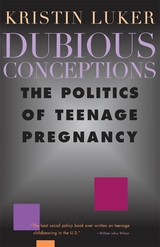 Dubious Conceptions: The Politics of Teenage Pregnancy
Kristin Luker
Harvard University Press, 1996 As her little boy plays at a day care center across the street, Michelle, an unmarried teenager, is in algebra class, hoping to be the first member of her family to graduate from high school. Will motherhood make this young woman poorer? Will it make the United States poorer as a nation? That's what the voices raised against "babies having babies" would have us think, and what many Americans seem inclined to believe. This powerful book takes us behind the stereotypes, the inflamed rhetoric, and the flip media sound bites to show us the complex reality and troubling truths of teenage mothers in America today.
Would it surprise you to learn that Michelle is more likely to be white than African American? That she is most likely eighteen or nineteen--a legal adult? That teenage mothers are no more common today than in 1900? That two-thirds of them have been impregnated by men older than twenty? Kristin Luker, author of the acclaimed Abortion and the Politics of Motherhood, puts to rest once and for all some very popular misconceptions about unwed mothers from colonial times to the present. She traces the way popular attitudes came to demonize young mothers and examines the profound social and economic changes that have influenced debate on the issue, especially since the 1970s. In the early twentieth century, reformers focused people's attention on the social ills that led unmarried teenagers to become pregnant; today, society has come almost full circle, pinning social ills on sexually irresponsible teens.
Dubious Conceptions introduces us to the young women who are the object of so much opprobrium. In these pages we hear teenage mothers from across the country talk about their lives, their trials, and their attempts to find meaning in motherhood. The book also gives a human face to those who criticize them, and shows us why public anger has settled on one of society's most vulnerable groups. Sensitive to the fears and confusion that fuel this anger, and to the troubled future that teenage mothers and their children face, Luker makes very clear what we as a nation risk by not recognizing teenage pregnancy for what it is: a symptom, not a cause, of poverty.
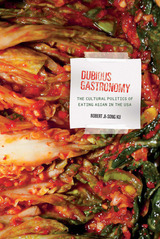 Dubious Gastronomy: The Cultural Politics of Eating Asian in the USA
Robert Ji-Song Ku
University of Hawaii Press, 2014 California roll, Chinese take-out, American-made kimchi, dogmeat, monosodium glutamate, SPAM—all are examples of what Robert Ji-Song Ku calls “dubious” foods. Strongly associated with Asian and Asian American gastronomy, they are commonly understood as ersatz, depraved, or simply bad. In Dubious Gastronomy, Ku contends that these foods share a spiritual fellowship with Asians in the United States in that the Asian presence, be it culinary or corporeal, is often considered watered-down, counterfeit, or debased manifestations of the “real thing.” The American expression of Asianness is defined as doubly inauthentic—as insufficiently Asian and unreliably American when measured against a largely ideological if not entirely political standard of authentic Asia and America. By exploring the other side of what is prescriptively understood as proper Asian gastronomy, Ku suggests that Asian cultural expressions occurring in places such as Los Angeles, Honolulu, New York City, and even Baton Rouge are no less critical to understanding the meaning of Asian food—and, by extension, Asian people—than culinary expressions that took place in Tokyo, Seoul, and Shanghai centuries ago. In critically considering the impure and hybridized with serious and often whimsical intent, Dubious Gastronomy argues that while the notion of cultural authenticity is troubled, troubling, and troublesome, the apocryphal is not necessarily a bad thing: The dubious can be and is often quite delicious.
Dubious Gastronomy overlaps a number of disciplines, including American and Asian American studies, Asian diasporic studies, literary and cultural studies, and the burgeoning field of food studies. More importantly, however, the book fulfills the critical task of amalgamating these areas and putting them in conversation with one another. Written in an engaging and fluid style, it promises to appeal a wide audience of readers who seriously enjoys eating—and reading and thinking about—food.
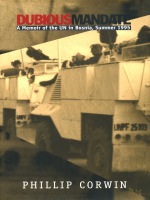 Dubious Mandate: A Memoir of the UN in Bosnia, Summer 1995
Phillip Corwin
Duke University Press, 1999 A critical year in the history of peacekeeping, 1995 saw the dramatic transformation of the role of United Nations’ forces in Bosnia from a protective force to being an active combatant under NATO leadership. Phillip Corwin, the UN’s chief political officer in Sarajevo during the summer of that year, presents an insider’s account of the momentous events that led to that transformation. Dubious Mandate interweaves personal experiences of daily life in a war zone—supply shortages, human suffering, assassination attempts, corruption—with historical facts, as Corwin challenges commonly held views of the war with his own highly informed, discerning, and trenchant political commentary. Sympathetic to the UN’s achievements, yet skeptical of its acquiescence to the use of military force, Corwin is critical both of the Bosnian government’s tactics for drawing NATO into the conflict and of NATO’s eagerness to make peace by waging war. He challenges the popular depiction of the Bosnian government as that of noble victim, arguing that the leaders of all three sides in the conflict were “gangsters wearing coats and ties.” Highly caustic about Western reportage, he examines the policies of various Western political and military leaders and gives a detailed account of a pivotal phase of the war in Bosnia, a period that culminated with NATO’s massive bombing of Bosnian Serb targets and ultimately led to the Dayton Peace Agreement. Without a proper understanding of this critical period, he argues, it is difficult to understand the greater scope of the conflict. Corwin also offers insightful portraits of some of the leading players in the Bosnian drama, including Yasushi Akashi, the UN’s top official in the former Yugoslavia in 1994–95; General Rupert Smith, the British commander in Sarajevo in 1995; and Hasan Muratovic, a future Bosnian prime minister. Capturing the essence of a tense and difficult time, Dubious Mandate will interest diplomats, politicians, military personnel, scholars, and those still trying to fathom the continuing mission of the United Nations and the unfolding of events in the former Yugoslavia during the 1990s.
 Dubious Spectacle: Extremities of Theater, 1976-2000
Herbert Blau
University of Minnesota Press, 2002 Spanning a quarter of a century, the essays in this book rehearse, in the movement of memory and cross-reflection, an extensive career in theater. The work of Herbert Blau-his directing, writing, and criticism-has been a determining force during this period as theater encounters theory. Blau’s struggle to bring a critical intelligence to the American stage goes back half a century, to the quiescent postwar years (which he has eloquently described in The Impossible Theater: A Manifesto). His innovations in performance began with early productions of now-canonical plays that were hardly known at that time (works by Brecht, Beckett, Genet, Pinter, Duerrenmatt, and others). His experience is as distinctive as his versatile habits of mind and conceptual urgency of style. If the impossible takes a little time (as the title of one essay states), Blau’s struggle now continues in a theoretical vein. Performance-and his own compelling writing- has moved across other genres and disciplines into fashion, politics, sexuality, and theory. His diversity of thought is demonstrated here in commentaries about the newer modes of performance (including conceptual and body art), various American playwrights, Renaissance drama, new music and theater, voice, the senses and the baroque, and the photographic image. As the essays reflect upon each other, a kind of cultural history, with inflections of autobiography, develops-which is what readers of Blau’s previous books have come to expect.
 Dublin 1916: The Siege of the GPO
Clair Wills
Harvard University Press, 2009 On Easter Monday 1916, while much of Dublin holidayed at the seaside and placed bets at the horse races, a disciplined group of Irish Volunteers seized the city’s General Post Office in what would become the defining act of rebellion against British rule—and the most significant single event in modern Irish history. By week’s end, the rebels had surrendered, and the siege had left the once magnificent GPO an empty shell—and turned it into the most famous and deeply symbolic building in all of Ireland.
This book unravels the events in and around the GPO during the Easter Rising of 1916. Drawing on participant and eyewitness accounts, diaries, and newspaper reports, Clair Wills recreates the harrowing moments that transformed the GPO from an emblem of nineteenth-century British power and civil government, to an embattled barricade, and finally to a national symbol. What was it like to be trapped in the building? To watch, and listen to, the destruction of the city? Was the act meant as a bloody sacrifice or a military coup d’état? Exploring these questions as they were experienced and understood then and later, her book reveals the twists and turns that the myth of the GPO has undergone in the last century, as it has stood for sacrifice and treachery, national unity and divisive violence, the future and the past.
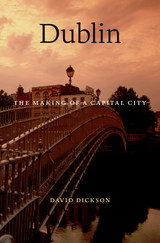 Dublin: The Making of a Capital City
David Dickson
Harvard University Press, 2014 Dublin has experienced great—and often astonishing—change in its 1,400 year history. It has been the largest urban center on a deeply contested island since towns first appeared west of the Irish Sea. There have been other contested cities in the European and Mediterranean world, but almost no European capital city, David Dickson maintains, has seen sharper discontinuities and reversals in its history—and these have left their mark on Dublin and its inhabitants. Dublin occupies a unique place in Irish history and the Irish imagination. To chronicle its vast and varied history is to tell the story of Ireland.
David Dickson’s magisterial history brings Dublin vividly to life beginning with its medieval incarnation and progressing through the neoclassical eighteenth century, when for some it was the “Naples of the North,” to the Easter Rising that convulsed a war-weary city in 1916, to the bloody civil war that followed the handover of power by Britain, to the urban renewal efforts at the end of the millennium. He illuminates the fate of Dubliners through the centuries—clergymen and officials, merchants and land speculators, publishers and writers, and countless others—who have been shaped by, and who have helped to shape, their city. He reassesses 120 years of Anglo-Irish Union, during which Dublin remained a place where rival creeds and politics struggled for supremacy. A book as rich and diverse as its subject, Dublin reveals the intriguing story behind the making of a capital city.
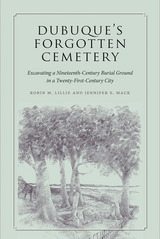 Dubuque's Forgotten Cemetery: Excavating a Nineteenth-Century Burial Ground in a Twenty-first Century City
Robin M. Lillie and Jennifer E. Mack
University of Iowa Press, 2015 Atop a scenic bluff overlooking the Mississippi River and downtown Dubuque there once lay a graveyard dating to the 1830s, the earliest days of American settlement in Iowa. Though many local residents knew the property had once been a Catholic burial ground, they believed the graves had been moved to a new cemetery in the late nineteenth century in response to overcrowding and changing burial customs. But in 2007, when a developer broke ground for a new condominium complex here, the heavy machinery unearthed human bones. Clearly, some of Dubuque’s early settlers still rested there—in fact, more than anyone expected. For the next four years, staff with the Burials Program of the University of Iowa Office of the State Archaeologist excavated the site so that development could proceed.
The excavation fieldwork was just the beginning. Once the digging was done each summer, skeletal biologist Robin M. Lillie and archaeologist Jennifer E. Mack still faced the enormous task of teasing out life histories from fragile bones, disintegrating artifacts, and the decaying wooden coffins the families had chosen for the deceased. Poring over scant documents and sifting through old newspapers, they pieced together the story of the cemetery and its residents, a story often surprising and poignant. Weaving together science, history, and local mythology, the tale of the Third Street Cemetery provides a fascinating glimpse into Dubuque’s early years, the hardships its settlers endured, and the difficulties they did not survive.
While they worked, Lillie and Mack also grappled with the legal and ethical obligations of the living to the dead. These issues are increasingly urgent as more and more of America’s unmarked (and marked) cemeteries are removed in the name of progress. Fans of forensic crime shows and novels will find here a real-world example of what can be learned from the fragments left in time’s wake.
Duchess and Hostage in Renaissance Naples: Letters and Orations
Ippolita Maria Sforza
Iter Press, 2017 This volume presents in translation 100 previously unknown letters of Ippolita Maria Sforza (1445–1488), daughter of the Duke of Milan, who was sent at age twenty to marry the son of the infamously brutal King Ferrante of Naples. Sforza’s letters display the adroit diplomacy she used to strengthen the alliance between Milan and Naples, then the two most powerful states in Italy, amid such grave crises as her brother’s assassination in Milan and the Turkish invasion of Otranto. Still, Ippolita lived as a hostage at the Neapolitan court, subject not only to the threat of foreign invasion but also to her husband’s well-known sexual adventures and her father-in-law’s ruthlessness. Soon after Ippolita’s mysterious death in 1488, the fraught Naples-Milan alliance collapsed.
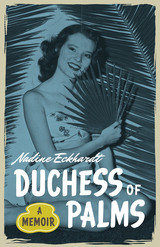 Duchess of Palms: A Memoir
By Nadine Eckhardt
University of Texas Press, 2009 A “fifties girl” tells the fascinating story of her marriages to novelist Billy Lee Brammer and Congressman Bob Eckhardt, and how these relationships propelled her into the multifaceted life she led on her own terms.
Child of the Great Depression, teenage "Duchess of Palms" beauty queen, wife of an acclaimed novelist and later of a brilliant U.S. congressman, and ultimately a successful single working woman and mother, Nadine Eckhardt has lived a fascinating life. In this unique, funny, and honest memoir, she recounts her journey from being a "fifties girl" who lived through the men in her life to becoming a woman in her own right, working toward her own goals. Eckhardt's first marriage to writer Billy Lee Brammer gave her entrée to liberal political and literary circles in Austin and Washington, where she and Brammer both worked for Senator Lyndon B. Johnson. She describes the heady excitement of LBJ's world—a milieu that Brammer vividly captured in his novel The Gay Place. She next recalls her second marriage to Bob Eckhardt, whom she helped get elected to the U.S. House of Representatives, as well as her growing involvement with the counterculture of social protest, sexual revolution, and drug use. Eckhardt honestly recounts how the changing times changed her perception of herself, recalling that "I didn't know how to achieve for myself, only for others, and I felt ripped off and empty." This painful realization opened the door to a new life for Eckhardt. Her memoir concludes with a joyful description of her multifaceted later life as a restaurateur, assistant to Molly Ivins, writer, and center of a wide circle of friends.
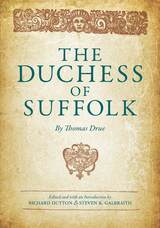 The Duchess of Suffolk
Thomas Drue. Edited and with an Introduction by Richard Dutton and Steven K. Galbraith
Ohio State University Press, 2015 With the inaugural edition of the Early Modern Drama Texts series, Richard Dutton and Steven K. Galbraith illuminate the only surviving work of playwright and actor Thomas Drue. First performed by the Palsgrave’s Men at the Fortune Theater in 1624, The Duchess of Suffolk dramatizes the exile of Protestant noblewoman Katherine Willoughby (1519–80) during the reign of Catholic Queen Mary I (1516–58). Drawing from popular accounts in works by John Foxe and Thomas Deloney, Drue created a narrative of exaggerated peril, as the Duchess and her companions are chased across the continent. The embellished history evokes many iconic figures of the Reformation, from the celebrated Oxford Martyrs Hugh Latimer, Thomas Cranmer, and Nicholas Ridley to Bishop Edmund Bonner, whose infamous reputation had earned him the soubriqet “bloody Bonner.” A tragicomic history, The Duchess of Suffolk still resonated when it was written and performed in early seventeenth-century England some seventy years later.
With this volume, Dutton and Galbraith provide a critical apparatus that situates The Duchess of Suffolk in historical context and suggests an explanation for its continued resonance. They account for the play’s censorship in 1624 by detailing how it evoked contemporary parallels to the controversial foreign policy of King James I. More specifically, the editors offer an introduction that includes a historical overview of the author, staging, printing, and reception. Facing facsimiles of the original are pages with the updated text, complete with annotations to clarify language and staging details. This edition of The Duchess of Suffolk will have something to offer to early modern drama scholars as well as scholars of book history.
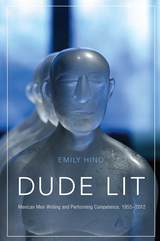 Dude Lit: Mexican Men Writing and Performing Competence, 1955–2012
Emily Hind
University of Arizona Press, 2019 How did men become the stars of the Mexican intellectual scene? Dude Lit examines the tricks of the trade and reveals that sometimes literary genius rests on privileges that men extend one another and that women permit.
The makings of the “best” writers have to do with superficial aspects, like conformist wardrobes and unsmiling expressions, and more complex techniques, such as friendship networks, prizewinners who become judges, dropouts who become teachers, and the key tactic of being allowed to shift roles from rule maker (the civilizado) to rule breaker (the bárbaro). Certain writing habits also predict success, with the “high and hard” category reserved for men’s writing and even film directing. In both film and literature, critically respected artwork by men tends to rely on obscenity interpreted as originality, negative topics viewed as serious, and coolly inarticulate narratives about bullying understood as maximum literary achievement.
To build the case regarding “rebellion as conformity,” Dude Lit contemplates a wide set of examples while always returning to three figures, each born some two decades apart from the immediate predecessor: Juan Rulfo (with Pedro Páramo), José Emilio Pacheco (with Las batallas en el desierto), and Guillermo Fadanelli (with Mis mujeres muertas, as well as the range of his publications). Why do we believe Mexican men are competent performers of the role of intellectual? Dude Lit answers this question through a creative intersection of sources. Drawing on interviews, archival materials, and critical readings, this provocative book changes the conversation on literature and gendered performance.
Due East: A Novel
Valerie Sayers
Northwestern University Press, 2013 Mary Faith Rapple is smart, pretty in a rangy, gray-eyed sort of way—and very definitely pregnant. Not an unusual occurrence in the sleepy town of Due East, South Carolina. But when Mary faith announces that she will have a virgin birth and her father, Jesse Rapple, owner of the Plaid King filling station, vows to uncover the truth, the sparks begin to fly. Spirited, evocative, and utterly delightful, this brilliant novel by Valerie Sayers explores the love and loneliness, the hopes and fears, the unspoken yearnings of the human heart. Due East is a sweet and tender novel. Like Carson McCullers and Flannery O’Connor, Sayers writers with compassion of lonely characters whose lives are slightly off center, and her best scenes have a fine sense, sharp edge of irony. Her chosen territory is the human heart.
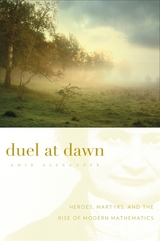 Duel at Dawn: Heroes, Martyrs, and the Rise of Modern Mathematics
Amir Alexander
Harvard University Press, 2011 In the fog of a Paris dawn in 1832, Évariste Galois, the 20-year-old founder of modern algebra, was shot and killed in a duel. That gunshot, suggests Amir Alexander, marked the end of one era in mathematics and the beginning of another.Arguing that not even the purest mathematics can be separated from its cultural background, Alexander shows how popular stories about mathematicians are really morality tales about their craft as it relates to the world. In the eighteenth century, Alexander says, mathematicians were idealized as child-like, eternally curious, and uniquely suited to reveal the hidden harmonies of the world. But in the nineteenth century, brilliant mathematicians like Galois became Romantic heroes like poets, artists, and musicians. The ideal mathematician was now an alienated loner, driven to despondency by an uncomprehending world. A field that had been focused on the natural world now sought to create its own reality. Higher mathematics became a world unto itself—pure and governed solely by the laws of reason.In this strikingly original book that takes us from Paris to St. Petersburg, Norway to Transylvania, Alexander introduces us to national heroes and outcasts, innocents, swindlers, and martyrs–all uncommonly gifted creators of modern mathematics.
 Duels
Néhémy Dahomey
Seagull Books, 2025 A gripping tale of education, violence, and hope, in which one man's dream for a better future collides with a community on the edge of transformation.
Set in 1842, this novel foregrounds a Haiti that is grappling with the weight of an onerous debt imposed by France, forcing its citizens to pay reparations to French colonists in exchange for diplomatic recognition of the first Black republic of the Americas. In the town of Boën, a prosperous notary, Ludovic Possible, decides to take a bold step to secure the future of his community. He opens a schoolhouse where local children can learn both artisanal skills and the essential ability to read and write. For Ludovic, education represents the best chance for the people of Boën to rise above their hardships and build a prosperous future—especially for Aïda, a quiet and enigmatic girl whose mother’s marvelous stories captivate him.
The tranquility of Boën is soon shattered, however, by a series of duels that pit families, neighbors, and even animals against each other. As tensions rise, Ludovic’s vision for a better future is threatened by the escalating violence. In Duels, Néhémy Pierre-Dahomey introduces readers to a rich and unforgettable cast of characters—Aïda, Ludovic, Balthazar Possible, Pépé the Tempest, and many others—who find themselves at the crossroads of a nation on the brink of transformative change.
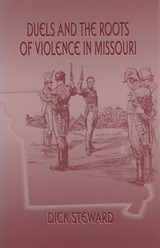 Duels and the Roots of Violence in Missouri
Dick Steward
University of Missouri Press, 2000
In early-nineteenth-century Missouri, the duel was a rite of passage for many young gentlemen seeking prestige and power. In time, however, other social groups, influenced by the ruling class, engaged in a variety of violent acts and symbolic challenges under the rubric of the code duello. In Duels and the Roots of Violence in Missouri, Dick Steward takes an in-depth look at the evolution of dueling, tracing the origins, course, consequences, and ultimate demise of one of the most deadly art forms in Missouri history. By focusing on the history of dueling in Missouri, Steward details an important part of our culture and the long-reaching impact this form of violence has had on our society.
Drawing upon accounts of at least a hundred duels—from little-known encounters to those involving celebrated figures such as Senator Thomas Hart Benton, Charles Lucas, Thomas Biddle, Spencer Pettis, and John Smith T—Steward shows how the roots of violence have penetrated our modern culture. He traces the social and cultural changes in the nature of the duel from its earliest form as a defense of honor to its use as a means of revenge. By the latter part of the nineteenth century, the formal southern duel had for the most part given way to the improvised western duel, better known as the gunfight. Involving such gunslingers as Wild Bill Hickok and Jesse James, these violent acts captivated people not only in the state but also across the nation. Although the violence entailed different methods of killing, its allure remained as strong as ever.
Steward re-creates the human drama and tragedy in many of these hostile encounters, revealing how different groups operating under the code duello justified family and clan feuds, vigilante justice, and revenge killings. This often-glamorized violence, Steward argues, was viewed as a symbol of honor and courage throughout the century and greatly influenced behavior and attitudes toward violence well into the twentieth century.
While this work centers mainly on Missouri and the history of dueling in the state, its inferences extend well past the region itself. Well-written and thoroughly researched, Duels and the Roots of Violence in Missouri provides valuable insight into the violent social climate of yesterday.
 Duffy Daugherty: A Man Ahead of His Time
David Claerbaut
Michigan State University Press, 2018 This is the story of Duffy Daugherty—humorist, trailblazer, raconteur, and Hall of Fame football coach—arguably the most famous figure in the storied history of Michigan State University football. Daugherty’s nineteen-year tenure at MSU was marked by great success. Between 1955 and 1966, eight Spartan teams finished in the Associated Press top ten college football teams. Daugherty was a character. With his zany wit putting him in demand as a public speaker, Daugherty became so well known for his winning teams and quotable comments that he adorned the cover of the October 8, 1956, issue of Time magazine. Daugherty was a major figure in bringing African American athletes into the mainstream of college sports. From his arrival at MSU, he worked to field integrated teams. His undefeated 1966 powerhouse squad—one that played Notre Dame to an unforgettable 10–10 tie in the season finale—included four black players selected among the first eight players taken in the NFL draft. MSU memorialized Daugherty by naming the football team’s practice facility the Duffy Daugherty Football Building in his honor.
Duffy's Iowa Caucus Cartoons: Watch 'Em Run
Brian Duffy
University of Iowa Press, 2015 Brian Duffy has been poking fun at the Iowa caucuses for just about as long as they’ve been a media circus, since the 1970s. Now, the longtime editorial cartoonist has gathered a selection of his best images lampooning the politicians on their quadrennial stampedes through Iowa’s fields and towns.
Whether you’re anticipating or dreading the onset of another caucus season in 2016, this book will put it all into perspective. From Jimmy Carter’s innovative 1976 effort to Barack Obama’s come-from-behind win in 2008, from George H. W. Bush’s storming to victory in 1980 to George W. Bush’s coasting to his win in 2000, from Gary Hart’s peccadillos in 1988 to John Edwards’s missteps in 2008, from Elizabeth Dole’s determination to breach the White House boys’ club in 2000 to Hillary Clinton’s fall from frontrunner to third place in 2008, here is American presidential campaigning in all its glory. With pigs.
Duino Elegies: A Bilingual Edition
Rainer Maria Rilke
Northwestern University Press, 1998 The Duino Elegies are the culmination of the development of Rilke's poetry. A summary of his spiritual troubles, perhaps no volume of poems in a European language has made so dramatic and sustained an impact on English-speaking readers in this century.
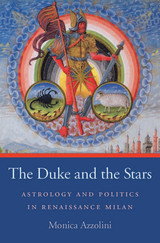 The Duke and the Stars: Astrology and Politics in Renaissance Milan
Monica Azzolini
Harvard University Press, 2012 This study is the first to examine the important political role played by astrology in Italian court culture. Reconstructing the powerful dynamics existing between astrologers and their prospective or existing patrons, The Duke and the Stars illustrates how the “predictive art” of astrology was a critical source of information for Italian Renaissance rulers, particularly in times of crisis. Astrological “intelligence” was often treated as sensitive, and astrologers and astrologer-physicians were often trusted with intimate secrets and delicate tasks that required profound knowledge not only of astrology but also of the political and personal situation of their clients. Two types of astrological predictions, medical and political, were taken into the most serious consideration. Focusing on Milan, Monica Azzolini describes the various ways in which the Sforza dukes (and Italian rulers more broadly) used astrology as a political and dynastic tool, guiding them as they contracted alliances, made political decisions, waged war, planned weddings, and navigated health crises.
The Duke and the Stars explores science and medicine as studied and practiced in fifteenth-century Italy, including how astrology was taught in relation to astronomy.
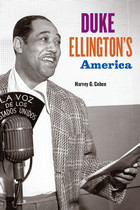 Duke Ellington's America
Harvey G. Cohen
University of Chicago Press, 2010 Few American artists in any medium have enjoyed the international and lasting cultural impact of Duke Ellington. From jazz standards such as “Mood Indigo” and “Don’t Get Around Much Anymore,” to his longer, more orchestral suites, to his leadership of the stellar big band he toured and performed with for decades after most big bands folded, Ellington represented a singular, pathbreaking force in music over the course of a half-century. At the same time, as one of the most prominent black public figures in history, Ellington demonstrated leadership on questions of civil rights, equality, and America’s role in the world.
With Duke Ellington’s America, Harvey G. Cohen paints a vivid picture of Ellington’s life and times, taking him from his youth in the black middle class enclave of Washington, D.C., to the heights of worldwide acclaim. Mining extensive archives, many never before available, plus new interviews with Ellington’s friends, family, band members, and business associates, Cohen illuminates his constantly evolving approach to composition, performance, and the music business—as well as issues of race, equality and religion. Ellington’s own voice, meanwhile, animates the book throughout, giving Duke Ellington’s America an intimacy and immediacy unmatched by any previous account.
By far the most thorough and nuanced portrait yet of this towering figure, Duke Ellington’s America highlights Ellington’s importance as a figure in American history as well as in American music.
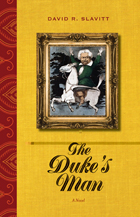 The Duke's Man: A Novel
David R. Slavitt
Northwestern University Press, 2011 Historical fiction has long ranked somewhere just above romance novels and mysteries in the great chain of literary respectability, yet as David Slavitt points out in his humorous yet loving send-up of the genre, riches might be found in the most unlikely sources. The Duke’s Man is, in a way, old and new—a condensation and commentary and a literary mash-up. The eponymous character is Louis de Clermont, Comte de Bussy d’Amboise, a gentleman of the court of King Henri III of France, and the hero of Dumas’ three-volume historical novel La Dame de Monsoreau (1846). Dumas’ novel serves here as inspiration, pre-text, and pretext for a commentary that veers off into numerous historical and biographical digressions, musings on narrative and the novel, and parody.
Focusing on one aspect of Dumas’ novel—the doomed love story of Bussy d’Amboise and Diana de Monsoreau—Slavitt excerpts key passages, which are extended and undercut by the narrator’s comments. The result is a radically abridged book with its own life and verve. The first of the quoted scenes, in which the names of Bussy’s assailants are replaced with those of French cheeses, sets the irreverent tone for all that follows. The book pokes fun at Dumas’ exclamatory style and flamboyant archaisms (“morbleu!” “pardieu!”), the implausibility of the swordfights, the unnecessary contortions of the political plot, the conventional passivity of the heroine, and the coyness of his love scenes. Residing somewhere between Nabokov’s Pale Fire and Quirk Books’ mash-ups (Pride and Prejudice and Zombies, etc.), The Duke’s Man’s blend of quotation, commentary, and fiction raises searching questions about realism and truth.
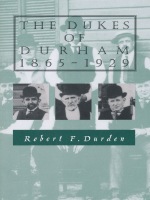 The Dukes of Durham, 1865-1929
Robert F. Durden
Duke University Press, 1987 This is the history of Washington Duke and two of his sons, Benjamin Newton Duke and James Buchanan Duke. Although numerous other members of the family play their parts in the story it focuses primarily on the three men who were at the center of the economic and philanthropic activities which made the Dukes of Durham one of America's famous families. The Dukes operated closely and constantly as a family, and only in that context is their full story told. In the years after the Civil War, Washington Duke proved to be an unusually able industrialist and a conscientious, Methodist philanthropist. He was, in fact, a major Southern pioneer in both industry and philanthropy. His two sons by a second marriage were remarkably devoted to each other as well as to their father. Both sons also reflected traits of thier father. While Benjamin N. Duke and James B. Duke had life-long involvement with the business world—first in tobacco, then textiles, and finally electric power—as well as with philanthropy, they actually developed complementary specializations. Benjamin N. Duke, the older of the two, served as the family's primary agent for philanthropy from his early manhood in the late 1800's until he gradually became semi-invalid after 1915. James B. Duke, on the other hand, early displayed a marked talent, even a genius, for business. Toward the end of his life, with the establishment of The Duke Endowment late in 1924, he emerged as one of the nation's major philanthropists, ranking alongside Andrew Carnegie and John D. Rockefeller. A central theme of this book is, however, that the Endowment, despite its magnitude and far-reaching scope, was essentially the institutionalization and culmination of a pattern of family philanthropy that emerged in the 1890's and for which the older brother, Benjamin N. Duke, had always been the primary agent. Thus, the story of James B. Duke, who was and has remained much the more well-known of the two brothers, cannot properly be told out of the family context from which he emerged and in which occurred most of the important phases of his life. Washington Duke, as a small, land-owning yeoman farmer, was typical of the great majority class not only in antebellum North Carolina but in the South as a whole. Only after the war, when he and his sons emerged as large-scale industrialists and philanthropists, did the Dukes become atypical. Their story is, then, both agricultural and industrial, both Southern and national. Born North Carolinians, they moved onto a national, even global, stage. Yet all the while they kept deep roots, as well as vast investments of capital, in the Old North State, and they poured many millions into philanthropy, largely in the two Carolinas. Based largely on manuscript sources, many of them hitherto unused, this is the first study of the Duke family. The "New South," as recent historians have told us, may not have been so new—but it was certainly different in important ways, and the Dukes loomed large among those who helped to make it so.
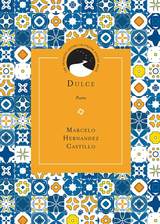 Dulce: Poems
Marcelo Hernandez Castillo
Northwestern University Press, 2018 The poems in Dulce are at once confession and elegy that admit the speaker’s attempt and possible failure to reconcile intimacy toward another and toward the self. The collection asks: what’s the point in any of this?—meaning, what’s the use of longing beyond pleasure; what’s the use of looking for an origin if we already know the ending?
Surreal and deeply imagistic, the poems map a parallel between the landscape of the border and the landscape of sexuality. Marcelo Hernandez Castillo invites the reader to confront and challenge the distinctions of borders and categories, and in doing so, he obscures and negates such divisions. He allows for the possibility of an and in a world of either/or.
These poems enact a prescient anxiety of what is to come, “I want to say all of this is true / but we both know it isn’t. . . . We already know what’s at the other end of this.” Dulce is truly a lyrical force rife with the rich language of longing and regret that disturbs even the most serene quiet.
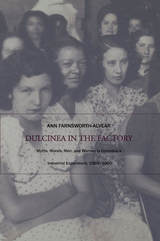 Dulcinea in the Factory: Myths, Morals, Men, and Women in Colombia’s Industrial Experiment, 1905–1960
Ann Farnsworth-Alvear
Duke University Press, 2000 Before it became the center of Latin American drug trafficking, the Colombian city of Medellín was famous as a success story of industrialization, a place where protectionist tariffs had created a “capitalist paradise.” By the 1960s, the city’s textile industrialists were presenting themselves as the architects of a social stability that rested on Catholic piety and strict sexual norms. Dulcinea in the Factory explores the boundaries of this paternalistic order by investigating workers’ strategies of conformity and resistance and by tracing the disciplinary practices of managers during the period from the turn of the century to a massive reorganization of the mills in the late 1950s. Ann Farnsworth-Alvear’s analyses of archived personnel records, internal factory correspondence, printed regulations, and company magazines are combined with illuminating interviews with retired workers to allow a detailed reconstruction of the world behind the mill gate. In a place where the distinction between virgins and nonvirgins organized the labor market for women, the distance between chaste and unchaste behavior underlay a moral code that shaped working women’s self-perceptions. Farnsworth-Alvear challenges the reader to understand gender not as an opposition between female and male but rather as a normative field, marked by “proper” and “improper” ways of being female or male. Disputing the idea that the shift in the mills’ workforce over several decades from mainly women to almost exclusively men was based solely on economic factors, the author shows how gender and class, as social practices, converged to shape industrial development itself. Innovative in its creative employment of subtle and complex material, Dulcinea in the Factory addresses long-standing debates within labor history about proletarianization and work culture. This book’s focus on Colombia will make it valuable to Latin Americanists, but it will also appeal to a wide readership beyond Latin American and labor studies, including historians and sociologists, as well as students of women’s studies, social movements, and anthropology.
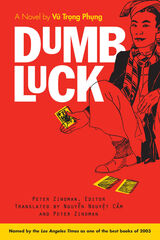 Dumb Luck: A Novel by Vu Trong Phung
Peter Zinoman, Editor
University of Michigan Press, 2002 Banned in Vietnam until 1986, Dumb Luck--by the controversial and influential Vietnamese writer Vu Trong Phung--is a bitter satire of the rage for modernization in Vietnam during the late colonial era. First published in Hanoi during 1936, it follows the absurd and unexpected rise within colonial society of a street-smart vagabond named Red-haired Xuan. As it charts Xuan's fantastic social ascent, the novel provides a panoramic view of late colonial urban social order, from the filthy sidewalks of Hanoi's old commercial quarter to the gaudy mansions of the emergent Francophile northern upper classes. The transformation of traditional Vietnamese class and gender relations triggered by the growth of colonial capitalism represents a major theme of the novel.
Dumb Luck is the first translation of a major work by Vu Trong Phung, arguably the greatest Vietnamese writer of the twentieth century. The novel's clever plot, richly drawn characters and humorous tone and its preoccupation with sex, fashion and capitalism will appeal to a wide audience. It will appeal to students and scholars of Vietnam, comparative literature, colonial and postcolonial studies, and Southeast Asian civilization.
Vu Trong Phung died in Hanoi, in 1939 at the age of twenty-seven. He is the author of at least eight novels, seven plays, and several other works of fiction in addition to Dumb Luck.
Peter Zinoman is Associate Professor of Southeast Asian History, University of California, Berkeley. Nguyen Nguyet Cam is Vietnamese Language Instructor, University of California, Berkeley.
 The Dumbarton Oaks Anthology of Chinese Garden Literature
Alison Hardie
Harvard University Press The Dumbarton Oaks Anthology of Chinese Garden Literature is the first comprehensive collection in English of over two millennia of Chinese writing about gardens and landscape. Its contents range from early poems using plant imagery to represent virtue and vice, through works from many dynasties on both private and imperial gardens, to twentieth-century prose descriptions of the reconstruction of a historic Suzhou garden. Most passages have been translated for this publication. A number of previously published translations, some of which are now hard to find, are also included.
The anthology is divided into nine chapters: five chronological, covering the pre-Qin period to the Qing dynasty; and four thematic, on rocks and flora, the evolution of a single site (Canglang Pavilion in Suzhou), gardens of the mind, and the interplay between garden and landscape as seen through Mount Tai and West Lake. An introductory essay positions Chinese gardens and garden literature in their cultural context. Care has been taken to translate plant names as accurately as possible given the limitations of the sources, and the anthology includes a glossary of translated names, Chinese names, and binomials.
|
|
